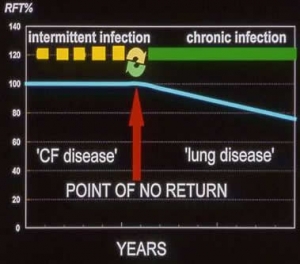VX-770 IVACAFTOR
VX-77O (ivacaftor)
This section contains mostly references to ivacaftor alone; uses in combination with other modulators are dealt with in their own separate sections. Key references are in red
2009 Van Goor F, Hadida S, Grootenhuis PD, Burton B, Cao D, Neuberger T, Turnbull A, Singh A, Joubran J, Hazlewood A, Zhou J, McCartney J, Arumugam V, Decker C, Yang J, Young C, Olson ER, Wine JJ, Frizzell RA, Ashlock M, Negulescu P.Rescue of CF airway epithelial cell function in vitro by a CFTR potentiator, VX-770.Proc Natl Acad Sci U S A. 2009; 106(44):18825-30. Error! Hyperlink reference not valid.Free article available

Frederick van Goor
The authors describe the in vitro pharmacology of VX-770, an orally bioavailable CFTR potentiator in clinical development for the treatment of CF. In recombinant cells VX-770 increased CFTR channel open probability (P(o)) in both the F508del processing mutation and the G551D gating mutation. VX-770 also increased Cl(-) secretion in cultured human CF bronchial epithelia (HBE) carrying the G551D gating mutation on one allele and the F508del processing mutation on the other allele by approximately 10-fold, to approximately 50% of that observed in HBE isolated from individuals without CF. Furthermore, VX-770 reduced excessive Na(+) and fluid absorption to prevent dehydration of the apical surface and increased cilia beating in these epithelial cultures
These results support the hypothesis that pharmacological agents that restore or increase CFTR function can rescue epithelial cell function in human CF airway.
2010
2010 Accurso FJ, Rowe SM, Clancy JP, Boyle MP, Dunitz JM, Durie PR, Sagel SD, Hornick DB, Konstan MW, Donaldson SH, Moss RB, Pilewski JM, Rubenstein RC, Uluer AZ, Aitken ML, Freedman SD, Rose LM, Mayer-Hamblett N, Dong Q, Zha J, Stone AJ, Olson ER, Ordonez CL, Campbell PW, Ashlock MA, Ramsey BW. Effect of VX-770 in persons with cystic fibrosis and the G551D-CFTR mutation. VX-770, a CFTR potentiator, has been shown to increase the activity of wild-type and defective cell-surface CFTR in vitro.New Engl J Med. 2010; 363:1991-2003. Error! Hyperlink reference not valid.

Frank Accurso
39 adults with cystic fibrosis and at least one G551D-CFTR allele received oral VX-770 every 12 hours at a dose of 25, 75, or 150 mg or placebo for 14 days (in part 1 of the study) or VX-770 every 12 hours at a dose of 150 or 250 mg or placebo for 28 days (in part 2 of the study). At day 28, in the group of subjects who received 150 mg of VX-770, the median change in the nasal potential difference (in response to the administration of a chloride-free isoproterenol solution) from baseline was -3. 5 mV (range, -8. 3 to 0. 5; P=0.02 for the within-subject comparison, P=0.13 vs. placebo), and the median change in the level of sweat chloride was -59. 5 mmol per liter (range, -66. 0 to -19. 0; P=0.008 within-subject, P=0.02 vs. placebo). The median change from baseline in the percent of predicted forced expiratory volume in 1 second was 8. 7% (range, 2. 3 to 31. 3; P=0. 008 for the within-subject comparison, P=0. 56 vs. placebo). None of the subjects withdrew from the study. Six severe adverse events occurred in two subjects (diffuse macular rash in one subject and five incidents of elevated blood and urine glucose levels in one subject with diabetes). All severe adverse events resolved without the discontinuation of VX-770.
The authors concluded that this study to evaluate the safety and adverse-event profile of VX-770 showed that VX-770 was associated with within-subject improvements in CFTR and lung function. These findings provide support for further studies of pharmacologic potentiation of CFTR as a means to treat cystic fibrosis.
– The results of this phase II trial of VX-770, confirmed it to be one of the most significant advances up to the present time in increasing CFTR function and with obvious beneficial changes in respiratory function and even normalisation of the abnormal sweat electrolyte levels. Subsequent Phase III trials (below) fully confirmed that this was indeed a major advance for those people with CF who had at least one G551D mutation – in the UK 5.8% of people with CF.
The drug named Kalydeco (generic name ivacaftor, previously known as VX-770) was approved for clinical use in January 2012 in the USA although it is likely that the cost would prove a problem. Suggested annual cost could be $294,000 per year.
2011
2011 Van Goor F, Hadida S, Grootenhuis PD, Burton B, Stack JH, Straley KS, Decker CJ, Miller M, McCartney J, Olson ER, Wine JJ, Frizzell RA, Ashlock M, Negulescu PA. Correction of the F508del-CFTR protein processing defect in vitro by the investigational drug VX-809. Proc Nat Acad Sci USA 2011; 108:18843-84.[PubMed]
The authors describe the in vitro pharmacology of VX-809, a CFTR corrector. In cultured human bronchial epithelial cells isolated from patients with CF homozygous for F508del, VX-809 improved F508del-CFTR processing in the endoplasmic reticulum and enhanced chloride secretion to approximately 14% of non-CF human bronchial epithelial cells, a level associated with mild CF. F508del-CFTR corrected by VX-809 exhibited biochemical and functional characteristics similar to normal CFTR. VX-809 represents a class of CFTR corrector that specifically addresses the underlying processing defect in F508del-CFTR.
– As DF508 is the most frequent CF mutation it is hoped that this corrector will be as therapeutically active as indicated in these studies as it is likely that even 14% of normal CFTR activity will ameliorate the main symptoms associated with complete absent CFTR activity. However, the corrector does not seem to have the same dramatic effect on DF508 as VX-770 has on the G551D mutation. However, the results of VX-770 in patients with the GF551D mutation added great impetus to the small molecule corrector research and there is now major investment in this area by pharmaceutical companies and the CF Foundation.
2011 Ramsey BW, Davies J, McElvaney NG, Tullis E, Bell SC, Drevinek P, Griese M, McKone EF, Wainwright CE, Konstan MW, Moss R, Ratjen F, Sermet Gaudelus I, Rowe SM, Dong Q, Rodriguez S, Yen K, Ordonez C, Elborn JS. VX08-770-102 Study Group. A CFTR potentiator in patients with cystic fibrosis and the G551D mutation. New Engl J Med 2011; 365:1663-72 .[PubMed]Free article available

Bonnie Ramsey
This is the main report of a randomized, double-blind, placebo-controlled trial to evaluate Ivacaftor (VX-770), a CFTR potentiator, in subjects 12 years of age or older with CF and at least one G551D-CFTR mutation. Subjects were randomly assigned to receive 150 mg of ivacaftor every 12 hours (84 subjects, of whom 83 received at least one dose) or placebo (83, of whom 78 received at least one dose) for 48 weeks. The primary end point was the estimated mean change from baseline through week 24 in the percent of predicted forced expiratory volume in 1 second (FEV(1)).
RESULTS: The change from baseline through week 24 in the percent of predicted FEV(1) was greater by 10.6 percentage points in the Ivacaftor group than in the placebo group (P<0.001). Effects on pulmonary function were noted by 2 weeks, and a significant treatment effect was maintained through week 48. Subjects receiving Ivacaftor were 55% less likely to have a pulmonary exacerbation than were patients receiving placebo, through week 48 (P<0.001). In addition, through week 48, subjects in the ivacaftor group scored 8.6 points higher than did subjects in the placebo group on the respiratory-symptoms domain of the Cystic Fibrosis Questionnaire-revised instrument (a 100-point scale, with higher numbers indicating a lower effect of symptoms on the patient’s quality of life) (P<0.001). By 48 weeks, patients treated with Ivacaftor had gained, on average, 2.7 kg more weight than had patients receiving placebo (P<0.001). The change from baseline through week 48 in the concentration of sweat chloride, a measure of CFTR activity, with Ivacaftor as compared with placebo was -48.1 mmol per liter (P<0.001). The incidence of adverse events was similar with ivacaftor and placebo, with a lower proportion of serious adverse events with Ivacaftor than with placebo (24% vs. 42%).
The authors concluded that Ivacaftor was associated with improvements in lung function at 2 weeks that were sustained through 48 weeks. Substantial improvements were also observed in the risk of pulmonary exacerbations, patient-reported respiratory symptoms, weight, and concentration of sweat chloride.
– This is one of the most important papers of recent years, undoubtedly a “megapaper”, and represents the first successful small molecule correction of the effects of a specific CF gene mutation, G551D. It is the first such treatment of the basic defect that has significantly changed the abnormal sweat chloride concentration in addition to favourably influencing the clinical condition of the treated patients.
2012
2012 Yu H, Burton B, Huang CJ, Worley J, Cao D, Johnson JP Jr, Urrutia A, Joubran J, Seepersaud S, Sussky K, Hoffman BJ, Van Goor F. Ivacaftor potentiation of multiple CFTR channels with gating mutations. J Cyst Fibros. 2012;11:237-45. [PubMed]
Ivacaftor potentiated multiple mutant CFTR forms with defects in CFTR channel gating. These included the G551D, G178R, S549N, S549R, G551S, G970R, G1244E, S1251N, S1255P and G1349D CFTR gating mutations. The authors concluded that these in vitro data suggest that ivacaftor has a similar effect on all CFTR forms with gating defects and support investigation of the potential clinical benefit of ivacaftor in CF patients who have CFTR gating mutations beyond G551D.
2013
2013 Davies JC, Wainwright CE, Canny GJ, Chilvers MA, Howenstine MS, Munck A, Mainz JG, Rodriguez S, Li H, Yen K, Ordonez CL, Ahrens R. VX08-770-103 (ENVISION) Study Group. Efficacy and safety of ivacaftor in patients aged 6 to 11 years with cystic fibrosis with a G551D mutation. Am J Resp Crit Care 2013; 187:1219-25. [PubMed]

Jane Davies
Children received oral ivacaftor 150 mg (n = 26) or placebo (n = 26) every 12 hours for 48 weeks. Despite near-normal mean baseline values in FEV1, patients receiving ivacaftor had a significant increase in percent predicted FEV1 from baseline through Week 24 versus placebo group (treatment effect, 12.5 percentage points; P < 0.001). Effects on pulmonary function were evident by 2 weeks, and a significant treatment effect was maintained through Week 48. Patients treated with ivacaftor gained, on average, 2.8 kg more than those receiving placebo at Week 48 (P < 0.001). The change from baseline through Week 48 in the concentration of sweat chloride, a measure of CFTR activity, with ivacaftor was -53.5 mmol/L (P < 0.001) versus placebo. The incidence of adverse events was similar in the two groups.
These quite dramatic results further confirm the very significant benefit from ivacaftor even in those children with a G551D mutation who have normal or near normal respiratory function. The authors concluded that in patients who are younger and healthier than those in previously studied populations, ivacaftor demonstrated a significant improvement in pulmonary function, weight, and CFTR activity compared with placebo.
– These trials reporting the effects of ivacaftor in adults and here in children must surely be the most sensational and important publications that have appeared to date relating to the treatment of CF.
2013 Davies J, Sheridan H, Bell N, Cunningham S, Davis SD, Elborn JS, Milla CE, Starner TD, Weiner DJ, Lee PS, Ratjen F. Assessment of clinical response to ivacaftor with lung clearance index in cystic fibrosis patients with a G551D-CFTR mutation and preserved spirometry: a randomised controlled trial. Lancet Respir Med. 2013 Oct;1(8):630-8. [PubMed]
Lung clearance index (LCI) using multiple-breath washout might be an alternative to and more sensitive method than forced expiratory volume in 1 s (FEV1) to assess treatment response in the growing number of children and young adults with cystic fibrosis who have normal spirometry. The aim of the study was to assess the treatment effects of ivacaftor on LCI in patients with cystic fibrosis, a G551D-CFTR mutation, and an FEV1 >90% predicted
This phase 2, multicentre, placebo-controlled, double-blind 2×2 crossover study of ivacaftor treatment was conducted in patients with cystic fibrosis, at least one G551D-CFTR allele, and an FEV1 >90% predicted. Patients also had to have an LCI higher than 7·4 at screening, age of 6 years or older, and a weight higher than or equal to 15 kg. Eligible patients were randomly allocated to receive one of two treatment sequences (placebo first followed by ivacaftor 150 mg twice daily [sequence 1] or ivacaftor 150 mg twice daily first followed by placebo [sequence 2]) of 28 days’ treatment in each period, with a 28-day washout between the two treatment periods. Randomisation (ratio 1:1) was done with block sizes of 4, and all site personnel including the investigator, the study monitor, and the Vertex study team were masked to treatment assignment. The primary outcome measure was change from baseline in LCI. .
Between February and November, 2011, 21 patients were enrolled., Treatment with ivacaftor led to significant improvements compared with placebo in LCI (difference between groups in the average of mean changes from baseline at days 15 and 29 was -2·16 [95% CI -2·88 to -1·44]; p<0·0001).
– In patients with cystic fibrosis aged 6 years or older who have at least one G551D-CFTR allele, ivacaftor led to improvements in LCI. The authors suggest tha LCI might be a more sensitive alternative to FEV1 in detecting response to intervention in these patients with mild lung disease.
2013 Grasemann H, Ratjen F, Solomon M. Aquagenic wrinkling of the palms in a patient with cystic fibrosis. N Engl J Med. 2013 Dec 12;369(24):2362-3. doi: 10.1056/NEJMc1308349. [PubMed]

Hatmut Grasemann
An 11-year-old patient with cystic fibrosis (CFTR genotype F508del/G551D) who received maintenance therapy with other drugs for cystic fibrosis in addition to ivacaftor. Aquagenic wrinkling of his palms was assessed by putting his left hand into a water bath at 37°C for 5 minutes before treatment and after 1 month of treatment. Although considerable wrinkling was observed at baseline, the phenomenon had resolved after treatment. In parallel, the patient’s sweat chloride concentrations decreased from 90 mmol per liter before treatment to 32 mmol per liter after treatment.
– The authors comment that their findings show that CFTR-directed therapy had an effect on aquagenic wrinkling in a patient with cystic fibrosis and indicate an association of this phenomenon with CFTR dysfunction. Ivacaftor trials have shown considerable variability in treatment response when it is assessed according to the sweat chloride and nasal potential difference, two distinct measures of CFTR function. As new CFTR-directed therapies are being explored, additional measures of CFTR function could help to better capture the individual variability in response. Their observation related to ivacaftor therapy raises the potential that aquagenic wrinkling of the palms could serve as an additional and simple test of CFTR function to monitor the success of drug treatment although this seems unlikely.
2013 Seliger V, Rodman D, Van Goor F, Schmelz A, Mueller P.The predictive potential of the sweat chloride test in cystic fibrosis patients with the G551D mutation. J Cyst Fibros. 2013; 12:706-13. doi: 10.1016/j.jcf.2013.03.004. Epub 2013 Apr 28.[PubMed]
Sweat chloride measurements at day 15 had an overall positive predictive value (PPV) of 86.3%, a negative predictive value (NPV) of 65.5%, sensitivity of 73.9%, and specificity of 80.9% for an FEV1 improvement of ≥5% from baseline at week 16. For ivacaftor patients the median FEV1 improvement was 16.7%; for placebo patients 0.4%. For patients aged 6-11 years who received ivacaftor and who had a sweat chloride decrease of ≥40 mmol/L from baseline at day 15, a median weight gain of 11.2% at week 16, compared to 6% for those with a smaller decrease was observed.
The authors suggest changes in sweat chloride concentration at day 15 following treatment with ivacaftor may have sufficient predictive potential to identify individuals that show improvement in pulmonary function and weight gain after 16 weeks of treatment.
2013 Hebestreit H, Sauer-Heilborn A, Fischer R, Käding M, Mainz JG. Effects of ivacaftor on severely ill patients with cystic fibrosis carrying a G551D mutation. J Cyst Fibros. 2013; 12:599-603. doi: 10.1016/j.jcf.2013.05.006. Epub 2013 Jun 10.[PubMed]
Data from 14 severely affected patients with a FEV1 <40% predicted who received ivacaftor on a “named patient program” basis in Germany were analyzed. One patient took ivacaftor at a lower than recommended dose due to abundant mucus and a feeling to “suffocate.” No additional severe adverse events were reported. One further patient stopped ivacaftor due to lung transplantation, one due to perceived poor effectiveness, one due to pregnancy, and one stopped standard therapy. The remaining patients took ivacaftor regularly and did not change other therapies. FEV1 increased by more than 5% predicted in 5 of the 14 patients from baseline (average FEV1 during the year prior to ivacaftor). On average, FEV1 increased significantly by 5.2±5.6%predicted (p<0.01). The relative improvement in FEV1 was 19.7±22.1%.
– So ivacaftor was effective in many patients with poor lung function. The response was, however, variable. Although the drug appeared safe for most of these patients, increased bronchial secretions may warrant intensified physiotherapy and intravenous antibiotic treatment when ivacaftor is initiated.
2013 Harrison MJ, Murphy DM, Plant BJ. Ivacaftor in a G551D homozygote with cystic fibrosis.N Engl J Med. 2013 Sep 26;369(13):1280-2. doi: 10.1056/NEJMc1213681. [PubMed]
A report on the use of ivacaftor in a 19-year-old woman who was homozygous for the G551D mutation. After a period of progressive deterioration with recurrent infective exacerbations (seven separate courses of intravenous antibiotics in the previous 12 months), the baseline FEV1 had decreased to 24% of the predicted value, she had become dependent on oxygen, and she was referred for assessment for lung transplantation. Simultaneously, ivacaftor therapy was initiated. Within 8 weeks, the FEV1 had increased to 35% of the predicted value, continuous oxygen was discontinued with a resting oxygen saturation of 95% (it was previously 85%) while the patient was breathing ambient air, and assessment for transplantation was deferred. Prospectively, over the subsequent 12 months of therapy, she required one course of intravenous antibiotics, the FEV1 increased by 16 percentage points (from 24 to 40% of the predicted value), the sweat chloride level decreased from 92 mmol per liter to 18 mmol per liter, the 6-minute walk distance increased by 410 m (from 140 to 550 m), and the weight increased by 8.4 kg (from 42.0 to 50.4 kg). In addition, the serum albumin level increased from 3.3 g per deciliter to 4.5 g per deciliter, and the daily consumption of pancreatic-enzyme supplements decreased by approximately 60%.
In the VX08-770-105 clinical-trial cohort of patients who were heterozygous for the G551D mutation, the improvements in sweat chloride levels and the FEV1 reached a plateau after 2 weeks. To date, the authors have not found a plateau effect with ivacaftor therapy in the G551D homozygous patient. The progressive reduction and normalization of the sweat chloride level (a marker of CFTR dysfunction), coupled with the continued clinical improvements in lung function, weight, and walk distance throughout the 12-month follow-up period provide support for the increased efficacy of ivacaftor in homozygous versus heterozygous patients.
So improvement in this particular patient did not plateau after 2 weeks in this lady homozygous for G551D as is the case in heterozygotes for G551D. The results from other patients homozygous for G551D are awaited.
2013 Bellin MD. Laguna T. Leschyshyn J. Regelmann W. Dunitz J. Billings J. Moran A. Insulin secretion improves in cystic fibrosis following ivacaftor correction of CFTR: a small pilot study. Pediatr Diabetes 2013; 14:417-421. [PubMed]
An open-label pilot study in CF patients with the G551D mutation given new prescriptions for ivacaftor (VX-770). At baseline and 4wk after daily ivacaftor therapy, intravenous glucose tolerance tests (IVGTT) and oral glucose tolerance tests (OGTT) were performed.
Five patients aged 6-52 were studied. After 1month on ivacaftor, the insulin response to oral glucose improved by 66-178% in all subjects except one with long-standing diabetes. OGTT glucose levels were not lower in the two individuals with diabetes or the two with normal glucose tolerance (NGT), but the glucose tolerance category in the subject with impaired glucose tolerance (IGT) improved to NGT after treatment. In response to intravenous glucose, the only patient whose acute insulin secretion did not improve had newly diagnosed, untreated CFRD. The others improved by 51-346%. Acute insulin secretion was partially restored in two subjects with no measurable acute insulin response at baseline, including the one with IGT and the one with long-standing diabetes.
The authors concluded the results suggest there is a direct role of CFTR in human insulin secretion. Larger, long-term longitudinal studies are necessary to determine whether early initiation of CFTR correction, particularly in young children with CF who have not yet lost considerable beta-cell mass, will delay or prevent development of diabetes.
– These are really important results. The prevention of CF related diabetes would represent a major advance in improving the health and quality of life of the majority of adults with CF most of whom will eventually develop CF related diabetes mellitus.
2013 Durmowicz AG. Witzmann KA. Rosebraugh CJ. Chowdhury BA. Change in sweat chloride as a clinical end point in cystic fibrosis clinical trials: the ivacaftor experience. Chest 2013; 143:14-18. [PubMed]
A clinical trial performed to support ivacaftor dose selection demonstrated a dose-response relationship between improvement in FEV(1) and decrease in sweat chloride, a measure of CFTR function. Validation of such a relationship between FEV(1) and sweat chloride would facilitate development of new drugs that target the defective CFTR. Subsequently, in phase 3 studies, ivacaftor 150 mg bid resulted in significant improvements in FEV(1) (10%-12%) and reduction in sweat chloride (approximately 50 mmol/L). However, a decrease in sweat chloride did not correlate with improvement in FEV(1), nor did there appear to be a threshold level for change in sweat chloride above which an improvement in FEV(1) was apparent.
The lack of correlation of sweat chloride with improvement in FEV(1) speaks to the multiplicity of factors, physiologic, environmental, and genetic, that likely modulate CF disease severity. Future clinical trials of drugs that are directed to the defective CFTR will need take into account the uncertainty of using even established measurements, such as sweat chloride, as clinical end points.
– Ivacaftor is the first drug to alter the abnormal sweat electrolytes in people with CF. However, the numerous variables which influence the FEV make it unlikely that this single measure will be an accurate reflection of the effect of ivacaftor.
2013 McGarry ME. Nielson DW. Normalization of sweat chloride concentration and clinical improvement with ivacaftor in a patient with cystic fibrosis with mutation S549N.Chest 2013; 144:1376-8. [PubMed]
There are 10 known class 3 gating mutations, the most common of which is G551D. Ivacaftor is a drug that in vitro increases open time and transepithelial chloride transport in all 10 gating mutations, but it is approved for use only in patients with the G551D mutation. The authors report complete normalization of sweat chloride concentration and rapid clinical improvement over 6 weeks of treatment with ivacaftor in a patient with CF with the gating mutation S549N. They suggest that ivacaftor should be considered for use in patients with any of the known gating mutations.
2013 Polenakovik HM. Sanville B. The use of ivacaftor in an adult with severe lung disease due to cystic fibrosis (F508/G551D). J Cyst Fibros 2013; 12:530-1. [PubMed]
An adult with cystic fibrosis (F508/G551D) with severe lung disease (forced expiratory volume (FEV1) in one second 24% predicted) was admitted for a pulmonary exacerbation. He was managed with maximal medical therapy, but did not have significant improvement until after he was started on ivacaftor on hospital day 15. He subsequently had significant improvement in lung function with normalization of hypercarbia, oxygen saturation on room air, and increase in FEV1 to 36% predicted. Prior to use of ivacaftor he was being assessed for a lung transplant. However, after ivacaftor therapy for 6 months, he is no longer considering this treatment modality due to his improvement of lung function and functional status.
– One of a number of reports of impressive improvement with ivacaftor in patients with severely affected chests.
2013 Ivacaftor. Uncertain harm-benefit balance. [No authors listed] Prescrire Int 2013; 142:229-31.[PubMed]
Ivacaftor is described as a selective potentiator of CFTR protein. It is now licensed for the treatment of cystic fibrosis patients 6 years of age and older who carry the CFTR G551D mutation, which is the case for about 4% to 5% of cystic fibrosis patients. Two randomised placebo-controlled trials of ivacaftor have been carried out in this setting, in a total of 213 patients. The frequency of pulmonary exacerbations fell in one of the two trials during the first 48 weeks of treatment, but there was no impact on the number of hospitalisations or the use of intravenous antibiotics. In both trials, addition of ivacaftor improved FEV1 by an average of about 10% at week 24 and increased body weight by an average of about 2.5 kg after 1 year. Upper respiratory tract infections occurred in the ivacaftor groups during these trials, with more cases of bacterial contamination and, possibly, more pulmonary exacerbations in the longer term.
The authors warn that Ivacaftor carries a risk of numerous pharmacokinetic interactions that can require dose adjustment, particularly for patients with hepatic impairment and those receiving cytochrome P450 isozyme 3A inhibitors or inducers. Given the absence of data, ivacaftor should be avoided during pregnancy. In practice, in 2013, it is not possible to determine the harm-benefit balance of ivacaftor due to the high risk of drug interactions, as well as a possible increased risk of infections and liver toxicity.
– So here is a word of caution regarding the use of ivacaftor.
2014
2014 Char JE, Wolfe MH, Cho HJ, Park IH, Jeong JH, Frisbee E, Dunn C, Davies Z, Milla C, Moss RB, Thomas EA, Wine JJ. A little CFTR goes a long way: CFTR-dependent sweat secretion from G551D and R117H-5T cystic fibrosis subjects taking ivacaftor. PLoS One. 2014 Feb 10;9(2):e88564. doi: 10.1371/journal.pone.0088564. eCollection 2014.[PubMed]
To determine if oral dosing with the CFTR-potentiator ivacaftor (VX-770, Kalydeco) improves CFTR-dependent sweating in CF subjects carrying G551D or R117H-5T mutations, the authors optically measured sweat secretion from 32-143 individually identified glands in each of 8 CF subjects; 6 F508del/G551D, one G551D/R117H-5T, and one I507del/R117H-5T. Two subjects were tested only (-) ivacaftor, 3 only (+) ivacaftor and 3 (+/-) ivacaftor (1-5 tests per condition). The total number of gland measurements was 852 (-) ivacaftor and 906 (+) ivacaftor. A healthy control was tested 4 times (51 glands). For each gland they measured both CFTR-independent (M-sweat) and CFTR-dependent (C-sweat); C-sweat was stimulated with a beta-adrenergic cocktail that elevated [cAMP]i while blocking muscarinic receptors. Absent ivacaftor, almost all CF glands produced M-sweat on all tests, but only 1/593 glands produced C-sweat (10 tests, 5 subjects). By contrast, 6/6 subjects (113/342 glands) produced C-sweat in the (+) ivacaftor condition, but with large inter-subject differences; 3-74% of glands responded with C/M sweat ratios 0.04%-2.57% of the average WT ratio of 0.265. Sweat volume losses cause proportionally larger underestimates of CFTR function at lower sweat rates. The losses were reduced by measuring C/M ratios in 12 glands from each subject that had the highest M-sweat rates. Remaining losses were estimated from single channel data and used to correct the C/M ratios, giving estimates of CFTR function (+) ivacaftor = 1.6%-7.7% of the WT average.
These authors observe that these estimates are in accord with single channel data and transcript analysis, and apparently suggest that significant clinical benefit can be produced by low levels of CFTR function.
2014 Xue X, Mutyam V, Tang L, Biswas S, Du M, Jackson LA, Dai Y, Belakhov V, Shalev M, Chen F, Schacht J, J Bridges R, Baasov T, Hong J, Bedwell DM, Rowe SM. Synthetic aminoglycosides efficiently suppress cystic fibrosis transmembrane conductance regulator nonsense mutations and are enhanced by ivacaftor. Am J Respir Cell Mol Biol. 2014 ; 50:805-16. [PubMed]
New drugs are needed to enhance premature termination codon (PTC) suppression to treat the underlying cause of cystic fibrosis (CF) and other diseases caused by nonsense mutations. The authors tested new synthetic aminoglycoside derivatives expressly developed for PTC suppression in a series of complementary CF models. Using a dual-luciferase reporter system containing the four most prevalent CF transmembrane conductance regulator (CFTR) nonsense mutations (G542X, R553X, R1162X, and W1282X) within their local sequence contexts (the three codons on either side of the PTC), they found that NB124 promoted the most readthrough of G542X, R1162X, and W1282X PTCs. NB124 also restored full-length CFTR expression and chloride transport in Fischer rat thyroid cells stably transduced with a CFTR-G542XcDNA transgene, and was superior to gentamicin and other aminoglycosides tested. NB124 restored CFTR function to roughly 7% of wild-type activity in primary human bronchial epithelial (HBE) CF cells (G542X/delF508), a highly relevant preclinical model with endogenous CFTR expression. Efficacy was further enhanced by addition of the CFTR potentiator, ivacaftor (VX-770), to airway cells expressing CFTR PTCs. NB124 treatment rescued CFTR function in a CF mouse model expressing a human CFTR-G542X transgene; efficacy was superior to gentamicin and exhibited favorable pharmacokinetic properties, suggesting that in vitro results translated to clinical benefit in vivo. NB124 was also less cytotoxic than gentamicin in a tissue-based model for ototoxicity.
– These results provide evidence that NB124 and other synthetic aminoglycosides provide a 10-fold improvement in therapeutic index over gentamicin and other first-generation aminoglycosides, providing a promising treatment for a wide array of CFTR nonsense mutations. Included here as efficacy enhanced by ivacaftor.
2014 Accurso FJ, Van Goor F, Zha J, Stone AJ, Dong Q, Ordonez CL, Rowe SM, Clancy JP, Konstan MW, Hoch HE, Heltshe SL, Ramsey BW, Campbell PW, Ashlock MA. Sweat chloride as a biomarker of CFTR activity: proof of concept and ivacaftor clinical trial data. J Cyst Fibros. 2014; 13:139-47. [PubMed]
The authors examined data from a Phase 2 trial {NCT00457821} of ivacaftor, a CFTR potentiator, in cystic fibrosis (CF) patients with a G551D mutation to evaluate standardized approaches to sweat chloride measurement and to explore the use of sweat chloride and nasal potential difference (NPD) to estimate CFTR activity. Sweat chloride and NPD were secondary endpoints in this placebo-controlled, multicenter trial. Standardization of sweat collection, processing,and analysis was employed for the first time. Sweat chloride and chloride ion transport (NPD) were integrated into a model of CFTR activity.
Within-patient sweat chloride determinations showed sufficient precision to detect differences between dose-groups and assess ivacaftor treatment effects. Analysis of changes in sweat chloride and NPD demonstrated that patients treated with ivacaftor achieved CFTR activity equivalent to approximately 35%–40% of normal.
– The authors concluded that sweat chloride is useful in multicenter trials as a biomarker of CFTR activity and to test the effect of CFTR potentiators. However, experience and opinions appear to vary on this (Barry et al, 2014 v. infra).
2014 De Boeck K, Munck A, Walker S, Faro A, Hiatt P, Gilmartin G, Higgins M. Efficacy and safety of ivacaftor in patients with cystic fibrosis and a non-G551D gating mutation. J Cyst Fibros. 2014 Dec;13(6):674-80. doi: 10.1016/j.jcf.2014.09.005. Epub 2014 Sep 2 [PubMed]
Ivacaftor is used to treat patients with CF and a G551D gating mutation; the KONNECTION study assessed the efficacy and safety of ivacaftor in patients with CF and a non-G551D gating mutation.
Patients with CF ≥6-years- old with non-G551D gating mutations ivacaftor 150mg q12h or placebo for 8weeks in this 2-part, double-blind crossover study (Part 1) with a 16-week open-label extension (Part 2). The primary efficacy was the outcome of treatment. Eight weeks of ivacaftor resulted in significant improvements in percent predicted FEV1, BMI, sweat chloride, and CFQ-R scores that were maintained through 24weeks. Ivacaftor was generally well tolerated.
Ivacaftor was efficacious in a group of patients with CF who had selected non-G551D gating mutations
2014 Barry PJ, Jones AM, Webb AK, Horsley AR. Sweat chloride is not a useful marker of clinical response to Ivacaftor. Thorax. 2014 Jun;69(6):586-7. doi: 10.1136/thoraxjnl-2013-204532. Epub 2013 Nov 20.[PubMed]
Clinical trials have revealed that Ivacaftor significantly reduces sweat chloride in patients with cystic fibrosis who carry the G551D mutation. This finding has been incorporated into the commissioning guidelines in the UK with a sweat chloride reduction of 30% or below 60 mmol/L, specified as the main criteria for continued funding of Ivacaftor for individual patients.
In a cohort of 24 adults who were prescribed Ivacaftor, there was no correlation between absolute or relative reductions in sweat chloride and improvements in lung function. This questions the validity of sweat chloride as a surrogate marker of clinical efficacy.
2014 Barry PJ, Plant BJ, Nair A, Bicknell S, Simmonds NJ, Bell NJ, Shafi NT, Daniels T, Shelmerdine S, Felton I, Gunaratnam C, Jones AM, Horsley AR. Effects of Ivacaftor in cystic fibrosis patients carrying the G551D mutation with severe lung disease. Chest 2014 Feb 13. doi: 10.1378/[PubMed]
21 patients received ivacaftor for a median of 237 days. Mean FEV1 improved from 26·5% to 30·7% predicted (p=0·01), representing a 16.7% relative improvement. Median weight improved from 49·8 to 51·6kg (p=0·006). Median in-patient intravenous antibiotic days declined from 23 to 0 days per year (p=0.001) and median total intravenous treatment days decreased from 74 to 38 days per year (p=0.002) following ivacaftor. Changes in pulmonary function and intravenous antibiotic requirements were significant compared to control subjects.
Ivacaftor was clinically effective in CF patients carrying the G551D mutation with severe pulmonary disease. The reductions in treatment requirements were clinically and statistically significant and have not been described in less severe populations.
2014 Whiting P, Al M, Burgers L, Westwood M, Ryder S, Hoogendoorn M, Armstrong N, Allen A, Severens H, Kleijnen J. Ivacaftor for the treatment of patients with cystic fibrosis and the G551D mutation: a systematic review and cost-effectiveness analysis. Health Technol Assess. 2014 Mar;18(18):1-106. doi: 10.3310/hta18180.[PubMed]
To review the clinical effectiveness and cost-effectiveness of ivacaftor for the treatment of CF in patients aged ≥ 6 years who have the G551D mutation.Full details are in the attached abstract.
Three studies were included. The mean difference in change in percentage predicted FEV1 was 10.5 [95% confidence interval (CI) 8.5 to 12.5] percentage points in the adults’ study and 10.0 (95% CI 4.5 to 15.5) percentage points in the children’s study at 48 weeks. Improvements in lung function were seen across all subgroups investigated (age, sex, study region and lung function). There were significantly greater improvements in the ivacaftor group than in the placebo group for all outcomes assessed (exacerbations, quality of life, sweat chloride and weight) with the exception of quality of life in children. Improvements were maintained in the open-label trial. Adverse events were mainly minor and comparable across treatment groups. Both RCTs reported more withdrawals in the placebo group than in the ivacaftor group.
The incremental cost-effectiveness ratio varied between £335,000 and £1,274,000 per quality-adjusted life-year gained. The total additional lifetime costs for all eligible CF patients in England ranged from £438M to £479M; the lifetime cost for standard care only was £72M.
The authors concluded on the available evidence that ivacaftor is a clinically effective treatment for patients with CF and the G551D mutation; the high cost of ivacaftor may prove an obstacle in the uptake of this treatment. The main priority for further research is the long-term effectiveness of ivacaftor. The great cost is obviously a major problem and this has been raised by a number of authors (Balfour-Lynn IM. Paediatr Respir Rev. 2014 [PubMed]; Cohen D, Rafferty J BMJ 2014 [PubMed])
2014 Char JE, Wolfe MH, Cho HJ, Park IH, Jeong JH, Frisbee E, Dunn C, Davies Z, Milla C, Moss RB, Thomas EA, Wine JJ. A little CFTR goes a long way: CFTR-dependent sweat secretion from G551D and R117H-5T cystic fibrosis subjects taking ivacaftor. PLoS One. 2014 Feb 10;9(2):e88564. doi: 10.1371/journal.pone.0088564. eCollection 2014.[PubMed]
To determine if oral dosing with the CFTR-potentiator ivacaftor (VX-770, Kalydeco) improves CFTR-dependent sweating in CF subjects carrying G551D or R117H-5T mutations, the authors optically measured sweat secretion from 32-143 individually identified glands in each of 8 CF subjects; 6 F508del/G551D, one G551D/R117H-5T, and one I507del/R117H-5T. Two subjects were tested only (-) ivacaftor, 3 only (+) ivacaftor and 3 (+/-) ivacaftor (1-5 tests per condition). The total number of gland measurements was 852 (-) ivacaftor and 906 (+) ivacaftor. A healthy control was tested 4 times (51 glands). For each gland they measured both CFTR-independent (M-sweat) and CFTR-dependent (C-sweat); C-sweat was stimulated with a beta-adrenergic cocktail that elevated [cAMP]i while blocking muscarinic receptors. Absent ivacaftor, almost all CF glands produced M-sweat on all tests, but only 1/593 glands produced C-sweat (10 tests, 5 subjects). By contrast, 6/6 subjects (113/342 glands) produced C-sweat in the (+) ivacaftor condition, but with large inter-subject differences; 3-74% of glands responded with C/M sweat ratios 0.04%-2.57% of the average WT ratio of 0.265. Sweat volume losses cause proportionally larger underestimates of CFTR function at lower sweat rates. The losses were reduced by measuring C/M ratios in 12 glands from each subject that had the highest M-sweat rates. Remaining losses were estimated from single channel data and used to correct the C/M ratios, giving estimates of CFTR function (+) ivacaftor = 1.6%-7.7% of the WT average.
These authors observe that these estimates are in accord with single channel data and transcript analysis, and apparently suggest that significant clinical benefit can be produced by low levels of CFTR function.
2014 Cholon DM. Quinney NL. Fulcher ML. Esther CR Jr. Das J. Dokholyan NV. Randell SH. Boucher RC. Gentzsch M. Potentiator ivacaftor abrogates pharmacological correction of F508 CFTR in cystic fibrosis. Translational Medicine 2014; 6(246):246ra96. [PubMed]
In studies of human primary airway epithelial cells, both acute and chronic treatment with VX-770 improved CFTR function in cells with the G551D mutation, consistent with clinical studies. In contrast, chronic VX-770 administration caused a dose-dependent reversal of VX-809-mediated CFTR correction in F508 homozygous cultures. This result reflected the destabilisation of corrected F508 CFTR by VX-770, markedly increasing its turnover rate. Chronic VX-770 treatment also reduced mature wild-type CFTR levels and function.
– The authors consider their findings demonstrate that chronic treatment with CFTR potentiators and correctors may have unexpected effects that cannot be predicted from short-term studies. Combining these drugs to maximise rescue of F508 CFTR may require changes in dosing and/or development of new potentiator compounds that do not interfere with CFTR stability.
2014 Hayes D Jr. McCoy KS. Sheikh SI. Improvement of sinus disease in cystic fibrosis with ivacaftor therapy. Am J Resp Crit Care Med 2014; 190(4):468.[PubMed]
A 19-year old woman with CF (d508/G551D) experienced significant general improvement after 15 months ivacaftor therapy and in particular major improvement in previously troublesome sinus disease. Impressive changes in the MCT scan reproduced in the link from the abstract.
2014 Reznikov LR. Abou Alaiwa MH. Dohrn CL. Gansemer ND. Diekema DJ. Stoltz DA. Welsh MJ. Antibacterial properties of the CFTR potentiator ivacaftor. J Cyst Fibros 2014; 13:515-9. [PubMed]

Leah Reznikov
As ivacaftor structurally resembles quinolone antibiotics, the authors tested the hypothesis that ivacaftor possesses antibacterial properties. Bioluminescence, colony forming unit, and minimal inhibitory concentration assays were used to assess viability of Staphylococcus aureus, Pseudomonas aeruginosa and multiple clinical microbial isolates. Ivacaftor induced a dose-dependent reduction in bioluminescence of S. aureus and decreased the number of colony forming units. There was a similar but less robust effect in P. aeruginosa following outer membrane permeabilisation. Ivacaftor inhibited the growth of respiratory isolates of S. aureus and Streptococcus pneumoniae and exhibited positive interactions with antibiotics against lab’ and respiratory strains of S. aureus and S. pneumoniae.
The authors consider these data indicate that ivacaftor exhibits antibacterial properties and raise the possibility that ivacaftor might have an antibiotic effect in people with CF.
2014 Rowe SM. Heltshe SL. Gonska T. Donaldson SH. Borowitz D. Gelfond D. Sagel SD. Khan U. Mayer-Hamblett N. Van Dalfsen JM. Joseloff E. Ramsey BW. GOAL Investigators of the Cystic Fibrosis Foundation Therapeutics Development Network. Clinical mechanism of the cystic fibrosis transmembrane conductance regulator potentiator ivacaftor in G551D-mediated cystic fibrosis. J Respir Crit Care Med 2014; 190(2):175-84.[PubMed]

Steven Rowe
To evaluate ivacaftor in a post-approval setting and determine mechanism of action and response of clinically relevant markers the authors conducted a longitudinal cohort study in 2012-2013 in G551D CF patients age 6 and older with no prior exposure to ivacaftor. Study assessments were performed at baseline, 1, 3, and 6 months after ivacaftor initiation. Substudies evaluated mucociliary clearance, beta-adrenergic sweat secretion rate, gastrointestinal pH, and sputum inflammation and microbiology
Measurements and Main Results: A total of 151 of 153 subjects were prescribed ivacaftor and 88% completed the study through 6 months. FEV1 % predicted improved from baseline to 6 months (mean absolute change, 6.7%; P < 0.001). Similarly, body mass index improved from baseline to 6 months (mean change, 0.8 kg/m(2); P < 0.001). Sweat chloride decreased from baseline to 6 months (mean change, -53.8 mmol/L; 95% confidence interval, -57.7 to -49.9; P < 0.001), reflecting augmented CFTR function. There was significant improvement in hospitalization rate (P < 0.001) and Pseudomonas aeruginosa burden (P < 0.01). Significant improvements in mucociliary clearance (P < 0.001), gastrointestinal pH (P = 0.001), and microbiome were also observed, providing clinical mechanisms underlying the therapeutic benefit of ivacaftor.
The authors concluded clinical and physiologic improvements were observed on initiation of ivacaftor in a broad patient population, including reduced infection with P. aeruginosa. Biomarker studies substantially improve the understanding of the mechanistic consequences of CFTR modulation on pulmonary and gastrointestinal physiology.
2014 Saynor ZL. Barker AR. Oades PJ. Williams CA. The effect of ivacaftor in adolescents with cystic fibrosis (G551D mutation): an exercise physiology perspective. Phys Ther 2014; 26:454-61. [PubMed]
The purpose of this report was to evaluate the influence of 12 weeks of ivacaftor treatment on the aerobic function of 2 teenage patients with cystic fibrosis (CF; F508/G551D) using a maximal cardiopulmonary exercise test. One patient, with relatively mild disease, demonstrated no clinically meaningful changes in maximal oxygen uptake (Equation is included in full-text article. O2max). However, in the second case, with more established lung disease on imaging, the O2max improved by approximately 30%.
The authors suggest cardiopulmonary exercise testing represents an important outcome measure in the functional assessment of patients with CF.
2014 Van Goor F. Yu H. Burton B. Hoffman BJ. Effect of ivacaftor on CFTR forms with missense mutations associated with defects in protein processing or function. J Cyst Fibros 2014; 13(1):29-36. [PubMed]
Ivacaftor (KALYDECO, VX-770) is a CFTR potentiator that increased CFTR channel activity and improved lung function in patients age 6 years and older with CF who have the G551D-CFTR gating mutation. The aim of this in vitro study was to evaluate the effect of ivacaftor on mutant CFTR protein forms with defects in protein processing and/or channel function.
The effect of ivacaftor on CFTR function was tested in electrophysiological studies using a panel of Fischer rat thyroid (FRT) cells expressing 54 missense CFTR mutations that cause defects in the amount or function of CFTR at the cell surface.
Ivacaftor potentiated multiple mutant CFTR protein forms that produce functional CFTR at the cell surface. These included mutant CFTR forms with mild defects in CFTR processing or mild defects in CFTR channel conductance.
The authors conclude that in vitro data indicated that ivacaftor is a broad acting CFTR potentiator and could be used to help stratify patients with CF who have different CFTR genotypes for studies investigating the potential clinical benefit of ivacaftor.
2014 Veit G. Avramescu RG. Perdomo D. Phuan PW. Bagdany M. Apaja PM. Borot F. Szollosi D. Wu YS. Finkbeiner WE. Hegedus T. Verkman AS. Lukacs GL. Some gating potentiators, including VX-770, diminish F508-CFTR functional expression. Translat Med 2014; 6(246): 246ra97. [PubMed]
Treatment of CF patients carrying the G551D gating mutation with the potentiator VX-770 (ivacaftor) largely restores channel activity and has shown substantial clinical benefit. However, most CF patients carry the F508 mutation, which impairs CFTR folding, processing, function, and stability. Studies in homozygous F508 CF patients indicated little clinical benefit of monotherapy with the investigational corrector VX-809 (lumacaftor) or VX-770, whereas combination clinical trials show limited but significant improvements in lung function.
The authors show that VX-770, as well as most other potentiators, reduces the correction efficacy of VX-809 and another investigational corrector, VX-661. To mimic the administration of VX-770 alone or in combination with VX-809, they examined its long-term effect in immortalised and primary human respiratory epithelia. VX-770 diminished the folding efficiency and the metabolic stability of F508-CFTR at the endoplasmic reticulum (ER) and post-ER compartments, respectively, causing reduced cell surface F508-CFTR density and function. VX-770-induced destabilisation of F508-CFTR was influenced by second-site suppressor mutations of the folding defect and was prevented by stabilisation of the nucleotide-binding domain 1 (NBD1)-NBD2 interface.
The authors suggest that the reduced correction efficiency of F508-CFTR, as well as of two other processing mutations in the presence of VX-770, suggests the need for further optimisation of potentiators to maximise the clinical benefit of corrector-potentiator combination therapy in CF.
2014 Whiting P. Al M. Burgers L. Westwood M. Ryder S. Hoogendoorn M. Armstrong N. Allen A. Severens H. Kleijnen J. Ivacaftor for the treatment of patients with cystic fibrosis and the G551D mutation: a systematic review and cost-effectiveness analysis Technology Assessment (Winchester, England) 2014; 18(18):1-106. [PubMed]
To review the clinical effectiveness and cost-effectiveness of ivacaftor for the treatment of CF in patients aged > 6 years who have the G551D mutation.
More data in the abstract. The incremental cost-effectiveness ratio varied between £335,000 and £1,274,000 per quality-adjusted life-year gained. The total additional lifetime costs for all eligible CF patients in England ranged from £438M to £479M; the lifetime cost for standard care only was £72M.
The authors concluded that available evidence suggests that ivacaftor is a clinically effective treatment for patients with CF and the G551D mutation; the high cost of ivacaftor may prove an obstacle in the uptake of this treatment. The main priority for further research is the long-term effectiveness of ivacaftor.
This study emphasises the very high cost of ivacaftor in a UK perspective. The authors observe that the high cost may prove an obstacle – there can be no doubt that it will prove a major problem.
(From Kleijnen Systematic Reviews Ltd York UK of which Dr Jos Kleijnen is Director. KSR Ltd prepares systematic reviews and meta-analyses, rapid reviews, and health technology assessments to support policy making, licensing and reimbursement decisions (fourth hurdle processes), local decision-making about commissioning health services, economic evaluations and guideline development).
2014 Wang Y. Liu J. Loizidou A. Bugeja LA. Warner R. Hawley BR. Cai Z. Toye AM. Sheppard DN. Li H. CFTR potentiators partially restore channel function to A561E-CFTR, a cystic fibrosis mutant with a similar mechanism of dysfunction as F508del-CFTR. Br J Pharmacol 2014; 171:4490-503.[PubMed]
A561E-CFTR is a CF mutation found frequently in Portugal. Using the iodide efflux assay, CFTR potentiators, including genistein and the clinically approved small-molecule ivacaftor, partially restored function to A561E-CFTR. Interestingly, ivacaftor restored wild-type levels of channel activity (as measured by open probability) to single A561E- and F508del-CFTR Cl(-) channels. However, it accentuated the thermoinstability of both mutants in cell-free membrane patches.
2015
2015 Bernarde C, Keravec M, Mounier J, Gouriou S, Rault G, Férec C, Barbier G, Héry-Arnaud G. Impact of the CFTR-Potentiator Ivacaftor on Airway Microbiota in Cystic Fibrosis Patients Carrying A G551D Mutation. PLoS One. 2015 Apr 8;10(4):e0124124. doi: 10.1371/journal.pone.0124124. eCollection 2015. [PubMed] Thepurpose of this study was to follow the evolution of the airway microbiota in CF patients treated with ivacaftor, using quantitative PCR and pyro-sequencing of 16S rRNA amplicons, in order to identify quantitative and qualitative changes in bacterial communities. Three G551D children were followed up longitudinally over a mean period of more than one year covering several months before and after initiation of ivacaftor treatment.
129 operational taxonomy units (OTUs), representing 64 genera, were identified. There was no significant difference in total bacterial load before and after treatment. Comparison of global community composition found no significant changes in microbiota. Two OTUs, however, showed contrasting dynamics: after initiation of ivacaftor, the relative abundance of the anaerobe Porphyromonas 1 increased (p<0.01) and that of Streptococcus 1 (S. mitis group) decreased (p<0.05), possibly in relation to the anti-Gram-positive properties of ivacaftor. The anaerobe Prevotella 2 correlated positively with the pulmonary function test FEV-1 (r=0.73, p<0.05). The study confirmed the presumed positive role of anaerobes in lung function.
The authors concluded that several airway microbiota components, notably anaerobes (obligate or facultative anaerobes), could be valuable biomarkers of lung function improvement under ivacaftor, and could shed light on the pathophysiology of lung disease in CF patients. Another potentially important consequence of taking ivacaftor. It is reassuring that the various additional effects of the drug are receiving attention as well as the dramatic effects on the usual measured parameters.
2015 Carter S, Kelly S, Caples E, Grogan B, Doyle J, Gallagher CG, McKone EF. Ivacaftor as salvage therapy in a patient with cystic fibrosis genotype F508del/R117H/IVS8-5T. J Cyst Fibros. 2015 Jul; 14(4):e4-5. doi: 10.1016/j.jcf.2015.01.010. Epub 2015 Feb 16. [PubMed]
R117H-CFTR is a relatively common CFTR mutation that demonstrates an in-vitro response to ivacaftor. A clinical trial has suggested that there may be a role for ivacaftor in older patients with R117H-CFTR although this trial did not include patients with very severe CF lung disease The authors report a case demonstrating a substantial therapeutic effect of ivacaftor in a CF patient with genotype F508del/R117H and advanced lung disease. A 45-year-old male with CF (F508del/R117H/IVS8-5T/9T), was diagnosed at the age of 16 years old. His CF is complicated by advanced lung disease (FEV1 = 31% predicted, SaO2 = 95% on 1 l O2 at rest), chronic infection with Burkholderia multivorans and pancreatic insufficiency (faecal elastase = 135 mcg/g (normal > 200 mcg/g)); frequent exacerbations necessitated continuous IV antibiotic therapy. There was substantial improvement on inacaftor therapy. After 5 months of treatment, his weight is up by 4.3 kg with an increase in FEV1 to 1.50 l (42% predicted). Immediate improvements in FEV1 were seen at 2 weeks and continued up to a peak at day 75. Our patient also reports improved sputum volume and colour although is still growing B. multivorans in his sputum. Exercise capacity is much improved with an improvement in 6-minute walk test distance and decreased oxygen requirements at rest and with exercise. CRP levels have reduced to between 14 and 28 mmol/l, the lowest seen in 12 months. Faecal elastase is now in the normal range (355 mcg/g; repeat 1 month later 492 mcg/g). Sweat chloride on ivacaftor has reduced to 46 mmol/l. As a result, his continuous iv antibiotics have now been stopped and on 28th March he was taken off the active lung transplant list. To date, he continues to do well and is being followed closely by his CF team in conjunction with the lung transplant team.
– There are useful references in the paper to the various mutations that respond to ivacaftor therapy (Van Goor F et al. J Cyst Fibros 2014; 13(1):29-36) including the R117H-CFTR mutation (Moss RB et al. J Cyst Fibros 2014; 13(S2):44).
The improvement in faecal elastase is interesting and has been noted previously (Bellin et al. 2013. 23952705; Hayes D et al. 2014. 25171312) It is tempting to speculate that early ivacaftor therapy may delay or even avoid diabetes mellitus which is such a burden to people with CF.
2015 Davies J, Sheridan H, Bell N, Cunningham S, Davis SD5, Elborn JS, Milla CE, Starner TD, Weiner DJ, Lee PS, Ratjen F. Assessment of clinical response to ivacaftor with lung clearance index in cystic fibrosis patients with a G551D-CFTR mutation and preserved spirometry: a randomised controlled trial. Lancet Respir Med. 2013 Oct;1(8):630-8. doi: 10.1016/S2213-2600(13)70182-6. Epub 2013 Sep 10.
Lung clearance index (LCI) using multiple-breath washout might be an alternative to and more sensitive method than forced expiratory volume in 1 s (FEV1) to assess treatment response in the growing number of children and young adults with cystic fibrosis who have normal spirometry. The aim of the study was to assess the treatment effects of ivacaftor on LCI in patients with cystic fibrosis, a G551D-CFTR mutation, and an FEV1 >90% predicted.
This phase 2, multicentre, placebo-controlled, double-blind 2×2 crossover study of ivacaftor treatment was conducted in patients with cystic fibrosis, at least one G551D-CFTR allele, and an FEV1 >90% predicted. Patients also had to have an LCI higher than 7·4 at screening, age of 6 years or older, and a weight higher than or equal to 15 kg. Eligible patients were randomly allocated to receive one of two treatment sequences (placebo first followed by ivacaftor 150 mg twice daily [sequence 1] or ivacaftor 150 mg twice daily first followed by placebo [sequence 2]) of 28 days’ treatment in each period, with a 28-day washout between the two treatment periods. Randomisation (ratio 1:1) was done with block sizes of 4, and all site personnel including the investigator, the study monitor, and the Vertex study team were masked to treatment assignment. The primary outcome measure was change from baseline in LCI.
Between February and November, 2011, 21 patients were enrolled, of which 11 were assigned to the sequence 1 group, and 10 to the sequence 2 group. 20 of these patients received treatment and 17 completed the trial (eight in sequence 1 group and 9 in sequence 2 group).
Treatment with ivacaftor led to significant improvements compared with placebo in LCI (difference between groups in the average of mean changes from baseline at days 15 and 29 was -2·16 [95% CI -2·88 to -1·44]; p<0·0001). Adverse events experienced by study participants were similar between treatment groups; at least one adverse event was reported by 15 (79%) of 19 patients who received placebo and 13 (72%) of 18 patients who received ivacaftor.
The authors concluded that in patients with cystic fibrosis aged 6 years or older who have at least one G551D-CFTR allele, ivacaftor led to improvements in Lung Clearance Index. They suggest that LCI might be a more sensitive alternative to FEV1 in detecting response to intervention in these patients with mild lung disease.
2015 Grasemann H, Gonska T, Avolio J, Klingel M, Tullis E, Ratjen F. Effect of ivacaftor therapy on exhaled nitric oxide in patients with cystic fibrosis. J Cyst Fibros. 2015 Jul 11. pii: S1569-1993(15)00163-0. doi: 10.1016/j.jcf.2015.07.001. [Epub ahead of print] [PubMed]
Airways of patients with cystic fibrosis are deficient for nitric oxide. Low nitric oxide in cystic fibrosis has been shown to be associated with poor pulmonary function and risk of infection with certain pathogens. Fractional exhaled nitric oxide (FENO) was measured before and 4 weeks after initiation of ivacaftor therapy, in patients with cystic fibrosis and a CFTR gating mutation. The effect of ivacaftor on FENO was compared to treatment with inhaled dornase alfa or hypertonic saline for 4 weeks, respectively.
A total of 15 patients on ivacaftor therapy were studied. Pulmonary function improved significantly and mean (±SD) FENO increased from 8.5±5.0 to 16.2±15.5ppb. The effect was more pronounced in pediatric compared to adult patients. There was no linear correlation between changes in FENO, pulmonary function or sweat chloride concentration. Neither treatment with inhaled dornase alfa (n=15) or hypertonic saline (n=16) resulted in a change in FENO.
The authors suggested therapy with ivacaftor results in an increase in nitric oxide formation in cystic fibrosis airways, while dornase alfa or hypertonic saline has no effect on airway nitric oxide. Some beneficial effects of CFTR targeting therapy in CF may result from improved airway nitric oxide production.
2015 Hayes D Jr; Warren PS; McCoy KS; Sheikh SI. Improvement of hepatic steatosis in cystic fibrosis with ivacaftor therapy. J Pediatr Gastroenterol Nutr 2015; 60(5):578-9.[PubMed]

Don Hayes Jr
Treatment of liver disease, including hepatic steatosis, in patients with cystic fibrosis is limited. The authors report an adolescent with CF had significant improvement in hepatic steatosis with ivacaftor treatment.
– It is important to note that inadequate pancreatic enzyme replacement therapy can worsen steatosis. A girl with CF and gross hepatomegaly was referred to Leeds for liver biopsy that revealed severe steatosis. She had severe undertreated intestinal malabsorption. With control of the malabsorption with adequate pancreatic replacement therapy her hepatomegaly regressed.
2015 Heltshe SL; Mayer-Hamblett N; Burns JL; Khan U; Baines A; Ramsey BW; Rowe SM; GOAL (the G551D Observation-AL) Investigators of the Cystic Fibrosis Foundation Therapeutics Development Network. Pseudomonas aeruginosa in cystic fibrosis patients with G551D-CFTR treated with ivacaftor. Clin Infect Dis 2015; 60(5):703-12. [PubMed]

Soya Heltshe
This study examines changes in CF respiratory pathogens with ivacaftor and correlates them with baseline characteristics and clinical response. Among 151 participants prescribed ivacaftor, 29% (26/89) who were culture positive for P. aeruginosa the year prior to ivacaftor use were culture negative the year following treatment; 88% (52/59) of those P. aeruginosa free remained uninfected. The authors concluded Pseudomonas aeruginosa culture positivity was significantly reduced following ivacaftor treatment. Efficacious CFTR modulation may contribute to lower frequency of culture positivity for P. aeruginosa and other respiratory pathogens, particularly in patients with less established disease
– An encouraging study – presumably altering the physicochemical state of the airways towards normal reduced the likelihood of P. aeruginosa colonisation/infection and/or increased the ease with which the organism was eradicated by the patient.
2015 Konstan MW; Plant BJ; Elborn JS; Rodriguez S; Munck A; Ahrens R; Johnson C. Efficacy response in CF patients treated with ivacaftor: post-hoc analysis. Pediatr Pulmonol 2015; 50(5):447-55. [PubMed]
Clinical studies in patients with cystic fibrosis and G551D-CFTR showed that the group treated with ivacaftor had improved clinical outcomes. To better understand the effect of ivacaftor therapy across the distribution of individual FEV(1) responses, data from Phase 3 studies (STRIVE/ENVISION) were re-examined. In this post-hoc analysis of patients (n=209) who received 48 weeks of ivacaftor or placebo, patients were assigned to tertiles according to FEV(1) response. Across all tertiles, numerical improvements in FEV(1), sweat chloride, CFQ-R and the frequency of pulmonary exacerbations were observed in ivacaftor-treated patients: the treatment difference versus placebo was statistically significant for all outcomes in the upper tertile and for some outcomes in the lower and middle tertiles. The number needed to treat for a >5% improvement in % predicted FEV(1) was 1.90, for a >5% body weight increase was 5.74, and to prevent a pulmonary exacerbation was 3.85.
The authors concluded that this analysis suggests that the majority of patients with clinical characteristics similar to STRIVE/ENVISION patients have the potential to benefit from ivacaftor therapy.
– Further confirmation of the remarkable effect of ivacaftor in all genetically appropriate patients – as expected, response was better in the less severely affected patients.
(“Tertile”: Any of the two points that divide an ordered distribution into three parts, each containing a third of the population).
2015 Lenherr N, Lurà M, Trachsel D, Latzin P, Hammer J. Ivacaftor in a young boy with the rare gating mutation S549R – use of lung clearance index to track progress: a case report. BMC Pulm Med. 2015 Oct 16;15:123. doi: 10.1186/s12890-015-0120-1. Free PMC article [PubMed] S549Ris a rare gating mutation considered to be less sensitive to potentiators such as ivacaftor than all other gating mutations. An 8-year-old boy with the rare S549R gating mutation treated with ivacaftor had subjective clinical improvements, the sweat chloride level and the lung clearance index decreased impressively within a few weeks of treatment while forced expiratory volume in the first and second values remained in normal range.
– The authors emphasise the value of measuring small airway function by lung clearance index as an outcome measure for new interventions targeting the correction of the CFTR defect at an age before traditional lung function parameters start to deteriorate.
2015 Matthes E, Goepp J, Carlile GW, Luo Y, Dejgaard K, Billet A, Robert R, Thomas DY, Hanrahan JW. Low free drug concentration prevents inhibition of F508del CFTR functional expression by the potentiator VX-770 (ivacaftor). Br J Pharmacol. 2015 Oct 22. doi: 10.1111/bph.13365.
The most common cystic fibrosis (CF) mutation F508del inhibits the gating and surface expression of CFTR (CF Transmembrane conductance Regulator), a plasma membrane anion channel, therefore optimal pharmacotherapies will likely require both a “potentiator” to increase channel open probability and a “corrector” that improves folding and trafficking of the mutant protein and its stability at the cell surface. Interaction between CF drugs has been reported but remains poorly understood. CFTR.
– The authors concluded chronic exposure to clinically relevant concentrations of VX-770 does not reduce F508del CFTR function when assayed at those concentrations. Therapeutic benefit of VX-770 + VX-809 (Orkambi) is probably limited by the efficacy of VX-809 rather than by an inhibitory effect of VX-770.
2015 Moss RB, Flume PA, Elborn JS, Cooke J, Rowe SM, McColley SA, Rubenstein RC, Higgins M; VX11-770-110 (KONDUCT) Study Group. Efficacy and safety of ivacaftor in patients with cystic fibrosis who have an Arg117His-CFTR mutation: a double-blind, randomised controlled trial. Lancet Respir Med. 2015 Jul;3(7):524-33. doi: 10.1016/S2213-2600(15)00201-5. Epub 2015 Jun 9. [PubMed]

Richard Moss
Ivacaftor has been previously assessed in patients with cystic fibrosis with Gly551Asp-CFTR or other gating mutations. The authors assessed ivacaftor in patients with Arg117His-CFTR, a residual function mutation. They did a 24-week, placebo-controlled, double-blind, randomised clinical trial, which enrolled 69 patients with cystic fibrosis aged 6 years and older with Arg117His-CFTR and percentage of predicted forced expiratory volume in 1 s (% predicted FEV1) of at least 40. They randomly assigned eligible patients (1:1) to receive placebo or ivacaftor 150 mg every 12 h for 24 weeks. Randomisation was stratified by age (6-11, 12-17, and ≥18 years) and % predicted FEV1 (<70, ≥70 to ≤90, and >90).
The primary outcome was the absolute change from baseline in % predicted FEV1 through week 24. Secondary outcomes included safety and changes in sweat chloride concentrations and Cystic Fibrosis Questionnaire-Revised (CFQ-R) respiratory domain scores. An open-label extension enrolled 65 of the patients after washout; after 12 weeks, we did an interim analysis.
After 24 weeks, the treatment difference in mean absolute change in % predicted FEV1 between ivacaftor (n=34) and placebo (n=35) was 2·1 percentage points (95% CI -1·13 to 5·35; p=0·20). Ivacaftor treatment resulted in significant treatment differences in sweat chloride (-24·0 mmol/L, 95% CI -28·01 to -19·93; p<0·0001) and CFQ-R respiratory domain (8·4, 2·17 to 14·61; p=0·009). In prespecified subgroup analyses, % predicted FEV1 significantly improved with ivacaftor in patients aged 18 years or older (treatment difference vs placebo: 5·0 percentage points, 95% CI 1·15 to 8·78; p=0·01), but not in patients aged 6-11 years (-6·3 percentage points, -11·96 to -0·71; p=0·03).
In the extension study, both placebo-to-ivacaftor and ivacaftor-to-ivacaftor groups showed % predicted FEV1 improvement (absolute change from post-washout baseline at week 12: placebo-to-ivacaftor, 5·0 percentage points [p=0·0005]; ivacaftor-to-ivacaftor, 6·0 percentage points [p=0·006]). There were no new safety conce
– Although this study did not show a significant improvement in % predicted FEV1, ivacaftor did significantly improve sweat chloride and CFQ-R respiratory domain scores and lung function in adult patients with Arg117His-CFTR, indicating that ivacaftor might benefit patients with Arg117His-CFTR who have established disease.
2015 Patel S, Sinha IP, Dwan K, Echevarria C, Schechter M, Southern KW. Potentiators (specific therapies for class III and IV mutations) for cystic fibrosis. Cochrane Database Syst Rev. 2015 Mar 26;3:CD009841. doi: 10.1002/14651858.CD009841.pub2. [PubMed
To evaluate te effects of CFTR potentiators on clinically important outcomes in children and adults with cystic fibrosis. The authors included four randomised controlled trials (n = 378), lasting from 28 days to 48 weeks, comparing the potentiator ivacaftor to placebo. Trials differed in terms of design and participant eligibility criteria, which limited the meta-analyses. The phase 2 trial (n = 19) and two phase 3 trials (adult trial (n = 167), paediatric trial (n = 52)), recruited participants with the G551D mutation (class III). The fourth trial (n = 140) enrolled participants homozygous for the ΔF508 mutation (class II).
The authors concluded both G551D phase 3 trials (n = 219) demonstrated a clinically relevant impact of the potentiator ivacaftor on outcomes at 24 and 48 weeks, providing evidence for the use of this treatment in adults and children (over six years of age) with cystic fibrosis and the G551D mutation (class III). There is no evidence to support the use of ivacaftor in people with the ΔF508 mutation (class II) (n = 140). Trials on ivacaftor in people with different mutations are ongoing.
2015 Quittner A, Suthoff E, Rendas-Baum R, Bayliss MS, Sermet-Gaudelus I, Castiglione B, Vera-Llonch M. Effect of ivacaftor treatment in patients with cystic fibrosis and the G551D-CFTR mutation: patient-reported outcomes in the STRIVE randomized, controlled trial. Health Qual Life Outcomes. 2015 Jul 2; 13:93. doi: 10.1186/s12955-015-0293-6. [PubMed] Free full text
The authors evaluated how ivacaftor treatment affected CF symptoms, functioning, and well-being, as measured by the Cystic Fibrosis Questionnaire-Revised (CFQ-R), a widely-used patient-reported outcome (PRO) measure.
The results illustrate broad benefits of ivacaftor treatment across many domains: respiratory symptoms, physical and social functioning, health perceptions, and vitality, as measured by the CFQ-R. The breadth of improvements reflects the systemic mechanism of action of ivacaftor compared to other therapies. Findings support the patient-reported value of ivacaftor treatment in this patient population.
2015 Robertson SM; Luo X; Dubey N; Li C; Chavan AB; Gilmartin GS; Higgins M; Mahnke L. Clinical drug-drug interaction assessment of ivacaftor as a potentialitor of cytochrome P450 and P-glycoprotein. J Clin Pharmacol 2015; 55(1):56-62. [PubMed] Aseries of in vitro experiments conducted early in the development of ivacaftor indicated ivacaftor and metabolites may have the potential to inhibit cytochrome P450 (CYP) 2C8, CYP2C9, CYP3A, and CYP2D6, as well as P-glycoprotein (P-gp). Based on these results, a series of clinical drug-drug interaction (DDI) studies were conducted to evaluate the effect inhibof ivacaftor on sensitive substrates of CYP2C8 (rosiglitazone), CYP3A (midazolam), CYP2D6 (desipramine), and P-gp (digoxin). In addition, a DDI study was conducted to evaluate the effect of ivacaftor on a combined oral contraceptive, as this is considered an important comedication in CF patients.
The results indicate ivacaftor is a weak inhibitor of CYP3A and P-gp, but has no effect on CYP2C8 or CYP2D6. Ivacaftor caused non-clinically significant increases in ethinyl estradiol and norethisterone exposure. Based on these results, caution and appropriate monitoring are recommended when concomitant substrates of CYP2C9, CYP3A and/or P-gp are used during treatment with ivacaftor, particularly drugs with a narrow therapeutic index, such as warfarin.
2015 Sawicki GS, McKone EF, Pasta DJ, Millar SJ, Wagener JS,, Johnson CA, Konstan MW. Sustained Benefit from Ivacaftor Demonstrated by Combining Clinical Trial and Cystic Fibrosis Patient Registry Data. Am J Respir Crit Care Med. 2015 Oct 1;192(7):836-42. doi: 10.1164/rccm.201503-0578OC.[PubMed]

Gregory Sawicki
A study to examine, over a 3-year period, whether ivacaftor therapy affects pulmonary function and nutritional measures in patients with CF with a G551D mutation compared with patients with CF who are homozygous for the F508del mutation.
A propensity score was used to match patients with CF greater than or equal to 6 years of age who have a G551D mutation and received ivacaftor in clinical trials for up to 144 weeks with data from patients in the U.S. Cystic Fibrosis Foundation Patient Registry who are homozygous for the F508del mutation.
The rate of lung function decline in G551D ivacaftor-treated patients was slower by nearly half. Moreover, treatment with ivacaftor is shown to improve body mass index and weight-for-age z scores for G551D patients over the 3-year analysis period. The authors conclude these findings suggest that ivacaftor is a disease-modifying therapy for the treatment of cystic fibrosis.
– Few would question the authors’ conclusions that ivacaftor is a disease modifying therapy for the treatment of CF. However this study does show that the benefits are sustained.
2015 Sheikh SI; Long FR; McCoy KS; Johnson T; Ryan-Wenger NA; Hayes D Jr. Ivacaftor improves appearance of sinus disease on computerised tomography in cystic fibrosis patients with G551D mutation. Clin Otolaryngol 2015; 40(1):16-21. [PubMed]
Twelve patients with a G551D-CFTR mutation were monitored for at least one year before and after starting ivacaftor. Patients with CF and G551D mutation, within 6 months of starting ivacaftor had significant improvements in weight, BMI and mean % FEV1. Significant lessening of underlying sinus disease measured by CT scan was noted, suggesting a disease modifying effect.
2015 Sheikh SI; Long FR; McCoy KS; Johnson T; Ryan-Wenger NA; Hayes D Jr. Computed tomography correlates with improvement with ivacaftor in cystic fibrosis patients with G551D mutation. J Cyst Fibros 2015; 14(1):84-9. [PubMed]
Asingle-center study was performed in CF patients receiving ivacaftor to evaluate the usefulness of high resolution computed tomography (HRCT) of the chest as a way to gauge response to ivacaftor therapy.
Ten patients with CF were enrolled for at least one year before and after starting ivacaftor. At time of enrolment, mean age was 20.9 +/- 10.8 (range 10-44) years. There were significant improvements from baseline to 6 months in mean %FVC (93 +/- 16 to 99 +/- 16) and %FEV1 (79 +/- 26 to 87 +/- 28) but reverted to baseline at one year. Mean sweat chloride levels decreased significantly from baseline to one year. Mean weight and BMI improved at 6 months. Weight continued to improve with stabilisation of BMI at one year.
Chest HRCT showed significant improvement at one year in mean modified Brody scores for bronchiectasis, mucous plugging, airway wall thickness, and total Brody scores. Elevated bronchiectasis and airway wall thickness scores correlated significantly with lower %FEV1, while higher airway wall thickness and mucus plugging scores correlated with more pulmonary exacerbations requiring IV and oral antibiotics respectively.
The authors concluded that, based on their findings, HRCT imaging is a useful tool in monitoring response to ivacaftor therapy.
2015 Taylor-Cousar J, Niknian M, Gilmartin G, Pilewski JM; for the VX11-770-901 investigators. Effect of ivacaftor in patients with advanced cystic fibrosis and a G551D-CFTR mutation: Safety and efficacy in an expanded access program in the United States. J Cyst Fibros. 2015 Feb 11. pii: S1569-1993(15)00010-7. doi: 10.1016/j.jcf.2015.01.008. [Epub ahead of print][PubMed]

Jennifer Taylor-Cousar
CF patients aged ≥6years with a G551D-CFTR mutation and FEV1≤40% predicted or listed for lung transplant received ivacaftor 150mg every 12h. The primary endpoint was safety as determined by adverse events. Secondary endpoints included assessment of lung function and weight.
The rate of serious adverse events was consistent with disease severity. At 24weeks of treatment with ivacaftor, there was a mean absolute increase predicted FEV1% of 5.5 percentage points and a 3.3kg mean absolute increase in weight from baseline.
So in patients with severe lung disease, ivacaftor was well tolerated and was associated with improved lung function and weight gain.
– One of a number of reports on the beneficial effects of ivacaftor in patient with severe chest involvement.
2015 Vreede CL; Berkhout MC; Sprij AJ; Fokkens WJ; Heijerman HG. Ivacaftor and sinonasal pathology in a cystic fibrosis patient with genotype deltaF508/S1215N. J Cyst Fibros 2015; 14(3):412-3. [PubMed]
A report of a positive favourable effect of ivacaftor on the sinonasal pathology in a 17 year old patient with CF. Although there were some adverse reports of the effect of ivacaftor on the upper respiratory tract, after 5 months of ivacaftor use in this patient, the CT-sinus showed complete resolution of the opacification of the paranasal sinuses and a decrease in symptoms of sinonasal disease.
2015 Yousef S, Solomon GM, Brody A, Rowe SM, Colin AA. Improved clinical and radiographic outcomes after treatment with ivacaftor in a young adult with cystic fibrosis with the P67L CFTR mutation. Chest 2015; 147(3):e79-82. doi: 10.1378/chest.14-1198. [PubMed]
Originally approved for the G511D CFTR mutation, ivacaftor is now approved for eight additional alleles exhibiting gating defects and has also been tested in R117H, a CFTR mutation with residual function that exhibits abnormal gating. P67L is a class 4 conductance (non-gating) mutation exhibiting residual CFTR function. The authors report marked clinical improvement, normalisation of spirometry, and dramatic reduction in radiographic structural airway changes after > 1 year of treatment with ivacaftor in a young adult with the compound heterozygous genotype P67L/F508del CFTR.
The case suggests that ivacaftor may have a potential benefit for patients with CF with non-gating mutations.
2015 McKone EF, Borowitz D, Drevinek P, Griese M, Konstan MW, Wainwright C, Ratjen F, Sermet-Gaudelus I, Plant B, Munck A, Jiang Y, Gilmartin G, Davies JC; VX08-770-105 (PERSIST) Study Group. Long-term safety and efficacy of ivacaftor in patients with cystic fibrosis who have the Gly551Asp-CFTR mutation: a phase 3, open-label extension study (PERSIST). Lancet Respir Med 2014 Nov; 2(11):902-10. doi: 10.1016/S2213-2600(14)70218-8. Epub 2014 Oct 9.[PubMed]

Edward McKone
Ivacaftor, a cystic fibrosis transmembrane conductance regulator (CFTR) potentiator, is approved for the treatment of patients with cystic fibrosis aged 6 years or older with Gly551Asp-CFTR. The authors assessed the safety and efficacy of ivacaftor during 96 weeks of PERSIST in patients with cystic fibrosis who completed a previous 48-week, placebo-controlled trial of the drug (STRIVE or ENVISION).
In this phase 3, open-label extension study, patients received ivacaftor 150 mg every 12 h in addition to their prescribed cystic fibrosis therapies. Patients who received placebo in their previous study initiated ivacaftor in this extension study. Patients were eligible if they had a Gly551Asp-CFTR mutation on at least one allele. The primary objective was to assess the long-term safety profile of ivacaftor as assessed by adverse events, clinical laboratory assessments, electrocardiograms, vital signs, and physical examination; secondary measures included change in forced expiratory volume in one second (FEV1), weight, and pulmonary exacerbations.
Between July 8, 2010, and April 8, 2013, 144 adolescents/adults (≥12 years) from STRIVE and 48 children (6-11 years) from ENVISION were enrolled. Across both trials, 38 (20%) patients had a serious adverse event during the first 48 weeks and 44 (23%) during the subsequent 48 weeks. Two adults (1%) and one child (<1%) discontinued because of adverse events. The most common adverse events were pulmonary exacerbation, cough, and upper respiratory tract infection.
Patients previously treated with ivacaftor had sustained improvements in FEV1, weight, and rate of pulmonary exacerbations for up to 144 weeks of treatment. Among adolescents/adults and children who previously received ivacaftor, absolute change in FEV1 at week 96 (144 weeks ivacaftor) was 9·4 and 10·3 % points and absolute increase in weight was 4·1 kg and 14·8 kg, respectively. For adolescents/adults only, the pulmonary exacerbation rate remained suppressed compared with that of patients who received placebo in the placebo-controlled study.
In summary the authors concluded at 144 weeks of treatment, ivacaftor was well tolerated, with no new safety concerns. Ivacaftor also provided durable effects for 144 weeks in patients who had received active treatment in the placebo-controlled study. Those patients who previously received placebo had improvements comparable to those of patients treated with ivacaftor in the placebo-controlled study.
2015 Chang EH; Tang XX; Shah VS; Launspach JL; Ernst SE; Hilkin B; Karp PH; Abou Alaiwa MH; Graham SM; Hornick DB; Welsh MJ; Stoltz DA; Zabner J. Medical reversal of chronic sinusitis in a cystic fibrosis patient with ivacaftor. Forum of Allergy & Rhinology 2015; 5(2):178-81. [PubMed]
Case report of 1 patient with long-standing chronic sinus disease and a new diagnosis of CF with a mild mutation (P205S) and a severe mutation (G551D). Clinical changes in symptoms, radiographic findings, nasal potential difference testing, and nasal pH values before and after treatment with ivacaftor are reported. The authors then developed primary sinonasal epithelial cell cultures from a biopsy of the patient to determine changes in airway surface liquid (ASL) pH and ASL viscosity after ivacaftor treatment.
Ivacaftor treatment reversed CT findings of CF sinus disease, increased nasal voltage and pH, and resolved sinus symptoms after 10 months of therapy. Ivacaftor significantly increased ASL pH and decreased ASL viscosity in primary airway cultures.
The authors state that this report documents the reversal of CF sinus disease. Based on their in vivo and in vitro results, they speculate that ivacaftor may reverse CF sinusitis by increasing ASL pH and decreasing ASL viscosity.
2015 Quon BS; Schaeffer MR; Molgat-Seon Y; Wilkie SS; Wilcox PG; Guenette JA. Physiological mechanisms of dyspnoea relief following ivacaftor in cystic fibrosis : a case report. Resp Physiol Neurobiol 2015; 205:105-8. [PubMed]

Bradley S Quon
The authors performed detailed cardiopulmonary exercise testing pre- and post-initiation of ivacaftor in a 27-year old male with CF (CFTR genotype F508del/G551D) and chronic airflow obstruction (FEV1/FVC=0.44). An improvement of FEV1 (by 16%) following ivacaftor was accompanied by clinically significant improvements in exercise capacity (by 14%) and exertional dyspnea (by up to 5 Borg scale units). These improvements were attributable, at least in part, to favourable alterations in the ventilatory response to exercise, including improvements in breathing patterns (e.g., increased tidal volume and reduced breathing frequency) and dynamic operating lung volumes (e.g., increased inspiratory reserve volume and inspiratory capacity) and decreases in dynamic mechanical ventilatory constraints.
2015 Quittner A, Suthoff E, Rendas-Baum R, Bayliss MS, Sermet-Gaudelus I, Castiglione B, Vera-Llonch M. Effect of ivacaftor treatment in patients with cystic fibrosis and the G551D-CFTR mutation: patient-reported outcomes in the STRIVE randomized, controlled trial. Health Qual Life Outcomes. 2015 Jul 2; 13:93. doi: 10.1186/s12955-015-0293-6. [PubMed] Free full text
The authors evaluated how ivacaftor treatment affected CF symptoms, functioning, and well-being, as measured by the Cystic Fibrosis Questionnaire-Revised (CFQ-R), a widely-used patient-reported outcome (PRO) measure.
The results illustrate broad benefits of ivacaftor treatment across many domains: respiratory symptoms, physical and social functioning, health perceptions, and vitality, as measured by the CFQ-R. The breadth of improvements reflects the systemic mechanism of action of ivacaftor compared to other therapies. Findings support the patient-reported value of ivacaftor treatment in this patient population.
2015 Heltshe SL; Mayer-Hamblett N; Burns JL; Khan U; Baines A; Ramsey BW; Rowe SM; GOAL (the G551D Observation-AL) Investigators of the Cystic Fibrosis Foundation Therapeutics Development Network. Pseudomonas aeruginosa in cystic fibrosis patients with G551D-CFTR treated with ivacaftor. Clin Infect Dis 2015; 60(5):703-12. [PubMed]
This study examines changes in CF respiratory pathogens with ivacaftor and correlates them with baseline characteristics and clinical response. Among 151 participants prescribed ivacaftor, 29% (26/89) who were culture positive for P. aeruginosa the year prior to ivacaftor use were culture negative the year following treatment; 88% (52/59) of those P. aeruginosa free remained uninfected.
The authors concluded Pseudomonas aeruginosa culture positivity was significantly reduced following ivacaftor treatment. Efficacious CFTR modulation may contribute to lower frequency of culture positivity for P. aeruginosa and other respiratory pathogens, particularly in patients with less established disease.
– An encouraging study – presumably altering the physicochemical state of the airways towards normal reduced the likelihood of P. aeruginosa colonisation/infection and/or increased the ease with which the organism was eradicated by the patient.
2015 Hayes D Jr; Warren PS; McCoy KS; Sheikh SI. Improvement of hepatic steatosis in cystic fibrosis with ivacaftor therapy. J Pediatr Gastroenterol Nutr 2015;60(5):578-9.[PubMed]
Treatment of liver disease, including hepatic steatosis, in patients with cystic fibrosis is limited. The authors report an adolescent with CF had significant improvement in hepatic steatosis with ivacaftor treatment.
– It is important to note that inadequate pancreatic enzyme replacement therapy can worsen steatosis. A girl with CF and gross hepatomegaly was referred to Leeds for a diagnostic liver biopsy that revealed severe steatosis. She had severe undertreated intestinal malabsorption. With control of the malabsorption with adequate pancreatic replacement therapy her hepatomegaly regressed.
2016
2016 Adam RJ, Hisert KB, Dodd JD, Grogan B, Launspach JL, Barnes JK, Gallagher CG, Sieren ACI. Acute administration of ivacaftor to people with cystic fibrosis and a G551D-CFTR mutation reveals smooth muscle abnormalities. Insight. 2016 Apr 7;1(4):e86183. [PubMed]
Airflow obstruction is common in cystic fibrosis (CF), yet the underlying pathogenesis remains incompletely understood. People with CF often exhibit airway hyper-responsiveness, CF transmembrane conductance regulator (CFTR) is present in airway smooth muscle (ASM), and ASM from newborn CF pigs has increased contractile tone, suggesting that loss of CFTR causes a primary defect in ASM function. The authors hypothesized that restoring CFTR activity would decrease smooth muscle tone in people with CF. To increase or potentiate CFTR function, they administered ivacaftor to 12 adults with CF with the G551D-CFTR mutation; ivacaftor stimulates G551D-CFTR function.
The authors studied people before and immediately after initiation of ivacaftor (48 hours) to minimize secondary consequences of CFTR restoration. They tested smooth muscle function by investigating spirometry, airway distensibility, and vascular tone.
The ivacaftor rapidly restored CFTR function, indicated by reduced sweat chloride concentration. Airflow obstruction and air trapping also improved. Airway distensibility increased in airways less than 4.5 mm but not in larger-sized airways. To assess smooth muscle function in a tissue outside the lung, they measured vascular pulse wave velocity (PWV) and augmentation index, which both decreased following CFTR potentiation. Finally, change in distensibility of <4.5-mm airways correlated with changes in pulse wave velocity.
Acute CFTR potentiation provided a unique opportunity to investigate CFTR-dependent mechanisms of CF pathogenesis. The rapid effects of ivacaftor on airway distensibility and vascular tone suggest that CFTR dysfunction may directly cause increased smooth muscle tone in people with CF and that ivacaftor may relax smooth muscle.
Bratcher PE; Rowe SM; Reeves G; Roberts T; Szul T; Harris WT; Tirouvanziam R; Gaggar A. Alterations in blood leukocytes of G551D-bearing cystic fibrosis patients undergoing treatment with ivacaftor. J Cyst Fibros 2016; 15(1):67-73. [PubMed]
Ivacaftor improves clinical outcome by potentiation of mutant G551D CFTR. Due to the presence of CFTR in monocytes and polymorphonuclear neutrophils (PMNs), we hypothesized that ivacaftor may impact leukocyte activation. METHODS: We examined blood leukocytes from G551D CF subjects prior to and at one and six months after receiving ivacaftor. Blood leukocytes from ivacaftor-naive G551D, F508del, and healthy controls were also treated with ivacaftor ex vivo to assess mutation-specific effects.Compared to healthy controls, G551D CF subjects had significantly higher expression of active CD11b on PMNs and of CD63 on monocytes, which were normalized by in vivo ivacaftor treatment. Ex vivo exposure to ivacaftor of blood cells from G551D, but not F508del and healthy subjects, resulted in changes in CXCR2 and CD16 expression on PMNs.
The authors concluded in vivo and ex vivo exposure of G551D CF leukocytes to ivacaftor resulted in an altered activation profile, suggesting mutation-specific leukocyte modulation
Dr. Preston Bratcher is a scientist working at National Jewish Health, Denver; his research is focused on pulmonary inflammation and the innate immune system of the lung.
2016 Borowitz D, Lubarsky B, Wilschanski M, Munck A, Gelfond D, Bodewes F, Schwarzenberg SJ. Nutritional Status Improved in Cystic Fibrosis Patients with the G551D Mutation After Treatment with Ivacaftor. Dig Dis Sci. 2016 Jan;61(1):198-207. doi: 10.1007/s10620-015-3834-2. Epub 2015 Aug 7. [PubMed]

Drucy Borowitz
To further analyze improvements in weight and body mass index (BMI) in two studies of ivacaftor in patients aged ≥6years with CF and the G551D mutation.Patients were randomized 1:1 to ivacaftor 150mg or placebo every 12h for 48weeks. Primary end point (lung function) was reported previously. Other outcomes included weight and height measurements and CF Questionnaire-Revised (CFQ-R).Studies included 213 patients (aged≤20years, n=105; aged>20years, n=108).
2016 Davies JC; Cunningham S; Harris WT; Lapey A; Regelmann WE; Sawicki GS; Southern KW; Robertson S; Green Y; Cooke J; Rosenfeld M; KIWI Study Group. Safety, pharmacokinetics, and pharmacodynamics of ivacaftor in patients aged 2-5 years with cystic fibrosis and a CFTR gating mutation (KIWI): an open-label, single-arm study.The Lancet Respir Med 2016; 4(2):107-15.[PubMed]
Ivacaftor has been shown to be a safe, effective treatment for cystic fibrosis in patients aged 6 years or older with a CFTR gating mutation. The authors aimed to assess the safety, pharmacokinetics, and pharmacodynamics of ivacaftor in children aged 2-5 years.In the two-part KIWI study, we enrolled children aged 2-5 years weighing 8 kg or more with a confirmed diagnosis of cystic fibrosis and a CFTR gating mutation on at least one allele from 15 hospitals in the USA, UK, and Canada. Participants received oral ivacaftor 50 mg (if bodyweight <14 kg) or 75 mg (if bodyweight >14 kg) every 12 h for 4 days in part A (to establish the short-term safety of doses for subsequent assessment in part B), and then for 24 weeks in part B (to assess safety and longer-term pharmacodynamics). Children could participate in both or just one part of the study. Primary outcomes were pharmacokinetics and safety, analysed in all patients who received at least one dose of ivacaftor. Secondary outcomes were absolute change from baseline in sweat chloride concentrations and bodyweight, body-mass index (BMI), and height Z scores, and pharmacokinetic parameter estimation of ivacaftor. This study is registered with ClinicalTrials.gov, number NCT01705145.
Between Jan 8, 2013, and March 1, 2013, nine patients were enrolled onto part A of the study, all of whom completed the 4 day treatment period, and eight of whom took part in part B. Between June 28, 2013, and Sept 26, 2013, 34 patients were enrolled in part B, 33 of whom completed the 24 week treatment period. All patients received at least one dose of ivacaftor. Results of ivacaftor pharmacokinetics suggested that exposure was similar to that reported in adults (median Cmin were 536 ng/mL for the 50 mg dose; 580 ng/mL for the 75 mg dose; median ivacaftor AUC values were 9840 ng x h/mL and 10 200 ng x h/mL, respectively). Common adverse events in part B included cough (in 19 [56%] of 34 patients) and vomiting (in ten [29%]). Five (15%) patients had liver function test (LFT) results that were more than eight times higher than the upper limit of normal, four of whom had study drug interrupted, and one of whom had study drug discontinued. Six (18%) of 34 patients had seven serious adverse events; a raised concentration of transaminases was the only serious adverse event regarded as related to ivacaftor and the only adverse event that resulted in study treatment discontinuation. At week 24, in patients for whom we had data, sweat chloride had changed from baseline by a mean of -46.9 mmol/L (SD 26.2, p<0.0001), weight Z score by 0.2 (0.3; p<0.0001), BMI Z score by 0.4 (0.4, p<0.0001), and height Z score by -0.01 (0.3; p=0.84).
Ivacaftor at doses of 50 mg and 75 mg seems to be safe in children aged 2-5 years with cystic fibrosis with a gating mutation followed up for 24 weeks, although the frequency of elevated LFTs suggests that monitoring should be frequent in young children, particularly those with a history of elevated LFTs. Results of an ongoing extension study assessing durability of these effects and longer-term safety are warranted.
– This study confirmed that ivacaftor was safe and effective for children aged 2-5 years. Full abstract included in view of importance.
See comment from Yammine S et al, 2016 below for comment on the dose and effect on liver function in young children taking Ivacaftor.
2016 Howlett C, Ronan NJ, NiChroinin M, Mullane D, Plant BJ. Partial restoration of pancreatic function in a child with cystic fibrosis. Lancet Respir Med. 2016 May;4(5):e21-2. doi: 10.1016/S2213-2600(16)30032-7. [PubMed]
The authors observed changes in fecal elastase (FE-1) in a child (aged 6·5 years) after commencing ivacaftor treatment. A female (genotype F508del/G551D ) diagnosed at 4 years and 9 months old, after hospital admission with increased respiratory effort and cough.
FE-1 was measured at diagnosis and was consistent with severe pancreatic insufficiency at less than 15 μg/g. At this time, the patient was started on four 150 mg pancreatin capsules per day. The patient started ivacaftor therapy on her sixth birthday in accordance with local regulatory guidelines.After 6 months of ivacaftor treatment, the patient reported abdominal pain and constipation. As a result, her treatment regimen was reduced by 50% to two 150 mg pancreatin capsules per day. FE-1 was measured and was in the normal range at 259 μg/g. Two subsequent FE-1 measurements were made after 7 months of treatment (118 μg/g and 121 μg/g) and were consistent with moderate pancreatic insufficiency.
The authors of the KIWI study have highlighted the potential for a partial restoration of pancreatic function in early life in some CF patients given ivacaftor (Davies JC et al, 2016). Also a significant 60% reduction in pancreatic enzyme requirement occurred in one 16 year old woman after commencing ivacaftor (Harrison MJ et al, N Eng J Med 2013;369:1280-1282. [PubMed])
– It is encouraging that specific therapy with ivacaftor appears to have a favourable effect on both endocrine and exocrine pancreatic function. Not only does the output of pancreatic enzymes improve, and the enzyme replacement requirement fall, but insulin secretion also improves and even resolution of CF related diabetes has been reported (Hayes D et al, 2014. [PubMed])
2016 McColley SA. A safety evaluation of ivacaftor for the treatment of cystic fibrosis. Expert Opin Drug Saf. 2016 Apr 7:1-7. [Epub ahead of print] [PubMed]
This article reviews ivacaftor safety. Areas covered: Safety findings in ivacaftor clinical trials, and reported subsequently, were accessed by a PubMed search using key words “VX-770” or “ivacaftor”. Additional information was accessed via Google Search. Transaminitis (“raised transaminase coupled with non-specific hepatitis”) was noted in ivacaftor and combination lumacaftor-ivacaftor trials.
Ivacaftor was associated with cataracts in juvenile rat pups in pre-clinical studies; non-congenital cataracts have been found in children taking ivacaftor. Ivacaftor is a CYP3A substrate; CYP3A inhibitors and inducers should be avoided during its administration. Ivacaftor and its M1 metabolite may inhibit CYP3A and P-gp; therefore, ivacaftor may increase systemic exposure to drugs which are substrates of CYP3A and/or P-gp, increasing the potential for adverse events.
Expert opinion: Ivacaftor therapy may be associated with ocular and hepatic side effects; specific recommendations for monitoring are available.The authors advise potential drug interactions should be evaluated in patients taking ivacaftor. High clinical efficacy suggests that the risk benefit ratio of ivacaftor favors therapy.
2016 Milla CE, Ratjen F, Marigowda G, Liu F, Waltz D, Rosenfeld M; VX13-809-011 Part B Investigator Group. Lumacaftor/Ivacaftor in Patients Aged 6-11 Years With Cystic Fibrosis Homozygous for F508del-CFTR. Am J Respir Crit Care Med. 2016 Nov 2. [Epub ahead of print] [PubMed]
Combination lumacaftor/ivacaftor has been shown to improve lung function and other endpoints in patients aged ≥12 years with cystic fibrosis homozygous for F508del-CFTR but has not been assessed in younger patients.
This open-label phase 3 trial evaluated the safety, tolerability, pharmacodynamics, and efficacy of lumacaftor/ivacaftor combination therapy in patients aged 6-11 years with cystic fibrosis homozygous for F508del-CFTR. Patients (N = 58) received 200 mg lumacaftor/250 mg ivacaftor orally every 12 hours for 24 weeks in addition to their existing cystic fibrosis medications.
Lumacaftor/ivacaftor was well tolerated; the safety profile was generally similar to that observed in larger lumacaftor/ivacaftor trials in older patients. Four patients discontinued (two due to drug-related adverse events: elevated liver transaminases, n=1; rash, n=1). No safety concerns were associated with spirometry. No significant changes in % predicted FEV1 were observed (change from baseline at Week 24, +2.5 percentage points; 95% CI, -0.2 to 5.2; P = 0.0671). At Week 24, significant improvements from baseline were observed in sweat chloride (-24.8 mmol/L; 95% CI, -29.1 to -20.5; P < 0.0001), BMI z score (+0.15; 95% CI, 0.08 to 0.22; P < 0.0001), Cystic Fibrosis Questionnaire-Revised respiratory domain score (+5.4; 95% CI, 1.4 to 9.4; P = 0.0085), and lung clearance index 2.5 (-0.88; 95% CI, -1.40 to -0.37; P = 0.0018).
– Lumacaftor/ivacaftor was well tolerated in this young population; no new safety concerns were identified. Improvements in lung clearance index, sweat chloride, nutritional status, and health-related quality of life were observed after 24 weeks of treatment.
2016 Suthoff ED; Bonafede M; Limone B; O’Callaghan L; Sawicki GS; Wagener JS. Healthcare resource utilization associated with ivacaftor use in patients with cystic fibrosis.J Med Econom 2016; 19(9):845-51. [PubMed] The objective of this analysis was to analyse the impact of ivacaftor on health resource utilisation through analysis of claims data. Ivacaftor therapy was associated with significant reductions in hospitalisations along with high rates of adherence to treatment over 12 months.
2016 Taylor-Cousar J, Niknian M, Gilmartin G, Pilewski JM; VX11-770-901 investigators. Effect of ivacaftor in patients with advanced cystic fibrosis and a G551D-CFTR mutation: Safety and efficacy in an expanded access program in the United States.J Cyst Fibros. 2016 Jan;15(1):116-22. doi: 10.1016/j.jcf.2015.01.008. Epub 2015 Feb 11 [PubMed]
Patients with severe lung disease were excluded from the randomised Phase 3 trials. This open-label study was designed to provide ivacaftor to patients in critical medical need prior to commercial product availability. CF patients aged ≥6years with a G551D-CFTR mutation and FEV1≤40% predicted or listed for lung transplant received ivacaftor 150mg every 12h. The primary endpoint was safety as determined by adverse events. Secondary endpoints included assessment of lung function and weight. The rate of serious adverse events was consistent with disease severity.
At 24 weeks of treatment with ivacaftor, there was a mean absolute increase in percent predicted FEV1 of 5.5 percentage points and a 3.3kg mean absolute increase in weight from baseline.
– The authors concluded that in patients with severe lung disease, ivacaftor was well tolerated and was associated with improved lung function and weight gain. This appears to be the reported experience of others
2016 Yammine S, Singer F, Latzin P. CFTR modulation for young children with cystic fibrosis. Lancet Respir Med. 2016 Feb;4(2):84-5. doi: 10.1016/S2213-2600 (16)00009-6. Epub 2016 Jan 21. No abstract available. [PubMed]
This is a comment on Davies JC, Cunningham S, Harris WT, et al: Safety, pharmacokinetics, and pharmacodynamics of ivacaftor in patients aged 2–5 years with cystic fibrosis and a . Lancet Respir Med 2016.(see above in this section)
In The Lancet Respiratory Medicine, Jane C Davies and colleagues reported data on safety and pharmacokinetics from an open-label, single-arm ivacaftor trial in children aged 2–5 years with at least one CFTR gating mutation. They reported a similar safety profile and pharmacokinetics as reported in adults. The most frequently reported adverse events in children were cough in 19 (56%) of 34 patients and vomiting in ten (29%). The drug has a proven efficacy and good plasma concentration, despite the high occurrence of vomiting. This finding raises the question as to whether or not the suggested dose is indeed needed to achieve therapeutic benefit. Particular attention has been paid to the rise in liver enzymes in 15% of the children, which has not been described to such an extent in patients older than 5 years. The role of ursocholic acid remains unclear, but additional monitoring of liver function in preschool children is suggested.
– Comment on the dose and effect on liver function in young children taking Ivacaftor.
2016 Zeybel GL; Pearson JP; Krishnan A; Bourke SJ; Doe S; Anderson A; Faruqi S; Morice AH; Jones R; McDonnell M; Zeybel M; Dettmar PW; Brodlie M; Ward C. Ivacaftor and symptoms of extra-oesophageal reflux in patients with cystic fibrosis and G551D mutation. J Cyst Fibrosis 2016 Jul 27. [PubMed]
Extra-oesophageal reflux (EOR) may lead to micro aspiration in patients with cystic fibrosis (CF), a probable cause of deteriorating lung function. Successful clinical trials of ivacaftor highlight opportunities to understand EOR in a real world study. METHODS: Data from 12 patients with CF and the G551D mutation prescribed ivacaftor (150mg bd) was collected at baseline, 6, 26 and 52 weeks. The changes in symptoms of EOR were assessed by questionnaire (reflux symptom index (RSI) and Hull airway reflux questionnaire (HARQ)) Six patients presented EOR at baseline (RSI >13; median 13; range 2-29) and 5 presented airway reflux (HARQ >13; median 12; range 3 to 33). Treatment with ivacaftor was associated with a significant reduction of EOR symptoms (P<0.04 versus baseline) denoted by the reflux symptom index and Hull airway reflux questionnaire.
The authors concluded ivacaftor treatment was beneficial for patients with symptoms of EOR, thought to be a precursor to micro-aspiration.
2016 Dryden C; Wilkinson J; Young D; Brooker RJ; Scottish Paediatric Cystic Fibrosis Managed Clinical Network (SPCFMCN). The impact of 12 months treatment with ivacaftor on Scottish paediatric patients with cystic fibrosis with the G551D mutation: a review. Arch Dis Child 2016 Jun 10. [PubMed]
The authors reviewed the impact of ivacaftor on Scottish paediatric patients with cystic fibrosis >6 years of age after 12 months of treatment. Statistically significant improvements in FEV1 and body mass index and a reduction in sweat chloride, all comparable with previously published data were observed. The findings also suggested reduced use of intravenous antibiotics and oral antibiotics. No significant adverse effects were observed but a possible association with cataract formation could not be excluded.
– This review suggests that, in the short term at least, ivacaftor is effective and safe in Scottish paediatric patients >6 years of age with G551D.
Kaminski R, Nazareth D. A successful uncomplicated CF pregnancy while remaining on Ivacaftor. J Cyst Fibros. 2016 Jan;15(1):133-4. doi: 10.1016/j.jcf.2015.11.013. Epub 2015 Dec 14. [PubMed]
A 25 year old (G551D:3272-26A>G) gravida 1, BMI 20.8kg/m2, infected with Achromobacter xylosoxidose. On Ivacaftor since 2013 following which her FEV1 rose from 85% to 95%. With the patient’s agreement, after discussion, the Ivacaftor was continued through a normal pregnancy with an FEV1 of 95% with two courses of IV antibiotics. A normal 7 lb 8oz baby girl was born at 39 weeks. The mother did not wish to breast feed for reasons unrelated to her treatment.
– This is first report of the use of Ivacaftor throughout pregnancy. Previous animal studies failed to show a risk to the fetus.
O’Connor MG; Seegmiller A. The effects of ivacaftor on CF fatty acid metabolism: An analysis from the GOAL study. J Cyst Fibros 2016 Jul 26. [PubMed]
Abnormalities in fatty acid metabolism have previously been shown to be a characteristic of CFTR dysfunction. The authors hypothesized that as a reflection of this clinical improvement, ivacaftor would improve plasma fatty acid levels and decrease urine prostaglandin E metabolite levels. They analyzed plasma fatty acid levels and urine prostaglandin E metabolites (PGE-M) in 40 subjects with CF participating in the G551D observational (GOAL) study who demonstrated response to the medication by a significant decrease in sweat Cl levels.
The authors showed that ivacaftor reduces inflammatory PGE without fully correcting the plasma fatty acid abnormalities of CF. Age-related differences in fatty acid levels were observed, that may be a result of other clinical factors, such as diet, clinical care, or drug response.
– Another chapter in the CF – fatty acid story!
2016 Tsabari R; Elyashar HI; Cymberknowh MC; Breuer O; Armoni S; Livnat G; Kerem E; Zangen DH. CFTR potentiator therapy ameliorates impaired insulin secretion in CF patients with a gating mutation. J Cyst Fibros 2016; 15(3):e25-7. [PubMed] To investigate the effect of treatment with ivacaftor on insulin secretion in patients with cystic fibrosis (CF) (DELTAF508\S549R) having CFRD/impaired insulin secretion. A standard OGTT was performed before and after 16weeks of treatment with ivacaftor in 2 sibling patients with CF carrying the S549R gating mutation. The area under the curve (AUC) for glucose and insulin was calculated using the trapezoidal estimation.Before treatment, the OGTT of case 1 showed indeterminate glycemia; the OGTT of case 2 indicated CFRD. After ivacaftor treatment the OGTT demonstrated improved insulin secretion pattern mainly by increased first phase early insulin secretion, resulting in reduction of the AUC of glucose in both cases. The authors concluded the treatment with ivacaftor in patients with CF carrying a gating mutation can ameliorate impaired insulin secretion and suggested further studies and larger cohorts are needed to evaluate the impact of ivacaftor.
2017
2017 Fila L; Valentova Bartakova L; Grandcourtova A; Marel M; Drnek R; Bilkova A; Macek M; Drevinek P. Ivacaftor in cystic fibrosis adults: Czech experience with six years of follow-up. Biomed Pap Med Fac Univ Palacky Olomouc, Czech Republic. 160(2):276-9, 2016 Jun.[Pubmed]
Five CF adults with a median age 28.6 years (range 21.4-35.6 years) with median FEV1 45% pred. (range 16-85% pred.) were included in the study. Four subjects were also participants in the STRIVE and PERSIST studies. Altogether, twenty-four patient-years of ivacaftor treatment were analysed. The median FEV1 decline per year decreased from -4.5 to -0.9% pred. (P = 0.043). Reduction in number of days on antibiotic treatment and hospital stays was 21% (P < 0.001) and 75% (P = 0.003), respectively. Improvement and stabilisation of lung function was observed for up to six years of treatment. In a patient with severe airway obstruction, an increase in the FEV1 value (30.4% from baseline) was documented during the first twelve months of treatment.
2017 Talamo Guevara M, McColley SA. The safety of lumacaftor and ivacaftor for the treatment of cystic fibrosis. Expert Opin Drug Saf. 2017 Nov;16(11):1305-1311. doi: 10.1080/14740338.2017.1372419. Epub 2017 Sep 21. [Pubmed]
This article reviews safety of this therapy. Areas covered: Safety findings in ivacaftor, lumacaftor and combined therapy trials, and reported subsequently through post-approval evaluation, were accessed by PubMed and Google searches using key words ‘VX-770’, ‘ivacaftor’, ‘VX-809’, and ‘lumacaftor’. Transaminitis was seen in ivacaftor and combination trials. Non-congenital cataracts were seen in pre-clinical animal studies and in children taking ivacaftor and combined therapy. Dyspnea occurs in some patients taking lumacaftor and combined therapy and usually resolves without stopping treatment. Lumacaftor is a strong inducer of CYP3A while ivacaftor is a CYP3A sensitive substrate. Combination therapy can decrease systemic exposure of medications that are substrates of CYP3A, decreasing therapeutic effect. Co-administration of lumacaftor-ivacaftor with sensitive CYP3A substrates or CYP3A substrates with narrow therapeutic index is not recommended. Expert opinion: Lumacaftor-ivacaftor therapy may be associated with ocular and hepatic side effects. Specific recommendations for monitoring are available. Dyspnea occurs, especially during initiation of treatment. Potential drug interactions should be evaluated in patients taking combination therapy. The risk benefit ratio of lumacaftor-ivacaftor favours therapy.
– A comprehensive summary of the potential problems with these drugs.
2017 Edgeworth D, Keating D, Ellis M, Button B, Williams E, Clark D, Tierney A, Heritier S, Kotsimbos T, Wilson J. Improvement in exercise duration, lung function and well-being in G551D-cystic fibrosis patients: a double-blind, placebo-controlled, randomized, cross-over study with ivacaftor treatment. Clin Sci (Lond). 2017 Jul 16;131(15):2037-2045. doi: 10.1042/CS20170995. Print 2017 Aug 1. [Pubmed]

John Wilson
The effect of ivacaftor, a CFTR-potentiator, on exercise capacity in CF is unknown. Twenty G551D-CF patients were recruited to a single-centre, double-blind, placebo-controlled, 28-day crossover study of ivacaftor. A positive treatment effect on spirometry, BMI (increased), SCT (decreased) and total and activity based CF-specific QOL measures was expected. However, the lack of discernible improvement in VO2max and VE despite other positive changes including spirometric lung function and exercise time with a 28-day ivacaftor intervention suggests that ventilatory parameters are not the sole driver of change in exercise capacity in this study cohort. Investigation over a more prolonged period may delineate the potential interdependencies of the observed discordances over time.
Prof. John Wilson is head of the Cystic Fibrosis Service at The Alfred, Melbourne.
2017 McGarry ME, Illek B, Ly NP, Zlock L, Olshansky S, Moreno C, Finkbeiner WE, Nielson DW. In vivo and in vitro ivacaftor response in cystic fibrosis patients with residual CFTR function: N-of-1 studies. Pediatr Pulmonol. 2017 Apr;52(4):472-479. doi: 10.1002/ppul.23659. Epub 2017 Jan 9. Full article.[Pubmed]

Megan McGarry
Some CF patients have CFTR in the epithelium with residual CFTR function. The effect of ivacaftor in these patients is unknown. This was a series of randomized, crossover N-of-1 trials of ivacaftor and placebo in CF patients ≥8 years old with potential residual CFTR function (as indicated by intermediate sweat chloride concentration, pancreatic sufficient, or mild bronchiectasis on chest CT). Human nasal epithelium (HNE) was obtained via nasal brushing and cultured. Sweat chloride concentration change was the in vivo outcome. Chloride current change in HNE cultures with ivacaftor was the in vitro outcome.
Three subjects had decreased sweat chloride concentration (-14.8 to -40.8 mmol/L, P < 0.01). Two subjects had unchanged sweat chloride concentration. Two subjects had increased sweat chloride concentration (+23.8 and +27.3 mmol/L, P < 0.001); both were heterozygous for A455E and pancreatic sufficient. Only subjects with decreased sweat chloride concentration had increased chloride current in HNE cultures.
The authors concluded some CF patients with residual CFTR function have decreased sweat chloride concentration with ivacaftor. Increased chloride current in human nasal epithelium cultures among subjects with decreased sweat chloride concentrations may predict clinical response to ivacaftor. Ivacaftor can increase sweat chloride concentration in certain mutations with unclear clinical effect.
Dr. Meghan McGarry (figure) is assistant professor and pediatric pulmonologist at the University of California, San Francisco.
2017 Ronan NJ, Einarsson GG, Twomey M, Mooney D, Mullane D, NiChroinin M, O’Callaghan G, Shanahan F, Murphy DM, O’Connor OJ, Shortt CA, Tunney MM, Eustace JA, Maher MM, Elborn JS, Plant BJ. CORK study in CF: Sustained improvements in ultra-low dose chest CT scores post CFTR modulation with ivacaftor. 10.1016/j.chest.2017.10.005. [Epub ahead of print] [Pubmed]

Nicola J Ronan
Ivacaftor produces significant clinical benefit in patients with cystic fibrosis (CF) with the G551D mutation. Prevalence of this mutation at Cork CF Centre is 23%. This study assessed the impact of CFTR modulation on multiple modalities of patient assessment.
Thirty-three patients with the G551D mutation were assessed at baseline and prospectively three monthly for one year post initiation of ivacaftor. Change in ultra-low dose chest CT, blood inflammatory mediators, and sputum microbiome were assessed.
Significant improvements in FEV1, BMI and sweat chloride were observed post-ivacaftor. Improvement in ultra-low dose CT scores was observed after treatment with significant mean reductions in total Bhalla score (p< 0.01), peri-bronchial thickening (p = 0.035) and extent of mucus plugging (p< 0.001). The greatest improvements on chest CT were in the extent of mucus plugging. This is consistent with in vitro studies where ivacaftor enhanced airway surface liquid and ciliary beat frequency. Established lung damage was not reversible. Reductions in circulating inflammatory markers, including IL-1β, IL-6, and IL-8 were demonstrated. There was a 30% reduction in the relative abundance of Pseudomonas spp. and an increase in the relative abundance of bacteria associated with more stable community structures. Post-treatment community richness increased significantly (p = 0.03).
The authors concluded early and sustained improvements on ultra-low-dose CT scores suggest it may be a useful method of evaluating treatment response. It was paralleled improvement in symptoms, circulating inflammatory markers, and changes in the lung microbiota.
– Interestingly somewhat different findings to Peleg study described in 2017 section but these Irish patients appeared to be at an earlier stage where the change in CFTR activity and physicochemical conditions within the airways would have an effect on the bacterial content.
Nicola Ronan (figure) is a pulmonologist at Cork University Hospital, Ireland.
2017 Zeybel GL, Pearson JP, Krishnan A, Bourke SJ, Doe S, Anderson A, Faruqi S, Morice AH, Jones R, McDonnell M, Zeybel M, Dettmar PW, Brodlie M, Ward C. Ivacaftor and symptoms of extra-oesophageal reflux in patients with cystic fibrosis and G551D mutation. J Cyst Fibros. 2017 Jan;16(1):124-131. doi: 10.1016/j.jcf.2016.07.004. Epub 2016 Jul 27. 27475719 Free PMC Article[Pubmed]
Oesophageal reflux (EOR) may lead to micro aspiration in patients with cystic fibrosis (CF), a probable cause of deteriorating lung function. Successful clinical trials of ivacaftor highlight opportunities to understand EOR in a real world study. Data from 12 patients with CF and the G551D mutation prescribed ivacaftor (150mg bd) was collected at baseline, 6, 26 and 52 weeks. The changes in symptoms of EOR were assessed by questionnaire (reflux symptom index (RSI) and Hull airway reflux questionnaire (HARQ)). Six patients presented EOR at baseline (RSI >13; median 13; range 2-29) and 5 presented airway reflux (HARQ >13; median 12; range 3 to 33). Treatment with ivacaftor was associated with a significant reduction of EOR symptoms (P<0∙04 versus baseline) denoted by the reflux symptom index and Hull airway reflux questionnaire. – Ivacaftor treatment appeared to improve the symptoms of gastroesophageal reflux although no objective evidence was obtained.
2017 Hisert KB, Heltshe SL, Pope C, Jorth P, Wu X, Edwards RM, Radey M, Accurso FJ, Wolter DJ, Cooke G, Adam RJ, Carter S, Grogan B, Launspach JL, Donnelly SC1, Gallagher CG, Bruce JE, Stoltz DA, Welsh MJ, Hoffman LR, McKone EF, Singh PK. Restoring Cystic Fibrosis Transmembrane Conductance Regulator Function Reduces Airway Bacteria and Inflammation in People with Cystic Fibrosis and Chronic Lung Infections. Am J Respir Crit Care Med. 2017 Jun 15;195(12):1617-1628. doi: 10.1164/rccm.201609-1954OC.[Pubmed]

Katherine Hisert
Previous work indicates that ivacaftor improves cystic fibrosis transmembrane conductance regulator (CFTR) activity and lung function in people with cystic fibrosis and G551D-CFTR mutations but does not reduce density of bacteria or markers of inflammation in the airway. These findings raise the possibility that infection and inflammation may progress independently of CFTR activity once cystic fibrosis lung disease is established. (see my comments below re. Drittanti et al 1997)
To better understand the relationship between CFTR activity, airway microbiology and inflammation, and lung function in subjects with cystic fibrosis and chronic airway infections, the authors studied 12 subjects with G551D-CFTR mutations and chronic airway infections before and after ivacaftor. They measured lung function, sputum bacterial content, and inflammation, and obtained chest computed tomography scans.
Ivacaftor produced rapid decreases in sputum Pseudomonas aeruginosa density that began within 48 hours and continued in the first year of treatment. However, no subject eradicated their infecting P. aeruginosa strain, and after the first year P. aeruginosa densities rebounded. Sputum total bacterial concentrations also decreased, but less than P. aeruginosa. Sputum inflammatory measures decreased significantly in the first week of treatment and continued to decline over 2 years. Computed tomography scans obtained before and 1 year after ivacaftor treatment revealed that ivacaftor decreased airway mucous plugging.
Ivacaftor caused marked reductions in sputum P. aeruginosa density and airway inflammation and produced modest improvements in radiographic lung disease in subjects with G551D-CFTR mutations. However, P. aeruginosa airway infection persisted. Thus, measures that control infection may be required to realise the full benefits of CFTR-targeting treatments.
Dr. Katherine Hisert (figure) is based in the Division of Pulmonary and Critical Care and Sleep Medicine, Center for Lung Biology, Seattle.
– A paper by Drittanti et al, 1997 (Gene Therapy 1997; 4:1001-1003.[PubMed]in the Nineties Clinical section of this history) deals with this suggestion of inflammation eventually progressing independently of CFTR activity. Drittanti et al suggested that before the onset of

Point of no return
chronic infection people with CF can be considered to be in the phase of “CF Disease”i.e. they have various physicochemical alterations in the electrolyte and liquid composition of the airway fluid but no tissue damage. Although they develop respiratory infections these can be eradicated, if treated early with antibiotics and their respiratory function remains stable.
However eventually a new respiratory infection is not eradicated and chronic infection of the tissues becomes established. At this stage the patient then enters the phase of “Lung disease”where infection and chronic inflammation become established, self perpetuating and progress independently of the basic CFTR abnormality – this change is referred to as the “Point of no return”and there follows a slow deterioration in their condition, the speed of which is determined by the type and intensity of treatment they receive.
2017 McColley SA. A safety evaluation of ivacaftor for the treatment of cystic fibrosis. Cardiopulmonary Comparative Physiology Expert Opin Drug Saf. 2016 May;15(5):709-15. [Pubmed]
Transaminitis (elevated transaminases) was noted in ivacaftor and combination lumacaftor-ivacaftor trials. Ivacaftor was associated with cataracts in juvenile rat pups in pre-clinical studies; non-congenital cataracts have been found in children taking ivacaftor. Ivacaftor is a CYP3A substrate; CYP3A inhibitors (Ketoconazole, Itraconazole, Fluconazole, Cimetidine, Clarithromycin, Erythromycin, Troleandomycin, Grapefruit juice) inducers should be avoided during its administration. Ivacaftor and its M1 metabolite may inhibit CYP3A and P-gp; therefore, ivacaftor may increase systemic exposure to drugs which are substrates of CYP3A and/or P-gp, increasing the potential for adverse events.
Ivacaftor therapy may be associated with ocular and hepatic side effects; specific recommendations for monitoring are available. Potential drug interactions should be evaluated in patients taking ivacaftor. High clinical efficacy suggests that the risk benefit ratio of ivacaftor favours therapy.
Susanna A McColley is Professor of Pediatrics (Pulmonary Medicine) at Northwestern University.
2017 Peleg AY, Choo J, Langan K, Edgeworth D, Keating D, Wilson J. Antibiotic exposure and interpersonal variance mask the effect of ivacaftor on respiratory microbiota composition. J Cyst Fibros. 2017 Oct 14. pii: S1569-1993(17)30837-8. doi: 10.1016/j.jcf.2017.08.002. [Epub ahead of print][Pubmed]

Anton Peleg
Ivacaftor effect on the airway microbiome remains poorly characterised. Twenty CF patients with at least one G551D mutation from a single centre were recruited to a 4-month double-blind, placebo-controlled, crossover study of ivacaftor with 28 days of active treatment. No significant difference in microbiota composition was observed in subjects following ivacaftor treatment or placebo (PERMANOVA P=0.95, square root ECV=-4.94, 9479 permutations). Microbiota composition variance was significantly greater between subjects, than within subjects over time (P<0.0001, Mann Whitney U test), and an additional within-patient paired assessment of microbiota similarity was therefore performed. Again, change in microbiota composition was not significantly greater during treatment with ivacaftor compared to placebo (Wilcoxon test, P=0.51). A significant change in microbiota composition was however associated with any change in antibiotic exposure, regardless of whether ivacaftor or placebo was administered (P=0.006). In a small, subgroup analysis of subjects whose antibiotic exposure did not change within the study period, a significant reduction in total bacterial load was observed during treatment with ivacaftor (P=0.004, two-tailed paired Student’s t-test).
The authors concluded the short-term impact of ivacaftor therapy on sputum microbiota composition in patients with G551D mutations are modest compared to those resulting from antibiotic exposure, and may be masked by changes in antibiotic treatment regimen.
Anton Peleg (figure) is Professor of Infectious Diseases and Microbiology, Monash University and Infectious Disease Physician, Alfred Hospital, Melbourne.
~ This is the expected result as when the airways are chronically infected, the progressive inflammatory state in the lungs is less dependent on the disturbed CFTR function, which is influenced by ivacaftor, than the chronic bacterial inflammation (See Drittanti L et al in 1997 Cinical section of this history for a suggested explanation) i.e. when the patient has passed from the “CF Disease” phase to the “Lung Disease” phase.
2017 Dagan A, Cohen-Cymberknoh M, Shteinberg M, Levine H, Vilozni D, Bezalel Y, Bar Aluma BE, Sarouk I, Ashkenazi M Lavie M, Tsabari R, Blau H, Kerem E, Bentur L, Efrati O, Livnat G. Ivacaftor for the p.Ser549Arg (S549R) gating mutation – The Israeli experience. Respir Med. 2017 Oct;131:225-228. doi: 10.1016/j.rmed.2017.08.026. Epub 2017 Sep 1. [Pubmed]
Information about the efficacy of ivacaftor in patients carrying the rare p.Ser549Arg (S549R) CFTR mutation is sparse. Data obtained from CF patients receiving ivacaftor for one year is reported. Eight CF patients, mean age 21 ± 10 years, received ivacaftor. After one year, significant improvement was found in FEV1, increasing from 74% to 88% (p < 0.001), FVC, 89% to 101% (p = 0.019), and FEF25-75, 59%-76% (p = 0.019). Sweat chloride concentration decreased from 116 ± 8 mmol/L to 51 ± 17 mmol/L (p < 0.001), and BMI increased from 20 ± 3 to 22 ± 4 (p = 0.003). Glucose tolerance improved in five patients. There was no significant change in bacterial colonization.
Therefore ivacaftor therapy resulted in significant clinical improvement in patients carrying the p.Ser549Arg (S549R) CFTR mutation.
2018
2018 Abou Alaiwa MH, Launspach JL, Grogan B, Carter S, Zabner J, Stoltz DA, Singh PK, McKone EF, Welsh MJ Ivacaftor-induced sweat chloride reductions correlate with increases in airway surface liquid pH in cystic fibrosis. JCI Insight. 2018 Aug 9;3(15). pii: 121468. doi: 10.1172/jci.insight.121468. [Epub ahead of print] [Pubmed] Free PMC Article
Compared with that in the newborn period, ASL pH increased by 6 months of age. In people with CF bearing G551D or R117H mutations, ivacaftor did not change the average ASL pH; however reductions in sweat Cl- concentration correlated with elevations of ASL pH. Reductions in sweat Cl- concentration also correlated with improvements in pulmonary function.
– These results suggest that CFTR-independent mechanisms increase ASL pH in people with CF. the authors speculate that CF airway disease, which begins soon after birth, is responsible for the adaptation.
2018 Bessonova L, Volkova N, Higgins M, Bengtsson L, Tian S, Simard C, Konstan MW, Sawicki GS, Sewall A, Nyangoma S, Elbert A, Marshall BC, Bilton D.Data from the US and UK cystic fibrosis registries support disease modification by CFTR modulation with ivacaftor.Thorax. 2018 Aug;73(8):731-740. doi: 10.1136/thoraxjnl-2017-210394. Epub 2018 May 10. Free full text. [Pubmed]
This on going, observational, post-approval safety study evaluates clinical outcomes and disease progression in ivacaftor-treated patients using data from the US and the UK CF registries following commercial availability. Results from the 2014 analyses (2 and 3 years following commercial availability in the UK and USA, respectively) are presented here.
Analyses included 1256 ivacaftor-treated and 6200 comparator patients from the USA and 411 ivacaftor-treated and 2069 comparator patients from the UK. No new safety concerns were identified based on the evaluation of clinical outcomes included in the analyses. As part of safety evaluations, ivacaftor-treated US patients were observed to have significantly lower risks of death (0.6% vs. 1.6%, p=0.0110), transplantation (0.2% vs. 1.1%, p=0.0017), hospitalisation (27.5% vs. 43.1%, p<0.0001) and pulmonary exacerbation (27.8% vs. 43.3%, p<0.0001) relative to comparators; trends were similar in the UK. In both registries, ivacaftor-treated patients had a lower prevalence of CF-related complications and select microorganisms and had better preserved lung function.
The authors concluded that while general limitations of observational research apply, analyses revealed favourable results for clinically important outcomes among ivacaftor-treated patients, adding to the growing body of literature supporting disease modification by CFTR modulation with ivacaftor.
Dr Leona Bessonova and Dr Nataliya Volkova are from Vertex Pharmaceuticals, Boston Massachusetts
2018 Bruch BA, Singh SB, Ramsey LJ, Starner TD. Impact of a cystic fibrosis transmembrane conductance regulator (CFTR) modulator on high-dose ibuprofen therapy in pediatric cystic fibrosis patients. Pediatr Pulmonol. 2018 May 1. doi: 10.1002/ppul.24024. [Epub ahead of print] [Pubmed]
This study was undertaken to determine if a clinically relevant drug-drug interaction occurred between ibuprofen and lumacaftor/ivacaftor. Peak ibuprofen plasma concentrations were measured prior to and after lumacaftor/ivacaftor initiation. The authors showed a clinically relevant drug-drug interaction exists between ibuprofen and lumacaftor/ivacaftor. Lumacaftor may cause sub-therapeutic ibuprofen plasma concentrations due to the induction of CYP enzymes and increased metabolism of ibuprofen. Based on this analysis, they have modified their use of ibuprofen in several patients after evaluation of this drug-drug interaction.
2018 Byrnes LJ, Xu Y, Qiu X, Hall JD, West GM.Sites associated with Kalydeco binding on human Cystic Fibrosis Transmembrane Conductance Regulator revealed by Hydrogen/Deuterium Exchange. Sci Rep. 2018 Mar 16;8(1):4664. doi: 10.1038/s41598-018-22959-6. Free PMC Article[Pubmed]

Laura Jean Byrnes
Cystic Fibrosis (CF) is caused by mutations in the Cystic Fibrosis Transmembrane Conductance Regulator (CFTR). Mutations associated with CF cause loss-of-function in CFTR leading to salt imbalance in epithelial tissues. Kalydeco (also called VX-770 or ivacaftor) was approved for CF treatment in 2012 but little is known regarding the compound’s interactions with CFTR including the site of binding or mechanisms of action. In this study we use hydrogen/deuterium exchange (HDX) coupled with mass spectrometry to assess the conformational dynamics of a thermostabilized form of CFTR in apo and ligand-bound states. We observe HDX protection at a known binding site for AMPPNP and significant protection for several regions of CFTR in the presence of Kalydeco. The ligand-induced changes of CFTR in the presence of Kalydeco suggest a potential binding site
Dr. Laura Jean Byrnes is a scientist at Pfizer, Cornell University
2018 Cho DY, Zhang S, Lazrak AGraysonJW, Peña Garcia JA, Skinner DF, Lim DJ, Mackey C, Banks C, Matalon S, Woodworth BA. Resveratrol and ivacaftor are additive G551D CFTR-channel potentiators: therapeutic implications for cystic fibrosis sinus disease. Int Forum Allergy Rhinol. 2018 Aug 27. doi: 10.1002/alr.22202. [Epub ahead of print] [Pubmed]

Do-Yeon Cho
Ivacaftor is a CFTR potentiator that improves Cl– transport in CF patients with at least 1 copy of the G551D mutation. Resveratrol is also a potent CFTR potentiator that increases determinants of mucociliary transport. The objective of this study is to determine whether resveratrol and ivacaftor improve Cl– secretion in G551D CFTR over either agent alone. In G551D Fisher rat thyroid cells there was improvement in G551D CFTR-mediated Cl– secretion suggests that resveratrol could enhance ivacaftor therapy in these patients and improve CF-related rhino sinusitis.
Dr. Do-Yeon Cho is Director of Otolaryngology Research, Department of Otolaryngology, University of Alabama, Birmingham Alabama
2018 Dryden C, Wilkinson J, Young D, Brooker RJ; Scottish Paediatric Cystic Fibrosis Managed Clinical Network (SPCFMCN). The impact of 12 months treatment with ivacaftor on Scottish paediatric patients with cystic fibrosis with the G551D mutation: a review. Arch Dis Child. 2018 Jan;103(1):68-70. doi: 10.1136/archdischild-2015-310420. Epub 2016 Jun 10.[Pubmed]

Carol Dyden
Statistically significant improvements in FEV1 and body mass index and a reduction in sweat chloride, all comparable with previously published data were observed. The findings also suggested reduced use of intravenous antibiotics and oral antibiotics. No significant adverse effects were observed but a possible association with cataract formation could not be excluded. This review suggests that, in the short term at least, ivacaftor is effective and safe in paediatric patients ≥6 years of age with G551D.
Dr. Carol Dryden is consultant in Department of Paediatrics, Wishaw General Hospital, Wishaw, UK.
2018 Flume PA, Wainwright CE, Elizabeth Tullis D, Rodriguez S, Niknian M, Higgins M, Davies JC, Wagener JS.Recovery of lung function following a pulmonary exacerbation in patients with cystic fibrosis and the G551D-CFTR mutation treated with ivacaftor. J Cyst Fibros. 2018 Jan;17(1):83-88. doi: 10.1016/j.jcf.2017.06.002. Epub 2017 Jun 24.[Pubmed]

Patrick Flume
Pulmonary exacerbations (PEx) are associated with acute loss of lung function that is often not recovered after treatment. We investigated lung function recovery following PEx for ivacaftor- and placebo-treated subjects. Short- and long-term pulmonary function recovery data after PEx were summarized from a placebo-controlled trial in 161 cystic fibrosis patients≥12years old with the G551D-CFTR mutation (NCT00909532). Short-term recovery was measured 2 to 8 weeks after treatment, and long-term recovery was determined at the end-of-study, both compared with baseline measured just prior to the PEx. Fewer patients receiving ivacaftor experienced a PEx than patients receiving placebo (33.7% vs. 56.4%; P=0.004) and had a lower adjusted incidence rate of PEx (0.589 vs. 1.382; P<0.001). The proportion of PEx followed by full short-term recovery of per cent predicted forced expiratory volume in 1s was similar (ivacaftor vs. placebo, 57.1% vs. 53.7), as was the proportion of patients having long-term recovery (46.4% vs. 47.7%).Ivacaftor treatment reduces the frequency of PEx but does not improve on the rate of complete lung function recovery after PEx when compared with place
2018 Guimbello J, Solomon GM, Baines A, Heltshe SL, VanDalfsenJ, Joseloff E, Sagel SD, Rowe SM; GOALe(2) Investigators.Effectiveness of ivacaftor in cystic fibrosis patients with non-G551D gating mutations.2018 Apr 21. pii: S1569-1993(18)30090-0. doi: 10.1016/j.jcf.2018.04.004. [Epub ahead of print] [Pubmed]
The authors report the results of an observational study investigating its effects in CF patients with non-G551D gating mutations. Patients with non-G551D gating mutations were recruited to an open-label study evaluating ivacaftor. Primary outcomes included: lung function, sweat chloride, weight gain, and quality of life scores. Twenty-one subjects were enrolled and completed 6 months follow-up on ivacaftor; mean age was 25.6 years with 52% <18. Baseline ppFEV1 was 68% and mean sweat chloride 89.6 mEq/L. Participants experienced significant improvements in ppFEV1 (mean absolute increase of 10.9% 95% CI = [2.6,19.3], p = 0.0134), sweat chloride (-48.6 95% CI = [-67.4,-29.9], p < 0.0001), and weight (5.1 kg, 95% CI = [2.8, 7.3], p = 0.0002)A retrospective observational multicentre study collected clinical data in the year before and the 2years after ivacaftor initiation in patients with CF and a Gly551Asp-CFTR mutation. Fifty-seven patients were included. Mean absolute change in FEV1% predicted improved from baseline to Year 1 (8.4%; p<0.001) and Year 2 (7.2%; p=0.006). Statistically significant benefits were observed with increased body mass index, fewer Pseudomonas aeruginosa (56.2-41.3%) and Staphylococcus aureus (75%-58.7%) positive cultures, and decreased IV antibiotics (12.7-5.4 days) and maintenance treatment prescriptions (including azithromycin (47.4-31.3%), Dornase alpha (56.1-39.6%) and nutritional supplements ( 28.1-14.6%). No significant adverse events were reported. The clinical benefits of ivacaftor reported in previous clinical trials were confirmed in a real-world setting two years post-initiation, also reducing treatment burden.
– Useful information with “real world” results. The use of pancreatic enzymes remained unchanged (89.5-87.5%) as one would expect. The unusually high proportion of patients initially infected by S. aureus (75%) and the many receiving inhaled corticosteroids (63.2%) is interesting. The authors speculate as to whether use of ivacaftor could lead to a reduction in other long-term therapies.
The authors concluded patients with non-G551D gating mutations experienced improved lung function, nutritional status, and quality of life. This study supports on going use of ivacaftor for patients with these mutations.
Dr. Steven Rowe is Professor and Director, Gregory Fleming James Cystic Fibrosis Research Center, University of Alabama at Birmingham.
2018 Hubert D, Dehillotte C, Munck A, David V, Baek J, Mely L, Dominique S, Ramel S, Danner Boucher I, Lefeuvre S, Reynaud Q, Colomb-Jung V, BakouboulaP, Lemonnier L.Retrospective observational study of French patients with cystic fibrosis and a Gly551Asp-CFTR mutation after 1 and 2years of treatment with ivacaftor in a real-world setting. J Cyst Fibros. 2018 Jan;17(1):89-95. doi: 10.1016/j.jcf.2017.07.001. Epub 2017 Jul 12. [PubMed].

Dominique Hubert
A retrospective observational multicentre study collected clinical data in the year before and the 2years after ivacaftor initiation in patients with CF and a Gly551Asp-CFTR mutation. Fifty-seven patients were included. Mean absolute change in FEV1% predicted improved from baseline to Year 1 (8.4%; p<0.001) and Year 2 (7.2%; p=0.006). Statistically significant benefits were observed with increased body mass index, fewer Pseudomonas aeruginosa (56.2-41.3%) and Staphylococcus aureus (75%-58.7%) positive cultures, and decreased IV antibiotics (12.7-5.4 days) and maintenance treatment prescriptions (including azithromycin (47.4-31.3%), Dornase alpha (56.1-39.6%) and nutritional supplements ( 28.1-14.6%). No significant adverse events were reported. The clinical benefits of ivacaftor reported in previous clinical trials were confirmed in a real-world setting two years post-initiation, also reducing treatment burden.
– Useful information with “real world” results. The use of pancreatic enzymes remained unchanged (89.5-87.5%) as one would expect. The unusually high proportion of patients initially infected by S. aureus (75%) and the many receiving inhaled corticosteroids (63.2%) is interesting. The authors speculate as to whether use of ivacaftor could lead to a reduction in other long-term therapies.
2018 Andrea Kelly, Diva D De Leon , Saba Sheikh , Devaney Camburn , Christina Kubrak , Amy J Peleckis , Darko Stefanovski , Denis Hadjiliadis , Michael R Rickels , and Ronald C Rubenstein Islet Hormone and Incretin Secretion in Cystic Fibrosis Following 4-months of Ivacaftor Therapy. Am J Respir Cri Care 2018 Aug 21. https://doi-org.rsm.idm.oclc.org/10.1164/rccm.201806-1018OC [Pubmed

Andrea Kelly
Diabetes is associated with worse cystic fibrosis (CF) outcomes. The CFTR potentiator ivacaftor is suggested to improve glucose homeostasis in individuals with CF. Objective: The authors tested the hypothesis that clinically-indicated ivacaftor would be associated with improvements in glucose tolerance and insulin and incretin secretion. Methods: Oral glucose tolerance tests, mixed meal tolerance tests, and glucose-potentiated arginine tests were compared pre- and 16-weeks post-ivacaftor initiation in CF participants with at least one CFTR gating or conductance mutation. Meal-related 30- (early-phase) and 180-min incremental area under the curves were calculated as responses for glucose, insulin, C-peptide, and incretin hormones, glucagon-like peptide-1 and glucose-dependent insulinotropic polypeptide. First-phase insulin secretion, glucose-potentiation of arginine-induced insulin secretion, and disposition index were characterized by glucose-potentiated arginine tests. Results: Twelve subjects (6M/6F; 7 normal/5 abnormal glucose tolerance [AGT], oral glucose tolerance test one-hour glucose>155 and two-hour glucose<200 mg/dL) of median [min-max] age: 13.8y [6.0-42.0], BMI-Z: 0.66 [-2.4-1.9], and FEV1%-predicted: 102 [39-122] completed the study. Glucose tolerance normalized in one AGT subject. Ivacaftor treatment did not alter meal responses except for an increase in early-phase C-peptide (P=0.04). First-phase (P=0.001) and glucose-potentiation of arginine-induced (P=0.027) insulin secretion assessed by acute C-peptide responses improved after ivacaftor treatment. Consistent with an effect on β-cell function, the disposition index relating the amount of insulin secreted for insulin sensitivity also improved (P=0.04).
Authors concluded insulin secretion improved following four months of clinically-indicated ivacaftor therapy in this relatively young group of CF patients with normal to mildly impaired glucose tolerance, while incretin secretion remained unchanged.
2018 Kim J, Davies Z, Dunn C, Wine JJ, Milla C. Ivacaftor restores CFTR-dependent sweat gland fluid secretion in cystic fibrosis subjects with S945L alleles. J Cyst Fibros. 2018 Mar;17(2):179-185. doi: 10.1016/j.jcf.2017.12.005. Epub 2017 Dec 24.[Pubmed]

Carlos Milla
A study to determine in vivo effects of CFTR modulators on mutation S945L. The authors measured effects of CFTR modulators on CFTR-dependent sweating (‘C-sweat’) in two pancreatic sufficient cystic fibrosis (CF) subjects. S1 (S945L/G542X) took ivacaftor and S2 (S945L/F508del) took ivacaftor+tezacaftor. Sweating was stimulated pharmacologically to produce sequentially both CFTR-independent (methacholine stimulated) M-sweat and C-sweat; and the ratio of these was compared. Sweat secretion was measured with two methods: real time secretory rate quantitative recording and by optically measuring the growth of sweat bubbles under oil from multiple identified glands.
Using the quantitative recorder, they saw zero C-sweat secretion off-drug, but when on-drug the C-sweat responses for both subjects were comparable to those seen in carriers. The on-drug response was further quantified using the sweat bubble method. Each subject again showed robust C-sweat responses, with C-sweat/M-sweat ratios~half of the ratio determined for a cohort of 40 controls tested under identical conditions.
These in vivo results, consistent with prior in vitro findings, indicate that the drug treatments restore near-normal function to S945L-CFTR, and support the use of ivacaftor as a treatment for CF patients who carry this allele.
Corresponding author is Professor Carlos Milla at the Lucille Salter Packard Children’s Hospital, Stanford University.
2018 Norris AW. Is Cystic Fibrosis Related Diabetes Reversible? New Data on CFTR Potentiation and Insulin Secretion. Am J Respir Crit Care Med. 2018 Sep 7. doi: 10.1164/rccm.201808-1501ED. [Epub ahead of print] [Pubmed]

Andrew Norris
A discussion on the recent publication of Kelly et el 2018 abstracted above[Pubmed]
“The Kelly et al (7) result provides hope that restoration of CFTR function might treat and prevent CFRD. However, given the current limited understanding of CFRD pathogenesis, there remains considerable uncertainty. It is possible that the fixed defects in the pancreas might prove too great a burden for the endocrine pancreas to maintain sufficient long term function. Since pancreatic disease begins in utero, it could be envisioned that CFTR restoration may need to begin before birth in order to minimize lifetime CFRD risk. Longer term clinical studies, including in patients with CFRD, will help clarify whether such an intensive approach is needed. Likewise, mechanistic study of the early life determinants of CFRD in relevant CF animal models will help unravel the fixed versus reversible underpinnings of diabe
2018 LeGrys VA, Moon TC, Laux J, Rock MJ, Accurso F. Analytical and biological variation in repeated sweat chloride concentrations in clinical trials for CFTR modulator therapy. J Cyst Fibros. 2018 Jan;17(1):43-49. doi: 10.1016/j.jcf.2017.07.008. Epub 2017 Jul 22 [Pubmed]

Vicky A LeGrys
Using sweat chloride as a biomarker for CFTR modifying drugs requires knowledge of analytical and biological variation. 979 sweat chloride concentrations from 128 subjects enrolled in the placebo arm of 2 multicentre, investigational drug trials were analysed to determine coefficients of variation (CV) as well as reference change value (RCV) and index of individuality (II). For these populations, calculated values for the two studies were: analytical variation (3.9, 4.1%); within-subject variation (4.4, 6.0%); between-subject variation (8.9, 7.0%); RCV (13.7, 17.0%) and II (0.7, 1.0). Sweat chloride variation was not affected by sex, collection site or sample weight; but was slightly affected by age in one of the two studies.2018
Through determination of analytical as well as between- and within-subject variation, and with a larger sample size, their data allows improved estimates of the RCV and II, and can contribute to future trials of CFTR modulators and inform the design and interpretation of n of 1 trials in both research and clinical settings.
Dr. Vicky A LeGrys (figure) is a scientist in the Department of Allied Sciences, University of North Carolina. She is an expert on all aspects of sweat testing.
The authors concluded LUM/IVA significantly reduced PEx, even in patients without early lung function improvement.
2018 Millar BC, McCaughan J, Rendall JC, Downey DG, Moore JE.Pseudomonas aeruginosa in cystic fibrosis patients with c.1652G›A (G551D)-CFTR treated with ivacaftor-Changes in microbiological parameters. J Clin Pharm Ther. 2018 Feb;43(1):92-100. doi: 10.1111/jcpt.12616. Epub 2017 Sep 22[Pubmed]

Bronagh Millar
This study shows that microbiological parameters with patients on ivacaftor (IVA) therapy were not detrimentally affected, as there was a lower requirement IV antibiotic therapy and a reduction in the rate and density of mucoid Pseudomonas aeruginosa (M‐PA). Examination of antibiotic susceptibility, as expressed by Relative Resistance Index, against four classes of antibiotic in (a) total PA, (b) Non‐mucoid PA (NM‐PA) and (c) M‐PA, isolated from patients before and after commencement of ivacaftor therapy, showed no reduction in antibiotic susceptibility. Overall, this study suggests an improvement in the microbiology status of patients on IVA therapy.
Following commencement of IVA therapy, patients required less iv antibiotic courses but no change in number of oral antibiotics courses. There was significant reduction in both the rate of isolation and density of M-PA (P = .02; P = .006, respectively). In contrast, there was no significant reduction in both the rate of isolation and density of NM-PA (P = .90; P = .07, respectively). Antimicrobial susceptibility in NM-PA and M-PA was not significantly reduced within any of the antibiotics classes or individual antibiotics examined. Increased susceptibility was noted in the beta-lactam class for NM-PA and M-PA, in particular with ceftazidime.Overall, (i) the requirement for less iv antibiotic therapy,(ii) a reduction in the rate and density of M- PA and (iii) no reduction in antibiotiDr.
Bronagh Millar (figure) is a Research Fellow at the School of Mechanical and Aerospace Engineering, Queens University, Belfast.
2018 Ronan NJ, Einarsson GG, Twomey M, Mooney D, Mullane D, NiChroinin M, O’Callaghan G, Shanahan F, Murphy DM, O’Connor OJ, Shortt CA, Tunney MM, Eustace JA, Maher MM, Elborn JS, Plant BJ. CORK Study in Cystic Fibrosis: Sustained Improvements in Ultra-Low-Dose Chest CT Scores After CFTR Modulation With Ivacaftor. Chest. 2018 Feb;153(2):395-403.doi: 10.1016/j.chest.2017.10.005. Epub 2017 Oct 14[Pubmed]
Ivacaftor produces significant clinical benefit in patients with cystic fibrosis (CF) with the G551D mutation. Prevalence of this mutation at the Cork CF Centre is 23%. This study assessed the impact of cystic fibrosis transmembrane conductance regulator modulation on multiple modalities of patient assessment. Thirty-three patients with the G551D mutation were assessed at baseline and prospectively every 3 months for 1 year after initiation of ivacaftor. Change in ultra-low-dose chest CT scans, blood inflammatory mediators, and the sputum microbiome were assessed. Significant improvements in FEV1, BMI, and sweat chloride levels were observed post-ivacaftor treatment. Improvement in ultra-low-dose CT imaging scores were observed after treatment, with significant mean reductions in total Bhalla score (P < .01), peribronchial thickening (P = .035), and extent of mucous plugging (P < .001). Reductions in circulating inflammatory markers, including interleukin (IL)-1β, IL-6, and IL-8 were demonstrated. There was a 30% reduction in the relative abundance of Pseudomonas species and an increase in the relative abundance of bacteria associated with more stable community structures. Post treatment community richness increased significantly (P = .03).
The authors concluded early and sustained improvements on ultra-low-dose CT scores suggest it may be a useful method of evaluating treatment response. It paralleled improvement in symptoms, circulating inflammatory markers, and changes in the lung microbiota.
2018 Rosenfeld M,Wainwright CE,Higgins M,Wang LT,McKee C,Campbell D,Tian S,Schneider J,Cunningham S,Davies JC;ARRIVAL study group.Ivacaftor treatment ofcystic fibrosisin children aged 12 to <24 months and with a CFTR gating mutation (ARRIVAL): a phase 3 single-arm study. Lancet Respir Med.2018Jun 6. pii: S2213-2600(18)30202-9. doi: 10.1016/S2213-2600(18)30202-9. [Epub ahead of print] [Pubmed]

Margaret Rosenfield
The ARRIVAL study is a phase 3, single-arm, two-part, multicentre study. Eligible children were aged 12 to <24 months at enrolment and had a confirmed diagnosis of cystic fibrosis and a CFTR gating mutation on at least one allele and could participate in one or both parts of the study.
Children received 50 mg (bodyweight 7 to <14 kg) or 75 mg (bodyweight ≥14 to <25 kg) ivacaftor orally every 12 h. In study part A, children received ivacaftor for 3 days plus one morning. In study part B, children received 24 weeks of treatment. Seven children were enrolled in part A, of whom five received 50 mg and two received 75 mg ivacaftor. All completed treatment. Of 19 children enrolled in part B, including one from part A, all received 50 mg ivacaftor and 18 completed treatment (one withdrew because of difficulty with blood draws). All children received at least one dose of ivacaftor. Pharmacokinetics indicated exposure was similar to that in children aged 2 to <6 years and adults. No children discontinued because of adverse events or safety findings. In part A, three (43%) of seven children had treatment-emergent adverse events, all of which were mild and deemed not to be or unlikely to be related to ivacaftor. By 24 weeks in part B, treatment-emergent adverse events had been reported in 18 (95%) of 19 children, of which most were mild or moderate and the most frequent was cough (14 [74%] children). Two children in part B had four serious adverse events: one had constipation (possibly related to ivacaftor), distal intestinal obstruction syndrome, and eczema herpeticum, and one had persistent cough, all needing hospital admission. In five (28%) of 18 children aspartate or alanine aminotransferase concentrations rose to more than three times the upper limit of normal (to more than eight times in two children with concurrent infections). At week 24, the mean absolute change from baseline in sweat chloride concentration was -73·5 (SD 17·5) mmol/L. Growth parameters for age were normal at baseline and at week 24. At week 24, concentrations of faecal elastase-1 had increased and concentrations of immunoreactive trypsinogen had decreased from baseline. Mean serum lipase and amylase were raised at baseline and rapidly decreased after treatment was started.
The authors concluded that ivacaftor was generally safe and well tolerated in children aged 12 to <24 months for up to 24 weeks and was associated with rapid and sustained reductions in sweat chloride concentrations. Improvements in biomarkers of pancreatic function suggest that ivacaftor preserves exocrine pancreatic function if started early. The study is continuing in infants younger than 12 months.
2018 Trimble AT, Donaldson SH. Ivacaftor withdrawal syndrome in cystic fibrosis patients with the G551D mutation. J Cyst Fibros. 2018 Mar;17(2):e13-e16. doi: 10.1016/j.jcf.2017.09.006. Epub 2017 Oct 24. [Pubmed]

Aaron Trimble
Ivacaftor use can lead to dramatic health improvements in cystic fibrosis (CF) patients with gating mutations.
Here, we report five instances of dramatic clinical decline following withdrawal of ivacaftor in three individuals with the G551D-CFTR mutation. In each case, the patient’s lung function and symptoms rapidly deteriorated after cessation of treatment. Awareness of this phenomenon should inform both clinical practices as well as the design of future clinical trials of highly active CFTR modulators
Dr. Aaron Trimble is in the Division of Pulmonary & Critical Care Medicine, Division of Medicine, University of North Carolina School of Medicine, Chapel Hill,
2018 Wang Y, Cai Z, Gosling M, Sheppard DN.Potentiation of the cystic fibrosis transmembrane conductance regulator Cl– channel by ivacaftor is temperature-independent. Am J Physiol Lung Cell Mol Physiol. 2018 Aug 23. doi: 10.1152/ajplung.00235.2018. [Epub ahead of print] [Pubmed]
Ivacaftor is the first drug to target directly defects in the cystic fibrosis transmembrane conductance regulator (CFTR), which cause cystic fibrosis (CF). To understand better how ivacaftor potentiates CFTR channel gating, here we investigated the effects of temperature on its action. As a control, we studied the benzimidazolone UCCF-853, which potentiates CFTR by a different mechanism. Using the patch-clamp technique and cells expressing recombinant CFTR, we studied the single-channel behavior of wild-type and F508del-CFTR, the most common CF mutation. Raising the temperature of the intracellular solution from 23 to 37 °C increased the frequency, but reduced the duration of wild-type and F508del-CFTR channel openings. While the open probability (Po) of wild-type CFTR increased progressively as temperature was elevated, the relationship between Po and temperature for F508del-CFTR was bell-shaped with a maximum Po at ~30 °C. For wild-type CFTR and, to a greatly reduced extent, F508del-CFTR, the temperature-dependence of channel gating was asymmetric with the opening rate demonstrating greater temperature sensitivity than the closing rate. At all temperatures tested, ivacaftor and UCCF-853 potentiated wild-type and F508del-CFTR. Strikingly, ivacaftor, but not UCCF-853, abolished the asymmetric temperature-dependence of CFTR channel gating. At all temperatures tested, Po values of wild-type CFTR in the presence of ivacaftor were approximately double those of F508del-CFTR, which were equivalent to or greater than those of wild-type CFTR at 37 °C in the absence of the drug. We conclude that the principal effect of ivacaftor is to promote channel opening to abolish the temperature-dependence of CFTR channel gating.
2018 Stallings VA, Sainath N, Oberle M, Bertolaso C, Schall JI. Energy Balance and Mechanisms of Weight Gain with Ivacaftor Treatment of Cystic FibrosisGating Mutations. J Pediatr. 2018 Oct;201:229-237.e4. doi: 10.1016/j.jpeds.2018.05.018. Epub 2018 Jul 18. [Pubmed]

Virginia Stallings
A study to determine if ivacaftor treatment results in weight gain and improved pulmonary function in people with cystic fibrosis transmembrane conductance regulator gating mutations. Children and adults with cystic fibrosis and at least 1 cystic fibrosis transmembrane conductance regulator gating mutation were evaluated in this observational study before and after 3 months of ivacaftor treatment. Body size and composition, total energy expenditure, resting energy expenditure (REE%) as percent predicted, coefficient of fat absorption (CFA%), fecal calprotectin, fecal elastase, and quality of life were assessed. Some outcomes were explored by pancreatic status.
There were 23 patients (5-61 years of age) who completed the study; 70% had pancreatic insufficiency (PI). Patients gained 2.5 ± 2.2 kg (P < .001) with increased (P < .05) fat-free mass (0.9 ± 1.9 kg) and fat mass (1.6 ± 1.5 kg). REE% decreased by 5.5 ± 12.0% (P < .05), fecal calprotectin decreased by 30 ± 40 µg/g stool (P < .01), and total energy expenditure was unchanged. Improvements were greater for PI than patients who were pancreatic-sufficient. CFA% increased significantly only with PI. The change (Δ) in weight was positively correlated with the percent change in forced expiratory volume at 1 second (r = 0.46; P = .028) and ΔCFA% (r = 0.47; P = .032) and negatively with ΔREE% (r = -0.50; P = .017). Together, ΔREE%, ΔCFA%, and the percent change in forced expiratory volume at 1 second explained 58% of the variance in weight gain (adjusted R2 = 0.579; P = .0007). Growth status and muscle strength improved, as did quality of life in several domains. Fecal elastase increased in most patients with pancreatic sufficiency, with no change in those with PI.
The authors’ identified mechanisms for ivacaftor-associated weight gain were decreased resting energy expenditure, gut inflammation, and fat malabsorption.
Dr Virginia A Stallings is a nutrition paediatrician and Jean A. Cortner Endowed Chair in the Division of Gastroenterology, Hepatology and Nutrition at Children’s Hospital of Philadelphia. She is the Research Director in the Nutrition Center.
2018 Norris AW. Is Cystic Fibrosis Related Diabetes Reversible? New Data on CFTR Potentiation and Insulin Secretion. Am J Respir Crit Care Med. 2018 Sep 7. doi: 10.1164/rccm.201808-1501ED. [Epub ahead of print] [Pubmed]
A discussion on the recent publication of Kelly et el 2018 abstracted above [Pubmed]

Andrew Norris
“The Kelly et al (7) result provides hope that restoration of CFTR function might treat and prevent CFRD. However, given the current limited understanding of CFRD pathogenesis, there remains considerable uncertainty. It is possible that the fixed defects in the pancreas might prove too great a burden for the endocrine pancreas to maintain sufficient long term function. Since pancreatic disease begins in utero, it could be envisioned that CFTR restoration may need to begin before birth in order to minimize lifetime CFRD risk. Longer term clinical studies, including in patients with CFRD, will help clarify whether such an intensive approach is needed. Likewise, mechanistic study of the early life determinants of CFRD in relevant CF animal models will help unravel the fixed versus reversible underpinnings of diabete
Wang Y, Cai Z, Gosling M, Sheppard DN.Potentiation of the cystic fibrosis transmembrane conductance regulator Cl– channel by ivacaftor is temperature-independent.Am J Physiol Lung Cell Mol Physiol. 2018 Aug 23. doi: 10.1152/ajplung.00235.2018. [Epub ahead of print][Pubmed]
Ivacaftor is the first drug to target directly defects in the cystic fibrosis transmembrane conductance regulator (CFTR), which cause cystic fibrosis (CF). To understand better how ivacaftor potentiates CFTR channel gating, here we investigated the effects of temperature on its action. As a control, we studied the benzimidazolone UCCF-853, which potentiates CFTR by a different mechanism. Using the patch-clamp technique and cells expressing recombinant CFTR, we studied the single-channel behavior of wild-type and F508del-CFTR, the most common CF mutation. Raising the temperature of the intracellular solution from 23 to 37 °C increased the frequency, but reduced the duration of wild-type and F508del-CFTR channel openings. While the open probability (Po) of wild-type CFTR increased progressively as temperature was elevated, the relationship between Po and temperature for F508del-CFTR was bell-shaped with a maximum Po at ~30 °C. For wild-type CFTR and, to a greatly reduced extent, F508del-CFTR, the temperature-dependence of channel gating was asymmetric with the opening rate demonstrating greater temperature sensitivity than the closing rate. At all temperatures tested, ivacaftor and UCCF-853 potentiated wild-type and F508del-CFTR. Strikingly, ivacaftor, but not UCCF-853, abolished the asymmetric temperature-dependence of CFTR channel gating. At all temperatures tested, Po values of wild-type CFTR in the presence of ivacaftor were approximately double those of F508del-CFTR, which were equivalent to or greater than those of wild-type CFTR at 37 °C in the absence of the drug.
The authors concluded that the principal effect of ivacaftor is to promote channel opening to abolish the temperature-dependence of CFTR channel gating.
2018 Kim J, Davies Z, Dunn C, Wine JJ, Milla C. Ivacaftor restores CFTR-dependent sweat gland fluid secretion in cystic fibrosis subjects with S945L alleles. J Cyst Fibros. 2018 Mar;17(2):179-185. doi: 10.1016/j.jcf.2017.12.005. Epub 2017 Dec 24.[Pubmed]

Carlos Milla
A study to determine in vivo effects of CFTR modulators on mutation S945L. The authors measured effects of CFTR modulators on CFTR-dependent sweating (‘C-sweat’) in two pancreatic sufficient cystic fibrosis (CF) subjects. S1 (S945L/G542X) took ivacaftor and S2 (S945L/F508del) took ivacaftor+tezacaftor. Sweating was stimulated pharmacologically to produce sequentially both CFTR-independent (methacholine stimulated) M-sweat and C-sweat; and the ratio of these was compared. Sweat secretion was measured with two methods: real time secretory rate quantitative recording and by optically measuring the growth of sweat bubbles under oil from multiple identified glands.
Using the quantitative recorder, they saw zero C-sweat secretion off-drug, but when on-drug the C-sweat responses for both subjects were comparable to those seen in carriers. The on-drug response was further quantified using the sweat bubble method. Each subject again showed robust C-sweat responses, with C-sweat/M-sweat ratios~half of the ratio determined for a cohort of 40 controls tested under identical conditions.
These in vivo results, consistent with prior in vitro findings, indicate that the drug treatments restore near-normal function to S945L-CFTR, and support the use of ivacaftor as a treatment for CF patients who carry this allele.
Corresponding author is Professor Carlos Milla at the Lucille Salter Packard Children’s Hospital, Stanford University.
2019
2019 Harris JK, Wagner BD, Zemanick ET, Robertson CE, Stevens MJ, Heltshe SL, Rowe SM, Sagel SD4; GOAL Investigators of the Cystic Fibrosis Foundation Therapeutics Development Network.Changes in Airway Microbiome and Inflammation with Ivacaftor Treatment in Patients with Cystic Fibrosis and the G551D Mutation. Ann Am Thorac Soc. 2019 Oct 11. doi: 10.1513/AnnalsATS.201907-493OC. [Epub ahead of print] [Pubmed] Modulation of the cystic fibrosis transmembrane conductance regulator (CFTR) protein improves clinical outcomes in patients with cystic fibrosis (CF) and specific CFTR genetic mutations. It remains unclear how improving CFTR function modifies existing airway infection and inflammation. A study to compare sputum microbiome and markers of inflammation before and after 6 months of ivacaftor treatment The cohort that spontaneously expectorated sputum had a lower FEV1, higher proportion with Pseudomonas aeruginosa infection,
In this multicenter cohort, six months of ivacaftor treatment were not associated with significant changes in airway microbial communities or measures of inflammation. These data suggest that concomitant antimicrobial and anti-inflammatory treatments will still be needed to manage airway disease in CF patients treated with highly effective CFTR modulator therapy, especially in older patients with more advanced disease.
Dr J K Harris is from the University of Colorado, Pediatrics, Aurora, Colorado, United States
2019 Bell SC, Mainz JG, MacGregor G, Madge S, Macey J, Fridman M, Suthoff ED, Narayanan S, Kinnman N. Patient-reported outcomes in patients with cystic fibrosis with a G551D mutation on ivacaftor treatment: results from a cross-sectional study. BMC Pulm Med. 2019 Aug 13;19(1):146. doi: 10.1186/s12890-019-0887-6.Free article[Pubmed]

Scott Bell
Clinical studies demonstrate that ivacaftor (IVA) improves health-related quality of life (HRQoL) in patients aged ≥6 years with cystic fibrosis (CF). The real-world impact of IVA and standard of care (SOC) in groups of patients with G551D and F508del mutations, respectively, was assessed using a survey comprising disease-specific and generic HRQoL measures. Patients with CF aged ≥12 years, or aged 6-11 years with caregiver support, with either (1) a G551D mutation and receiving IVA (G551D/IVA) for ≥3 months, or (2) homozygous for F508del and receiving SOC before lumacaftor/IVA availability (F508del/SOC), were eligible to participate in a cross-sectional survey. Demographic and clinical characteristics, and HRQoL measures were compared between patient groups, and multiple regression analyses were conducted. After differences in patient demographic and clinical characteristics were controlled for, significantly better scores were observed in the G551D/IVA group than in the F508del/SOC group on multiple domains of the validated Cystic Fibrosis Questionnaire-Revised and the EuroQol 5-dimensions 5-level questionnaire.
The authors concluded G551D/IVA patients reported better HRQoL than F508del/SOC patients on generic and disease-specific measures in a real-world setting
Dr Scott Bell is at the Department of Thoracic Medicine, The Prince Charles Hospital and QIMR Berghofer Medical Research Institute, Brisbane, QLD, Australia
Frost FJ, Nazareth DS, Charman SC, Winstanley C, Walshaw MJ. Ivacaftor Is Associated with Reduced Lung Infection by Key Cystic Fibrosis Pathogens: A Cohort Study Using National Registry Data. Ann Am Thorac Soc. 2019 Jul 19. doi: 10.1513/AnnalsATS.201902-122OC. [Epub ahead of print] [Pubmed]
- Fig.73 Dilip Nazareth
- Fig.72 Susan Charman
- Martin Walshaw
- Fig. 71 Craig Winstaley
- Fig. 74 Freddy frost
Retrospective cohort study utilising data from the United Kingdom CF Registry 2011-2016. Primary outcome was the annual prevalence ratios for key CF pathogens between ivacaftor users and their contemporaneous comparators. Multivariate log-binomial regression models were designed to adjust for confounders. Changes in Pseudomonas aeruginosa status were compared between groups using non-parametric maximum likelihood estimate for the purposes of Kaplan-Meier approximation.
Ivacaftor use was associated with early and sustained reduction in P. aeruginosa rates (2016 Adjusted Prevalence Ratio [95% CI] 0.68 [0.58, 0.79], p<0.001) via a combination of increased clearance in those with infection (Ivacaftor: 33/87 [37.9%] vs. Non ivacaftor: 432/1872 [22.8%], p<0.001) and reduced acquisition in those without infection (33/134 [24.6%] vs. 1157/2382 [48.6%], p=0.01). The improved prevalence of P. aeruginosa infection was independent of reduced sampling in the ivacaftor cohort. Ivacaftor was also associated with reduced prevalence of Staphylococcus aureus and Aspergillus spp. but not Burkholderia cepacia complex.
The authors concluded that in this study, long-term ivacaftor use was associated with reduced infection with important CF pathogens including P. aeruginosa. These findings have implications for antibiotic stewardship and the need for on-going chronic antimicrobial therapy in this cohort.
– Expected results confirmed with UK CF Registry data but useful information regarding the implications of modulator use on other therapies.
Dr Freddy Frost is an MD student at the Institute of Infection and Global Health, Liverpool.
Dr Dilip Nazareth is Consultant Pulmonologist, Liverpool.
Dr Susan Charman is Senior Statistician at the UK Cystic Fibrosis Trust Registry. Professor Graig Winstanley is Professor of Clinical Infection, Microbiology and Immunology, Liverpool. Professor Martin Walshaw is pulmonologist and Director (and founder) of the Regional Liverpool Adult CF Centr
2019 Guimbellot J, Solomon GM, Baines A, Heltshe SL, VanDalfsen J, Joseloff E, Sagel SD, Rowe SM; GOALe(2) Investigators. Effectiveness of ivacaftor in cystic fibrosis patients with non-G551D gating mutations. J Cyst Fibros. 2019 Jan;18(1):102-109. doi: 10.1016/j.jcf.2018.04.004. Epub 2018 Apr 21. [Pubmed]
-

Jennifer Guimbellot
- Patients with non-G551D gating mutations were recruited to an open-label study evaluating ivacaftor. Primary outcomes included: lung function, sweat chloride, weight gain, and quality of life scores. Twenty-one subjects were enrolled and completed 6 months follow-up on ivacaftor; mean age was 25.6 years with 52% <18. Baseline ppFEV1 was 68% and mean sweat chloride 89.6 mEq/L. Participants experienced significant improvements in ppFEV1 (mean absolute increase of 10.9% 95% CI = [2.6,19.3], p = 0.0134), sweat chloride (-48.6 95% CI = [-67.4,-29.9], p < 0.0001), and weight (5.1 kg, 95% CI = [2.8, 7.3], p = 0.0002).
The authors concluded patients with non-G551D gating mutations experienced improved lung function, nutritional status, and quality of life. This study supports ongoing use of ivacaftor for patients with these mutations.
Dr Jennifer Guimbellot is a paediatric pulmonologist at the Gregory Fleming James Cystic Fibrosis Research Center, University of Alabama at Birmingham (UAB), Birmingham, AL, USA; Department of Pediatrics, Division of Pulmonary and Sleep Medicine, UAB, Birmingham, AL, USA
2019 Kirwan L, Fletcher G, Harrington M, Jeleniewska P, Zhou S, Casserly B, Gallagher CG, Greally P, Gunaratnam C, Herzig M, Linnane B, McElvaney NG, McKone EF, McNally P, Mullane D, Ní Chróinín M, O’Mahony M, Plant BJ, Jackson AD. Longitudinal Trends in Real-World Outcomes after Initiation of Ivacaftor. A Cohort Study from the Cystic Fibrosis Registry of Ireland. Ann Am Thorac Soc. 2019 Feb;16(2):209-216. doi: 10.1513/AnnalsATS.201802-149OC.[Pubmed]
-

Laura Kirwan
The authors used cystic fibrosis (CF) registry data to assess outcomes after the initiation of ivacaftor, a CF transmembrane conductance regulator (CFTR) potentiator approved for the treatment of CF with a defective gating CFTR mutation. Longitudinal trends were examined using mixed-effects regression analysis in 80 ivacaftor-treated patients with CF aged 6 to 56 years registered with the CF Registry of Ireland with at least 36 months of before and after commencement data. The effects of ivacaftor treatment on forced expiratory volume in 1 second (FEV1) % predicted, body mass index (BMI), hospitalization for pulmonary exacerbation, and oral and intravenous antibiotic use were assessed.
In the 36 months after ivacaftor initiation, FEV1% predicted improved by 2.26% per annum (95% confidence interval [CI], 0.2 to 4.3) for patients aged younger than 12 years, remained unchanged for 12- to younger than 18-year-olds (95% CI, -1.9 to 2.9), and declined in adults by 1.74% per annum (95% CI, -3.1 to -0.4). BMI in adults increased 0.28 kg/m2 per annum (95% CI, 0.03 to 0.5), and there was no significant change in BMI z-score in children (95% CI, -0.01 to 0.1). In the year after ivacaftor initiation, intravenous antibiotic treatment reduced by 46% (95% CI, -62.5% to -23.3%, oral antibiotic treatment reduced by 49% (95% CI, -61.1% to -32.1%), and there was no significant reduction in hospitalization (95% CI, -59.2% to 9.7%).
In this study of real-world CF registry data, clinical outcomes improved and healthcare resource utilization decreased after commencing ivacaftor.
Dr Laura Kirwan is Research Statistician at the Cystic Fibrosis Registry of Ireland.
Editorial below relating to the above paper of Kirwan et al.
McCormick J, Cho DY, Lampkin B, Richman J, Hathorne H, Rowe SM, Woodworth BA. Ivacaftor improves rhinologic, psychologic, and sleep-related quality of life in G551D cystic fibrosis patients.Int Forum Allergy Rhinol. 2019 Mar;9(3):292-297. doi: 10.1002/alr.22251. Epub 2018 Nov 24 [Pubmed]
The purpose of this study is to evaluate the impact of ivacaftor on chronic rhinosinusitis (CRS) symptoms in this population.The G551D Observational (GOAL) study was a multicenter prospective cohort study enrolling CF patients ≥6 years with at least 1 G551D mutation. Subjects were provided 20-item Sino-Nasal Outcome Test (SNOT-20) questionnaires prior to ivacaftor therapy and at 1, 3, and 6 months afterward. The impact on rhinologic (R), psychological (P), sleep (S), and ear/facial (E) quality of life (QOL) domains was evaluated separately. Of 153 subjects, 129 (84%) completed all questionnaires.
Ivacaftor improves QOL in the R, P, and S domains in G551D CF patients, although QOL instruments validated for CRS may not translate well to CF CRS patients because symptom burden was surprisingly low.
2019 Rosenfeld M, Cunningham S, Harris WT, Lapey A, Regelmann WE, Sawicki GS, Southern KW, Chilvers M, Higgins M, Tian S, Cooke J, Davies JC; KLIMB study group. An open-label extension study of ivacaftor in children with CF and a CFTR gating mutation initiating treatment at age 2-5 years (KLIMB) J Cyst Fibros. 2019 Apr 30. pii: S1569-1993(19)30061-X. doi: 10.1016/j.jcf.2019.03.009. [Epub ahead of print] Free full text [Pubmed]
KIWI (NCT01705145) was a 24-week, single-arm, pharmacokinetics, safety, and efficacy study of ivacaftor in children aged 2 to 5 years with cystic fibrosis (CF) and a CFTR gating mutation. Here, the authors report the results of KLIMB (NCT01946412), an 84-week, open-label extension of KIWI. Children received age- and weight-based ivacaftor dosages for 84 weeks. The primary outcome was safety. Other outcomes included sweat chloride, growth parameters, and measures of pancreatic function.
All 33 children who completed KIWI enrolled in KLIMB; 28 completed 84 weeks of treatment. Most adverse events were consistent with those reported during KIWI. Ten (30%) children had transaminase elevations >3 × upper limit of normal (ULN), leading to 1 discontinuation in a child with alanine aminotransferase >8 × ULN. Improvements in sweat chloride, weight, and body mass index z scores and fecal elastase-1 observed during KIWI were maintained during KLIMB; there was no further improvement in these parameters.
The authors concluded Ivacaftor was generally well tolerated for up to 108 weeks in children aged 2 to 5 years with CF and a gating mutation, with safety consistent with the KIWI study. Improvements in sweat chloride and growth parameters during the initial 24 weeks of treatment were maintained for up to an additional 84 weeks of treatment. Prevalence of raised transaminases remained stable and did not increase with duration of exposure during the open-label extension.
Dr Rosenfield is from Seattle Children’s Hospital
– With regard to the elevated LFTs the authors note that the lack of a placebo arm made interpretation difficult as to the cause – the ivacaftor itself, ascertainment bias due to increased monitoring or the natural tendency to elevated LFTs in this age group
Welsner M, Straßburg S, Taube C, Sutharsan S.Use of ivacaftor in late diagnosed cystic fibrosis monozygotic twins heterozygous for F508del and R117H-7T – a case report.BMC Pulm Med. 2019 Apr 11;19(1):76. doi: 10.1186/s12890-019-0840-8.[Pubmed] Free PMC Article
CFTR modulator therapy with ivacaftor is a treatment option for Cystic Fibrosis (CF) patients with at least one copy of a R117H-7T mutation in the CFTR gene. Desirable effects of this therapy are improvement of lung function, decrease in exacerbation rate, normalization or reduction of sweat chloride and weight gain. Monogenetic CF-twins carry identical genetic information, so therapy response and side effects are expected to be nearly identical under this specific therapy.
In monozygotic twins, at the age of 55, two pathogenic variants in the CFTR gene (F508del and R117H-7T) were detected. Both patients presented with a borderline sweat test (30-59 mmol/L) and despite the same genetic information and similar life circumstances the disease proceeds completely different. While one patient has severe pulmonary involvement with chronic P. aeruginosa infection, her twin sister is almost unimpaired. Liver or pancreatic involvement was not seen in either patient. Due to the presence of one copy of a R117H-7T mutation, CFTR modulator therapy with ivacaftor was initiated in both. Response and side effects were significantly different. In the less affected patient, we observed an improvement in lung function and a normalization of sweat chloride. In the severely affected patient, no functional response to treatment was seen, but stabilization of the disease state with a decrease in exacerbation and hospitalization rate and weight gain as well as a normalization of sweat chloride. There was an increase in liver enzymes in the less affected patient, which normalized after halving the dose of ivacaftor, while the therapeutic effect was maintained.
Despite nearly identical genetic information, as in monogenetic twins, therapy response and onset of side effects of CFTR modulating therapy are very different. In patients with late diagnosis and severe pulmonary involvement, ivacaftor does not seem to improve lung function, whereas in patients with late diagnosis and low disease severity a relevant therapy response was obtained. In addition to lung function, additional clinical parameters such as reduction of exacerbation and hospitalization rate and weight gain should be used to assess therapy response, especially in severely affected patients.
From the Department of Pulmonary Medicine, University Hospital Essen – Ruhrlandklinik, Adult Cystic Fibrosis Center, University of Duisburg-Essen, Tueschener Weg 40, 45329, Essen, Germany. matthias.welsner@rlk.uk-essen.de. Department of Pulmonary Medicine, University Hospital Essen – Ruhrlandklinik, Adult Cystic Fibrosis Center, University of Duisburg-Essen, Tueschener Weg 40, 45329, Essen, Germany
Charbek E, Kamel G, Nayak RP. Ivacaftor for the Treatment of Cystic Fibrosis Coexisting with Trisomy 21: A Case Report. Cureus. 2019 Nov 18;11(11):e6179. doi: 10.7759/cureus.6179.[Pubmed] Free PMC Article

Edward Charbek
The association between cystic fibrosis (CF) and trisomy 21, or Down Syndrome (DS) is rare, and it pertains a poor prognosis with the majority of patients dying in infancy. We report a case of a 28-year-old male with DS and moderate CF (ΔF508/G551D, FEV1 1.92 L, 60% predicted at the age of 18 years) diagnosed in childhood. The patient’s lung function continued to deteriorate over time (FEV1 nadir of 1.29 L), and he was started on ivacaftor in the year 2012 following ivacaftor release and approval. FEV1 and FVC improved significantly along with an increase in the patient’s body mass index. Ivacaftor potentiates the open-channel probability of the G551D-CFTR. It has been shown to improve lung function, symptoms, weight, and sweat chloride concentration and decrease the risk of pulmonary exacerbations in patients with severe pulmonary CF (G551D). Our case argues against the reported literature of poor prognosis when the two chronic diseases coexist as only one case report in the literature described a DS patient with CF surviving into adulthood. In our patient, treatment with ivacaftor resulted in an increase in FEV1 and weight that exceeded the response observed in the ivacaftor landmark trial. Genetic studies are underway to understand the genetic basis of the large variation in DS phenotypes, which is probably caused by allelic heterogeneity on multiple chromosomes. The latter may explain the enhanced response observed in our patient and suggests that although patients with concomitant DS and CF may have worse lung disease, their response to novel therapies may be intensified. Further studies are needed in this subset of patient population to better characterize CF with trisomy and other genetic disorders
Hamilton JL, Zobell JT, Robson J. Pancreatic insufficiency converted to pancreatic sufficiency with ivacaftor. Pediatr Pulmonol. 2019 Jul 21. doi: 10.1002/ppul.24454. [Epub ahead of print] [Pubmed]

Jennifer Hamilton
A six‐year‐old female with cystic fibrosis (CF), genotype Phe508del/G551D, who we follow at our pediatric CF Center. Shortly after her CF diagnosis (through newborn screening), her fecal elastase was noted to be 83 µg/g (normal range >201 µg/g), and she was started on pancreatic enzyme replacement therapy (PERT). This child was started on ivacaftor at 2 years of age, as soon as it was approved by the United States Food and Drug Administration and commercially available for her age and mutations.
She had recurrent bouts of periumbilical abdominal pain extensively investigated with essentially negative findings. Since the serum lipase was mildly elevated and abdominal pain was continuing, a decision was made to investigate exocrine pancreatic function with fecal elastase‐1 testing. The patient’s fecal elastase was shown to have normalized (465 µg/g) at that check and 2 months later it was more than 500 µg/g. On the basis of these results, PERT was discontinued. Since discontinuing PERT, she has had no signs or symptoms of malabsorption. Her abdominal pain eventually improved, with clear precipitating source never identified, and we are monitoring her for recurrence of pancreatitis.
Jennifer Hamilton is at the College of Nursing, University of Utah Health Sciences, and the Paediatric Pulmonary and Sleep Medicine Division of the University of Utah.
Dr E Charbek is a pulmonologist at Internal Medicine, Saint Louis University School of Medicine, St. Louis, USA
Christian F, Thierman A, Shirley E, Allen K, Cross C, Jones K. Sustained Glycemic Control With Ivacaftor in Cystic Fibrosis-Related Diabetes.Author information. J Investig Med High Impact Case Rep. 2019 Jan-Dec;7:2324709619842898. doi: 10.1177/2324709619842898. Full article available on Journal website [Pubmed]

Francis Christian
Recent small studies have shown improvement in endogenous insulin secretion with a short period of ivacaftor therapy in primarily pediatric patients with cystic fibrosis transmembrane conductance regulator mutations amenable to potentiation. In this article, the authors present the case of a 34 year old adult who had CFRD from the age of 20 years who developed sustained improvement in glycemic control after initiation of ivacaftor; also stabilisation of a declining FEV1.
Dr Francis Christian from the University of Oklahoma Health Sciences Center, Oklahoma City, OK, USA.
Salvatore D, Carnovale V, Iacotucci P, Braggion C, Castellani C, Cimino G, Colangelo C, Francalanci M, Leonetti G, Lucidi V, Manca A, Vitullo P, Ferrara N. Effectivenesss of ivacaftor in severe cystic fibrosis patients and non-G551D gating mutations. Pediatr Pulmonol. 2019 Jun 25. doi: 10.1002/ppSul.24424. [Epub ahead of print] [Pubmed]

Donatello Salvatore
Ivacaftor is a significant innovation in the treatment of cystic fibrosis (CF) with gating mutations. A substantial percentage of patients with CF have severe lung involvement, but these patients are usually excluded from phase III clinical trials. Thus, the effectiveness of ivacaftor in this population has not been fully determined. Data were collected from Italian CF centers with patients enrolled in an ivacaftor compassionate use programme (percent predicted [pp] forced expiratory volume in 1 second [FEV1 ] < 40%, or on lung transplant waiting list, or with a fast worsening trend of lung function). Data were collected for 1 year before and 1 year after ivacaftor commencement.
Thirteen patients received ivacaftor for a median of 320 days. Mean (SD) ppFEV1 increased from 35.1% (14.3%) before treatment to 46.6% (18.8%) after 12 months of treatment (absolute increase 11.5%, relative increase 32.8%). Mean distance of the 6-minute walking test improved significantly, from 535.1 m before to 611.6 m after 12 months of treatment (P = .002). The number of pulmonary exacerbations decreased significantly, from 57 during the year before ivacaftor to 28 in the year following ivacaftor (P = .0048). Five of the 13 patients (38.5%) had no exacerbations during the 12 months after starting ivacaftor. Median weight increased significantly, from 52.7 kg to 55.6 kg (P = .0031). Mean (SD) sweat chloride concentration decreased significantly, from 99.5 (22.8) mmol/L to 39.3 (15.8) mmol/L (P < .0001). No safety concerns were registered.
The authors concluded Ivacaftor was safe and effective in patients with CF with severe lung disease and non-G551D gating mutations.
Dr Donatello Salvatore is Director of the Cystic Fibrosis Center, Hospital San Carlo, Potenza, Italy.
Sergeev V, Chou FY, Lam GY, Hamilton CM, Wilcox PG, Quon BS. The Extra-pulmonary Effects of CFTR Modulators in Cystic Fibrosis. Ann Am Thorac Soc. 2019 Oct 29. doi: 10.1513/AnnalsATS.201909-671CME. [Epub ahead of print] Full article can be downloaded from (https://www.researchgate.net/profile/Valetnine_Sergeev) .[Pubmed]

Valentine Sergeev
The effects of CFTR modulators on lung function, pulmonary exacerbations, and quality of life have been well documented.

Bradley Quon
However, CF is a multi-organ disease and therefore an evidence base is emerging on the systemic effects of CFTR modulators beyond the pulmonary system. This is of great clinical importance as many of these studies provide proof-of-concept that CFTR modulators might be used one day to prevent or treat extra-pulmonary manifestations stemming from CFTR dysfunction. In this concise review of the literature, the authors summarize the results of key publications that have evaluated the effects of CFTR modulators on weight and growth, pancreatic function, the gastrointestinal and hepatobiliary systems, sinus disease, bone disease, exercise tolerance, fertility, mental health, and immunity. While many of these studies have reported beneficial extra-pulmonary effects related to the use of ivacaftor (IVA) in CF patients with at least one gating mutation, most of the evidence is low or very low quality given the limited number of patients evaluated and the lack of a control group. Based on an even smaller number of studies evaluating the extra-pulmonary effects of lumacaftor-ivacaftor (LUM-IVA), the benefits are less clear. While limited, these studies may provide the basis for future clinical trials to evaluate CFTR modulators on the extra-pulmonary manifestations of CF
Dr Valentine Sergeev is in the Faculty of Medicine, University of British Columbia, Vancouver, BC, Canada
Dr Bradley S Quon, the corresponding author, is at the Centre for Heart Lung Innovation, Vancouver.
Singh SB, McLearn-Montz AJ, Milavetz F, Gates LK, Fox C, Murry LT, Sabus A, Porterfield HS, Fischer AJ.Pathogen acquisition in patients with cystic fibrosis receiving ivacaftor or lumacaftor/ivacaftor.Pediatr Pulmonol. 2019 Apr 22. doi: 10.1002/ppul.24341. [Epub ahead of print] [Pubmed]
A single-center cohort of patients with CF was studied during two time periods (2008-2011, Era 1) and (2012-2015, Era 2) based on the January 2012 approval of ivacaftor. Using Kaplan-Meier analysis, we compared the time to any new infection with P. aeruginosa, methicillin-resistant S. aureus (MRSA), or methicillin-sensitive S. aureus (MSSA) that was absent during a 2-year baseline. We stratified the analysis based on whether patients received ivacaftor or lumacaftor/ivacaftor during Era 2. The authors used the log-rank test and considered P < 0.05 statistically significant.
For patients receiving ivacaftor or lumacaftor/ivacaftor in Era 2, there was a statistically significant delay in the time to new bacterial acquisition in Era 2 vs. Era 1 ( P = 0.008). For patients who did not receive CFTR modulators, there was a trend toward slower acquisition of new bacterial infections in Era 2 compared to Era 1, but this was not statistically significant ( P = 0.10).
The authors concluded patients receiving ivacaftor or lumacaftor/ivacaftor for CF had significantly delayed acquisition of P. aeruginosa and S. aureus after these drugs were released. They suggest this method for analysing incident infections may be useful for future studies of CFTR modulators and bacterial acquisition in CF registry cohorts.
Dr S B Singh is from the Sread Family Department of Pediatrics, UNiversity of Iowa Carver College of Medicine, Iowa.
– This is a very useful comprehensive referenced review of the many extra-pulmonary effects of CFTR modulators reported to the present time. The full article can be downloaded (https://www.researchgate.net/profile/Valetnine_Sergeev).
Welsner M, Straßburg S, Taube C, Sutharsan S. Use of ivacaftor in late diagnosed cystic fibrosis monozygotic twins heterozygous for F508del and R117H-7T – a case report. BMC Pulm Med. 2019 Apr 11;19(1):76. doi: 10.1186/s12890-019-0840-8.[Pubmed] Free PMC Article
CFTR modulator therapy with ivacaftor is a treatment option for Cystic Fibrosis (CF) patients with at least one copy of a R117H-7T mutation in the CFTR gene. Desirable effects of this therapy are improvement of lung function, decrease in exacerbation rate, normalization or reduction of sweat chloride and weight gain. Monogenetic CF-twins carry identical genetic information, so therapy response and side effects are expected to be nearly identical under this specific therapy.
In monozygotic twins, at the age of 55, two pathogenic variants in the CFTR gene (F508del and R117H-7T) were detected. Both patients presented with a borderline sweat test (30-59 mmol/L) and despite the same genetic information and similar life circumstances the disease proceeds completely different. While one patient has severe pulmonary involvement with chronic P. aeruginosa infection, her twin sister is almost unimpaired. Liver or pancreatic involvement was not seen in either patient. Due to the presence of one copy of a R117H-7T mutation, CFTR modulator therapy with ivacaftor was initiated in both. Response and side effects were significantly different. In the less affected patient, we observed an improvement in lung function and a normalization of sweat chloride. In the severely affected patient, no functional response to treatment was seen, but stabilization of the disease state with a decrease in exacerbation and hospitalization rate and weight gain as well as a normalization of sweat chloride. There was an increase in liver enzymes in the less affected patient, which normalized after halving the dose of ivacaftor, while the therapeutic effect was maintained.
Despite nearly identical genetic information, as in monogenetic twins, therapy response and onset of side effects of CFTR modulating therapy are very different. In patients with late diagnosis and severe pulmonary involvement, ivacaftor does not seem to improve lung function, whereas in patients with late diagnosis and low disease severity a relevant therapy response was obtained. In addition to lung function, additional clinical parameters such as reduction of exacerbation and hospitalization rate and weight gain should be used to assess therapy response, especially in severely affected patients.
From the Department of Pulmonary Medicine, University Hospital Essen – Ruhrlandklinik, Adult Cystic Fibrosis Center, University of Duisburg-Essen, Tueschener Weg 40, 45329, Essen, Germany. matthias.welsner@rlk.uk-essen.de. Department of Pulmonary Medicine, University Hospital Essen – Ruhrlandklinik, Adult Cystic Fibrosis Center, University of Duisburg-Essen, Tueschener Weg 40, 45329, Essen, Germany.
2020
Guimbellot JS, Ryan KJ, Anderson JD, Liu Z, Kersh L, Esther CR, Rowe SM, Acosta EP. Variable cellular ivacaftor concentrations in people with cystic fibrosis on modulator therapy. J Cyst Fibros. 2020 Feb 7. pii: S1569-1993(20)30035-7. doi: 10.1016/j.jcf.2020.01.011. [Epub ahead of print) [Pubmed]

Edward P Acosta

Jennifer S Guimbellot
The development of CFTR modulators has transformed the care of patients with cystic fibrosis(CF). Although the clinical efficacy of modulators depends on their concentrations in target tissues, the pharmacokinetic properties of these drugs in epithelia are not utilized to guide patient care. The authors developed assays to quantitate ivacaftor in cells and plasma from patients on modulator therapy, and analyses revealed that cellular ivacaftor concentrations differ from plasma concentrations measured concurrently, with evidence of in vivo accumulation of ivacaftor in the cells of patients.
While the nature of this study is exploratory and limited by a small number of patients, these findings suggest that techniques to measure modulator concentrations in vivo will be essential to interpreting their clinical impact, particularly given the evidence that ivacaftor concentrations influence the activity and stability of restored CFTR protein.
Dr Jennifer S Guimbellot is a respiratory paediatrician at the Gregory Fleming James Cystic Fibrosis Research Center, University of Alabama and the Department of Pediatrics, Division of Pulmonary and Sleep Medicine, UAB, Birmingham, Alabama.,
Professor Edward Acosta is Professor; Director, Division of Clinical Pharmacology and the Antiviral Pharmacology laboratory in the University of Alabama, Birmingham
Harris JK, Wagner BD, Zemanick ET, Robertson CE, Stevens MJ, Heltshe SL, Rowe SM, Sagel SD. Changes in AirwayMicrobiome and Inflammation with Ivacaftor Treatment in Patients with Cystic Fibrosis and the G551D Mutation. Ann Am Thorac Soc. 2020 Feb;17(2):212-220. doi: 10.1513/AnnalsATS.201907-493OC.[Pubmed]
It remains unclear how improving CFTR function modifies existing airway infection and inflammation. This study aimed to compare sputum microbiome and markers of inflammation before and after 6 months of ivacaftor treatment. The study included 31 people with CF, ages 10 years and older, with at least one G551D CFTR allele and an forced expiratory volume in 1 second (FEV1) of 40% predicted or greater who were enrolled in the GOAL (G551D Observational) study. Sputum samples were collected either by induction (n = 14) or by spontaneous expectoration (n = 17) before and 6 months after initiation of ivacaftor. Changes in bacterial community indices by sequencing of 16S rRNA amplicons, total and specific bacterial load, and a panel of proteases, antiproteases, and inflammatory cytokines were determined.
The cohort that spontaneously expectorated sputum had a lower FEV1, a higher proportion with Pseudomonas aeruginosa infection, and higher concentrations of sputum inflammatory markers compared with the cohort that provided sputum by induction, no significant changes in bacterial diversity, specific bacterial pathogens, or markers of inflammation were observed in these subjects. Neither total bacterial load nor presence of Pseudomonas changed significantly between paired samples with ivacaftor treatment. Younger patients experienced more shifts in their microbial communities than older patients.
The authors concluded 6 months of ivacaftor treatment were not associated with significant changes in airway microbial communities or measures of inflammation. These data suggest that concomitant antimicrobial and anti-inflammatory treatments will still be needed to manage airway disease in patients with CF treated with highly effective CFTR modulator therapy, especially in older patients with more advanced disease.
-These findings are not unexpected as the situation in the airways will have passed from the uninfected CFTR state to the chronic progressive inflammatory phase where restoration of CFTR will not affected the progression of the damaging chronic inflammation.
Aoyama BC, Mogayzel PJ. Ivacaftor for the treatment of cystic fibrosis in children under six years of age.
Expert Rev Respir Med. 2020 Mar 17:1-11. doi: 10.1080/17476348.2020.1741352. [Epub ahead of print] [Pubmed]
The authors reviewed the sentinel studies that lead to the approval of the use of ivacaftor in people with CF age six months and older with at least one CFTR gene mutation that is responsive to ivacaftor based on clinical trial and/or in vitro data. Children with CF have the greatest potential to benefit from CFTR modulator therapy when it is initiated prior to the development of permanent damage; however, challenges remain regarding use of ivacaftor in the youngest pediatric population. Ivacaftor is safe and effective CFTR modulator that can be prescribed in children over six months of age with at least one CFTR gene mutation that is responsive to ivacaftor.
From the Eudowood Division of Pediatric Respiratory Sciences, Johns Hopkins University School of Medicine, Baltimore,
Nichols AL, Davies JC, Jones D, Carr SB. Restoration of exocrine pancreatic function in older children with cystic fibrosis on ivacaftor. Paediatr Respir Rev. 2020 Apr 14. pii: S1526-0542(20)30073-7. doi: 10.1016/j.prrv.2020.04.003. [Epub ahead of print] Review. [Pubmed]
Prior to the use of cystic fibrosis (CF) modulator therapy, exocrine pancreatic insufficiency in CF was thought to be irreversible. Improvement in pancreatic function on ivacaftor has been reported in open label studies in 1-5 year olds. The mechanism by which ivacaftor might improve exocrine pancreatic function is unclear. Although the effect of ivacaftor on pancreatic function may be more significant in younger children, evidence is mounting that there may still be potential for improvement in older children on long term therapy.
Dr A L Nichols is in the Department of Paediatric Respiratory Medicine, Royal Brompton and Harefield NHS Foundation Trust, London, UK.
Kael Wherry, Ian Williamson, Richard H Chapman, Karen M Kuntz Cost-Effectiveness of Ivacaftor Therapy for Treatment of Cystic Fibrosis Patients With the G551D Gating Mutation. Value Health 2020 Oct;23(10):1332-1339. doi: 10.1016/j.jval.2020.05.016. Epub 2020 Aug 16. [Pubmed]
Objectives: Cystic fibrosis (CF) is a rare genetic disease with no cure. Until recently, treatment has targeted symptoms of the disease and not the disease-causing genetic defect. Ivacaftor is included in a new class of breakthrough drugs targeting the genetic defects of CF. We sought to estimate the long-term cost-effectiveness of ivacaftor from a US payer perspective.
Methods: We developed an individual-level microsimulation model that followed a cohort of heterogeneous US CF patients over a lifetime. The primary outcome of interest was quality-adjusted life years (QALYs). We also compared unadjusted life years, count of acute pulmonary exacerbations, and count of lung transplants over a lifetime between patients treated with ivacaftor plus best supportive care and patients treated with best supportive care alone. We conducted one-way and probabilistic sensitivity analyses to test the impact of various model inputs and uncertainties.
Results: We found a substantial increase in QALYs, life years, and treatment costs over a lifetime for patients treated with ivacaftor plus best supportive care versus best supportive care alone. Discounted results for ivacaftor were 22.92 QALYs and $8 797 840 in total lifetime costs compared to 16.12 QALYs and $2 336 366 lifetime costs for best supportive care alone. The incremental cost-effectiveness ratios (ICERs) were $950 217 per QALY. Results from the probabilistic sensitivity analysis indicated a 0% chance that ivacaftor was cost-effective at a willingness-to-pay (WTP) threshold of $500 000 per QALY.
Conclusions: Treatment with ivacaftor plus best supportive care versus best supportive care alone is not cost-effective at or near commonly accepted WTP thresholds.
Keel Wherry is the Director, Health Economics and Outcomes Research at Medtronics, Minneapolis, MN, USA
Harris JK, Wagner BD, Zemanick ET, Robertson CE, Stevens MJ, Heltshe SL, Rowe SM, Sagel SD. Changes in Airway Microbiome and Inflammation with Ivacaftor Treatment in Patients with Cystic Fibrosis and the G551D Mutation. Ann Am Thorac Soc. 2020 Feb;17(2):212-220. doi: 10.1513/AnnalsATS.201907-493OC.[Pubmed]
It remains unclear how improving CFTR function modifies existing airway infection and inflammation. This study aimed to compare sputum microbiome and markers of inflammation before and after 6 months of ivacaftor treatment. The study included 31 people with CF, ages 10 years and older, with at least one G551D CFTR allele and an forced expiratory volume in 1 second (FEV1) of 40% predicted or greater who were enrolled in the GOAL (G551D Observational) study. Sputum samples were collected either by induction (n = 14) or by spontaneous expectoration (n = 17) before and 6 months after initiation of ivacaftor. Changes in bacterial community indices by sequencing of 16S rRNA amplicons, total and specific bacterial load, and a panel of proteases, antiproteases, and inflammatory cytokines were determined.
The cohort that spontaneously expectorated sputum had a lower FEV1, a higher proportion with Pseudomonas aeruginosa infection, and higher concentrations of sputum inflammatory markers compared with the cohort that provided sputum by induction, no significant changes in bacterial diversity, specific bacterial pathogens, or markers of inflammation were observed in these subjects. Neither total bacterial load nor presence of Pseudomonas changed significantly between paired samples with ivacaftor treatment. Younger patients experienced more shifts in their microbial communities than older patients.
The authors concluded 6 months of ivacaftor treatment were not associated with significant changes in airway microbial communities or measures of inflammation. These data suggest that concomitant antimicrobial and anti-inflammatory treatments will still be needed to manage airway disease in patients with CF treated with highly effective CFTR modulator therapy, especially in older patients with more advanced disease.
-These findings are not unexpected as the situation in the airways will have passed from the uninfected CFTR state to the chronic progressive inflammatory phase where restoration of CFTR will not affected the progression of the damaging chronic inflammation.
Aoyama BC, Mogayzel PJ. Ivacaftor for the treatment of cystic fibrosis in children under six years of age. Expert Rev Respir Med. 2020 Mar 17:1-11. doi: 10.1080/17476348.2020.1741352. [Epub ahead of print] [Pubmed]
The authors reviewed the sentinel studies that lead to the approval of the use of ivacaftor in people with CF age six months and older with at least one CFTR gene mutation that is responsive to ivacaftor based on clinical trial and/or in vitro data. Children with CF have the greatest potential to benefit from CFTR modulator therapy when it is initiated prior to the development of permanent damage; however, challenges remain regarding use of ivacaftor in the youngest pediatric population. Ivacaftor is safe and effective CFTR modulator that can be prescribed in children over six months of age with at least one CFTR gene mutation that is responsive to ivacaftor.
From the Eudowood Division of Pediatric Respiratory Sciences, Johns Hopkins University School of Medicine, Baltimore,
Both authors from INSERM U1151, Institut Necker Enfants Malades, Paris, France; Université Paris Descartes, Paris, France. Electronic address: benoit.chevalier@inserm.fr.
Gostelie R, Stegeman I, Berkers G, Bittermann J, Ligtenberg-van der Drift I, Kipshagen PV, de Winter-de Groot K, Speleman L. The impact of ivacaftor on sinonasal pathology in S1251N-mediated cysticfibrosis patients. PLoS One. 2020 Jul 20;15(7):e0235638. doi: 10.1371/journal.pone.0235638. eCollection 2020 Free article. [Pubmed]
Eight patients with cystic fibrosis with an S1251N mutation, treated with the potentiator ivacaftor were investigated. Ivacaftor (Kalydeco, VX-770) therapy. Computed tomography imaging of paranasal sinuses. Nasal nitric oxide concentration measurements and nasal endoscopy. Primary outcome is opacification of paranasal sinuses examined with computed tomography scan analysis and scaled by the modified Lund-Mackay score before and one year after treatment. Secondary outcomes are nasal nitric oxide concentration levels, sinonasal symptoms and nasal endoscopic findings before and approximately two months and in some cases one year after treatment.
Results: Computed tomography scan analysis showed a significant decrease in opacification of the majority of paranasal sinuses comparing the opacification score per paranasal sinus before and after one year of treatment with ivacaftor. Median nasal nitric oxide levels significantly improved from 220.00 (IQR:136.00-341.18) to 462.84 (IQR:233.17-636.25) (p = 0.017) parts per billion. Likewise, the majority of sinonasal symptoms and nasal endoscopic pathology decreased or resolved at two months after the use of ivacaftor.
Conclusion and relevance: Ivacaftor appears to improve sinonasal outcome parameters and thereby sinonasal health in patients with cystic fibrosis with an S1251N mutation.
Fromm the University Medical Center, Utrecht University, Utrecht, The Netherlands.
Eitan Kerem , Malena Cohen-Cymberknoh, Reuven Tsabari , Michael Wilschanski, Joel Reiter, David Shoseyov, Alex Gileles-Hillel, Thea Pugatsch , Jane C Davies , Christopher Short , ClareSaunders , CynthiaDeSouza James C Sullivan , Jamie R Doyle, Keval Chandarana, . Ivacaftor in People With Cystic Fibrosis and a 3849+10kb C →T or D1152H Residual Function Mutation Ann Am Thorac Soc 2020 Oct 23. doi: 10.1513/AnnalsATS.202006-659OC.Online ahead of print. [Pubmed]
Ivacaftor’s clinical effects in the residual function mutations 3849+10kb C →T and D1152H warrant further characterization.
Objectives: Evaluate ivacaftor’s effect in people with cystic fibrosis aged ≥6 years with 3849+10kb C→T or D1152H residual function mutations; explore the correlation between ivacaftor-induced organoid-based cystic fibrosis transmembrane conductance regulator function measurements and clinical response to ivacaftor.
Methods: Participants were randomized (1:1) in this placebo-controlled crossover study; each treatment sequence included two 8-week treatments with an 8-week washout period. The primary endpoint was absolute change in lung clearance index2.5 from baseline through Week 8. Additional endpoints included lung function, patient-reported outcomes, and in vitro intestinal organoid-based measurements of ivacaftor-induced cystic fibrosis transmembrane conductance regulator function.
Results: Of 38 participants, 37 completed the study. The primary endpoint was met; the Bayesian posterior probability of improvement in lung clearance index2.5 with ivacaftor vs placebo was >99%. Additional endpoints improved with ivacaftor. Safety findings were consistent with ivacaftor’s known safety profile. Dose-dependent swelling was observed in 23/25 viable organoid cultures with ivacaftor treatment. Correlations between ivacaftor-induced organoid swelling and clinical endpoints were negligible to low.
Conclusions: In people with cystic fibrosis aged ≥6 years with a 3849+10kb C →T or D1152H mutation, ivacaftor treatment improved clinical endpoints vs placebo; however, there was no correlation between organoid swelling and change in clinical endpoints. The organoid assay may assist in identification of ivacaftor-responsive mutations but in this study did not predict magnitude of clinical benefit for individual people with cystic fibrosis with these two mutations.
– This failure of the organoid response to predict the magnitude of the response to the ivacaftor is disappointing.
Allobawi R, Ghelani DP, Schneider-Futschik EK. Metabolomic Description of Ivacaftor Elevating Polymyxin B Mediated Antibacterial Activity in Cystic Fibrosis Pseudomonas aeruginosa. ACS Pharmacol Transl Sci. 2020;3(3):433-443. Published 2020 Apr 27. doi:10.1021/acsptsci.0c00030 [Pubmed]

Dr Elena Schneider- Futschik
We have demonstrated that ivacaftor displays synergistic antibacterial activity in combination with polymyxin B against polymyxin-resistant Pseudomonas aeruginosa that commonly colonizes the lungs of people with cystic fibrosis (CF). However, the underlying mechanism(s) remain unclear. In the present study, we employed untargeted metabolomics to investigate synergistic killing mechanism of polymyxin B in combination with ivacaftor against a polymyxin-susceptible P. aeruginosa FADDI-PA111 (polymyxin B MIC = 2 mg/L) and a polymyxin-resistant CF P. aeruginosaFADDI-PA006 (polymyxin B MIC = 8 mg/L). Metabolites were extracted at 3 h after treatments with polymyxin B alone (2 μg/mL for FADDI-PA111 and 4 μg/mL FADDI-PA006 P. aeruginosa), ivacaftor alone (8 μg/mL), and in combination. Polymyxin B monotherapy induced significant perturbations in the glycerophospholipid and fatty acid metabolism pathways against FADDI-PA111 and to a lesser extent in FADDI-PA006. In both strains, treatment with ivacaftor alone induced more pronounced perturbations in glycerophospholipid and fatty acid metabolism pathways than that with polymyxin B alone. This highlights the unique antimicrobial mode of action of ivacaftor. Pathway analysis revealed that in combination treatment, polymyxin B mediated killing is elevated by ivacaftor, largely due to the inhibition of cell envelope biogenesis via suppression of key membrane lipid metabolites (e.g., sn-glycerol 3-phosphate and sn-glycero-3-phosphoethanolamine) as well as perturbations in peptidoglycan and lipopolysaccharide biosynthesis. Furthermore, significant perturbations in the levels of amino sugars and nucleotide sugars, glycolysis, the tricarboxylic acid cycle, and pyrimidine ribonucleotide biogenesis were observed with the combination treatment. These findings provide novel mechanistic information on the synergistic antibacterial activity of polymyxin-ivacaftor combination.
Department of Pharmacology & Therapeutics, School of Biomedical Sciences, Faculty of Medicine, Dentistry and Health Sciences, The University of Melbourne, Parkville, Victoria 3010, Australia
Aoyama BC, Mogayzel PJ. Ivacaftor for the treatment of cystic fibrosis in children under six years of age.
Expert Rev Respir Med. 2020 Mar 17:1-11. doi: 10.1080/17476348.2020.1741352. [Epub ahead of print] [Pubmed]
The authors reviewed the sentinel studies that lead to the approval of the use of ivacaftor in people with CF age six months and older with at least one CFTR gene mutation that is responsive to ivacaftor based on clinical trial and/or in vitro data. Children with CF have the greatest potential to benefit from CFTR modulator therapy when it is initiated prior to the development of permanent damage; however, challenges remain regarding use of ivacaftor in the youngest pediatric population. Ivacaftor is safe and effective CFTR modulator that can be prescribed in children over six months of age with at least one CFTR gene mutation that is responsive to ivacaftor.
Jane C Davies , Claire E Wainwright , Gregory S Sawicki , Mark N Higgins, Daniel Campbell, Christopher Harris , Paul Panorchan , Eric Haseltine , Simon Tian , Margaret Rosenfeld , ARRIVAL Study Group. Ivacaftor in Infants Aged 4 to <12 Months With Cystic Fibrosis and a Gating Mutation: Results of a 2-Part Phase 3 Clinical Trial. Am J Respir Crit Care Med 2020 Oct 7. doi: 10.1164/rccm.202008-3177OC.Online ahead of print.[Pubmed]

Jane Davies
Rationale: We previously reported that ivacaftor was safe and well tolerated in cohorts aged 12 to <24 months with cystic fibrosis and gating mutations in the ARRIVAL study; here we report results for cohorts aged 4 to <12 months. Objectives: Evaluate safety, pharmacokinetics, and pharmacodynamics of ivacaftor in infants aged 4 to <12 months with ≥1 gating mutation.
Methods: ARRIVAL is a single-arm phase 3 study. Infants received ivacaftor 25 or 50 mg every 12 hours based on age and weight for 4 days in part A and 24 weeks in part B.
Measurements and Main Results: Primary endpoints were safety (parts A and B) and pharmacokinetics (part A). Secondary/tertiary endpoints (part B) included pharmacokinetics and changes in sweat chloride levels, growth, and markers of pancreatic function. Twenty-five infants received ivacaftor, 12 in part A and 17 in part B (4 participated in both). Pharmacokinetics was consistent with that in older groups. Most adverse events were mild/moderate. In part B, cough was the most common adverse event (n=10 [58.8%]). Five infants (part A: n=1 [8.3%]; part B: n=4 [23.5%]) had serious adverse events, all considered not/unlikely related to ivacaftor. No deaths or treatment discontinuations occurred. One infant (5.9%) experienced an alanine transaminase elevation >3 to ≤5 × upper limit of normal at week 24. No other adverse trends in laboratory tests, vital signs, or electrocardiogram parameters were reported. Sweat chloride levels and measures of pancreatic obstruction improved.
Conclusions: This study of ivacaftor in the first year of life supports treating the underlying cause of cystic fibrosis in children aged ≥4 months with ≥1 gating mutation. Clinical trial registration available at www.clinicaltrials.gov, ID:NCT02725567.
Prof Jane Davies is at the National Heart & Lung Institute, Imperial College London and Royal Brompton Hospital, London, United Kingdom of Great Britain and Northern Ireland; j.c.davies@imperial.ac.uk.
De Jong E, Garratt LW, Looi K, Lee AHY, Ling KM, Smith ML, Falsafi R, Sutanto EN, Hillas J, Iosifidis T, Martinovich KM, Shaw NC, Montgomery ST, Kicic-Starcevich E, Lannigan FJ, Vijayasekaran S, Hancock REW, Stick SM, Kicic A; WAERP, Arest CF. Ivacaftor or lumacaftor/ivacaftor treatment does not alter the core CF airway epithelial gene response to rhinovirus. J Cyst Fibros. 2020 Jul 17:S1569-1993(20)30796-7. doi: 10.1016/j.jcf.2020.07.004. Online ahead of print. [Pubmed]

Emma De Jong
Background: Aberrant responses by the cystic fibrosis airway epithelium during viral infection may underly the clinical observations. Whether CFTR modulators affect antiviral responses by CF epithelia is presently unknown. We tested the hypothesis that treatment of CF epithelial cells with ivacaftor (Iva) or ivacaftor/lumacaftor (Iva/Lum) would improve control of rhinovirus infection.
Methods: Nineteen CF epithelial cultures (10 homozygous for p.Phe508del as CFTR Class 2, 9 p.Phe508del/p.Gly551Asp as Class 3) were infected with rhinovirus 1B at multiplicity of infection 12 for 24 h. Culture RNA and supernatants were harvested to assess gene and protein expression respectively.
Results: RNA-seq analysis comparing rhinovirus infected cultures to control identified 796 and 629 differentially expressed genes for Class 2 and Class 3, respectively. This gene response was highly conserved when cells were treated with CFTR modulators and were predicted to be driven by the same interferon-pathway transcriptional regulators (IFNA, IFNL1, IFNG, IRF7, STAT1). Direct comparisons between treated and untreated infected cultures did not yield any differentially expressed genes for Class 3 and only 68 genes for Class 2. Changes were predominantly related to regulators of lipid metabolism and inflammation, aspects of epithelial biology known to be dysregulated in CF. In addition, CFTR modulators did not affect viral copy number, or levels of pro-inflammatory cytokines produced post-infection.
Conclusions: Though long-term clinical data is not yet available, results presented here suggest that first generation CFTR modulators do not interfere with core airway epithelial responses to rhinovirus infection. Future work should investigate the latest triple modulation therapies
Emma de Jong is at Senior Research Officer at the Telethon Kids Institute Respiratory Research Centre, Nedlands, 6009, Western Australia, Australia.
Gostelie R, Stegeman I, Berkers G, Bittermann J, Ligtenberg-van der Drift I, Kipshagen PV, de Winter-de Groot K, Speleman L. The impact of ivacaftor on sinonasal pathology in S1251N-mediated cysticfibrosis patients. PLoS One. 2020 Jul 20;15(7):e0235638. doi: 10.1371/journal.pone.0235638. eCollection 2020 Free article. [Pubmed]
Eight patients with cystic fibrosis with an S1251N mutation, treated with the potentiator ivacaftor were investigated. Ivacaftor (Kalydeco, VX-770) therapy. Computed tomography imaging of paranasal sinuses. Nasal nitric oxide concentration measurements and nasal endoscopy. Primary outcome is opacification of paranasal sinuses examined with computed tomography scan analysis and scaled by the modified Lund-Mackay score before and one year after treatment. Secondary outcomes are nasal nitric oxide concentration levels, sinonasal symptoms and nasal endoscopic findings before and approximately two months and in some cases one year after treatment.
Results: Computed tomography scan analysis showed a significant decrease in opacification of the majority of paranasal sinuses comparing the opacification score per paranasal sinus before and after one year of treatment with ivacaftor. Median nasal nitric oxide levels significantly improved from 220.00 (IQR:136.00-341.18) to 462.84 (IQR:233.17-636.25) (p = 0.017) parts per billion. Likewise, the majority of sinonasal symptoms and nasal endoscopic pathology decreased or resolved at two months after the use of ivacaftor.
Conclusion and relevance: Ivacaftor appears to improve sinonasal outcome parameters and thereby sinonasal health in patients with cystic fibrosis with an S1251N mutation.
Fromm the University Medical Center, Utrecht University, Utrecht, The Netherlands.
Guhr Lee TN, Cholon DM, Quinney NL, Gentzsch M, Esther CR Jr. Accumulation and persistence of ivacaftor in airway epithelia with prolonged treatment. J Cyst Fibros. 2020 Jun 11:S1569-1993(20)30123-5. doi: 10.1016/j.jcf.2020.04.010. Online ahead of print.[Pubmed]

Tara Guhr Lee
Current dosing strategies of CFTR modulators are based on serum pharmacokinetics, but drug concentrations in target tissues such as airway epithelia are not known. Previous data suggest that CFTR modulators may accumulate in airway epithelia, and serum pharmacokinetics may not accurately predict effects of chronic treatment.
CF (F508del homozygous) primary human bronchial epithelial (HBE) cells grown at air-liquid interface were treated for 14 days with ivacaftor plus lumacaftor or ivacaftor plus tezacaftor, followed by a 14-day washout period. At various intervals during treatment and washout phases, drug concentrations were measured via mass spectrometry, electrophysiological function was assessed in Ussing chambers, and mature CFTR protein was quantified by Western blotting.
During treatment, ivacaftor accumulated in CF-HBEs to a much greater extent than either lumacaftor or tezacaftor and remained persistently elevated even after 14 days of washout. CFTR activity peaked at 7 days of treatment but diminished with further ivacaftor accumulation, though remained above baseline even after washout.
Conclusions: Intracellular accrual and persistence of CFTR modulators during and after chronic treatment suggest complex pharmacokinetic and pharmacodynamic properties within airway epithelia that are not predicted by serum pharmacokinetics. Direct measurement of drugs in target tissues may be needed to optimize dosing strategies, and the persistence of CFTR modulators after treatment cessation has implications for personalized medicine approaches.
Dr Tara Nicole Guhr Lee is a Research Technician in the Division of Pediatric Pulmonology, Department of Pediatrics, University of North Carolina School of Medicine
Harris JK, Wagner BD, Zemanick ET, Robertson CE, Stevens MJ, Heltshe SL, Rowe SM, Sagel SD. Changes in Airway Microbiome and Inflammation with Ivacaftor Treatment in Patients with Cystic Fibrosis and the G551D Mutation. Ann Am Thorac Soc. 2020 Feb;17(2):212-220. doi: 10.1513/AnnalsATS.201907-493OC.[Pubmed]
It remains unclear how improving CFTR function modifies existing airway infection and inflammation. This study aimed to compare sputum microbiome and markers of inflammation before and after 6 months of ivacaftor treatment. The study included 31 people with CF, ages 10 years and older, with at least one G551D CFTR allele and an forced expiratory volume in 1 second (FEV1) of 40% predicted or greater who were enrolled in the GOAL (G551D Observational) study. Sputum samples were collected either by induction (n = 14) or by spontaneous expectoration (n = 17) before and 6 months after initiation of ivacaftor. Changes in bacterial community indices by sequencing of 16S rRNA amplicons, total and specific bacterial load, and a panel of proteases, antiproteases, and inflammatory cytokines were determined.
The cohort that spontaneously expectorated sputum had a lower FEV1, a higher proportion with Pseudomonas aeruginosa infection, and higher concentrations of sputum inflammatory markers compared with the cohort that provided sputum by induction, no significant changes in bacterial diversity, specific bacterial pathogens, or markers of inflammation were observed in these subjects. Neither total bacterial load nor presence of Pseudomonas changed significantly between paired samples with ivacaftor treatment. Younger patients experienced more shifts in their microbial communities than older patients.
The authors concluded 6 months of ivacaftor treatment were not associated with significant changes in airway microbial communities or measures of inflammation. These data suggest that concomitant antimicrobial and anti-inflammatory treatments will still be needed to manage airway disease in patients with CF treated with highly effective CFTR modulator therapy, especially in older patients with more advanced disease.
-These findings are not unexpected as the situation in the airways will have passed from the uninfected CFTR state to the chronic progressive inflammatory phase where restoration of CFTR will not affected the progression of the damaging chronic inflammation.
Based on the prevalence and severity of Mendelian disorders, the authors recommend that couples, who wish to conceive regardless of their ethnicity background, explore carrier screening and genetic counselling prior to reproductive medical treatment.
Dr Carlos Alberto Hernández Nieto is Reproductive Endocrinologist at Reproductive Medicine Associates of New York, New York, United States and Mexico, Mexico City, Mexico
Nichols AL, Davies JC, Jones D, Carr SB. Restoration of exocrine pancreatic function in older children with cystic fibrosis on ivacaftor. Paediatr Respir Rev. 2020 Apr 14. pii: S1526-0542(20)30073-7. doi: 10.1016/j.prrv.2020.04.003. [Epub ahead of print] Review. [Pubmed]
Prior to the use of cystic fibrosis (CF) modulator therapy, exocrine pancreatic insufficiency in CF was thought to be irreversible. Improvement in pancreatic function on ivacaftor has been reported in open label studies in 1-5 year olds. The mechanism by which ivacaftor might improve exocrine pancreatic function is unclear. Although the effect of ivacaftor on pancreatic function may be more significant in younger children, evidence is mounting that there may still be potential for improvement in older children on long term therapy.
Dr A L Nichols is in the Department of Paediatric Respiratory Medicine, Royal Brompton and Harefield NHS Foundation Trust, London, UK.
Katharine E Secunda, Jennifer S Guimbellot, Borko Jovanovic, Sonya L Heltshe, Scott D Sagel, Steven M Rowe, Manu Jain. Females with Cystic Fibrosis Demonstrate a Differential Response Profile to Ivacaftor Compared with Males. Am J Respir Crit Care Med 2020 Apr 15;201(8):996-998.doi: 10.1164/rccm.201909-1845LE.[Pubmed]

Katherine Secunda
In this letter, the authors report three novel findings. The first is that ivacaftor-treated females with CF had a greater reduction in PEx than males with CF, noting that the baseline rate was higher in females. Second, females had a greater reduction in sweat chloride in response to ivacaftor than males. Finally, the sweat chloride response to ivacaftor is correlated with baseline weight. These data suggest that although females and males with CF showed similar salutary responses to ivacaftor in FEV1 and BMI, there may be important differential responses based on both sex and body weight.
It should be noted that ivacaftor-mediated reductions in sweat chloride have recently been shown to correlate with attenuation of FEV1 decline, which suggests that decreases in sweat chloride may also correlate with reduced lung transplantation and mortality risk. Thus, one potential implication of our data is that optimization of CFTR modulator dosing based on maximal sweat chloride reduction may lead to reduced long-term risk for lung transplantation and mortality.
Dr Katherine E Secunda is a pulmonologist at the Northwestern University Feinberg School of Medicine Chicago, Illinois.
2021
Gostelie R, Stegeman I, Berkers G, Bittermann J, Ligtenberg-van der Drift I, Kipshagen PV, de Winter-de Groot K, Speleman L. The impact of ivacaftor on sinonasal pathology in S1251N-mediated cysticfibrosis patients. PLoS One. 2020 Jul 20;15(7):e0235638. doi: 10.1371/journal.pone.0235638. eCollection 2020 Free article. [Pubmed]
Eight patients with cystic fibrosis with an S1251N mutation, treated with the potentiator ivacaftor were investigated. Ivacaftor (Kalydeco, VX-770) therapy. Computed tomography imaging of paranasal sinuses. Nasal nitric oxide concentration measurements and nasal endoscopy. Primary outcome is opacification of paranasal sinuses examined with computed tomography scan analysis and scaled by the modified Lund-Mackay score before and one year after treatment. Secondary outcomes are nasal nitric oxide concentration levels, sinonasal symptoms and nasal endoscopic findings before and approximately two months and in some cases one year after treatment.
Results: Computed tomography scan analysis showed a significant decrease in opacification of the majority of paranasal sinuses comparing the opacification score per paranasal sinus before and after one year of treatment with ivacaftor. Median nasal nitric oxide levels significantly improved from 220.00 (IQR:136.00-341.18) to 462.84 (IQR:233.17-636.25) (p = 0.017) parts per billion. Likewise, the majority of sinonasal symptoms and nasal endoscopic pathology decreased or resolved at two months after the use of ivacaftor.
Conclusion and relevance: Ivacaftor appears to improve sinonasal outcome parameters and thereby sinonasal health in patients with cystic fibrosis with an S1251N mutation.
Fromm the University Medical Center, Utrecht University, Utrecht, The Netherlands.
Guhr Lee TN, Cholon DM, Quinney NL, Gentzsch M, Esther CR Jr. Accumulation and persistence of ivacaftor in airway epithelia with prolonged treatment. J Cyst Fibros. 2020 Jun 11:S1569-1993(20)30123-5. doi: 10.1016/j.jcf.2020.04.010. Online ahead of print.[Pubmed]

Tara Guhr Lee
Current dosing strategies of CFTR modulators are based on serum pharmacokinetics, but drug concentrations in target tissues such as airway epithelia are not known. Previous data suggest that CFTR modulators may accumulate in airway epithelia, and serum pharmacokinetics may not accurately predict effects of chronic treatment.
CF (F508del homozygous) primary human bronchial epithelial (HBE) cells grown at air-liquid interface were treated for 14 days with ivacaftor plus lumacaftor or ivacaftor plus tezacaftor, followed by a 14-day washout period. At various intervals during treatment and washout phases, drug concentrations were measured via mass spectrometry, electrophysiological function was assessed in Ussing chambers, and mature CFTR protein was quantified by Western blotting.
During treatment, ivacaftor accumulated in CF-HBEs to a much greater extent than either lumacaftor or tezacaftor and remained persistently elevated even after 14 days of washout. CFTR activity peaked at 7 days of treatment but diminished with further ivacaftor accumulation, though remained above baseline even after washout.Harris JK, Wagner BD, Zemanick ET, Robertson CE, Stevens MJ, Heltshe SL, Rowe SM, Sagel SD. Changes in Airway Microbiome and Inflammation with Ivacaftor Treatment in Patients with Cystic Fibrosis and the G551D Mutation. Ann Am Thorac Soc. 2020 Feb;17(2):212-220. doi: 10.1513/AnnalsATS.201907-493OC.[Pubmed]
It remains unclear how improving CFTR function modifies existing airway infection and inflammation. This study aimed to compare sputum microbiome and markers of inflammation before and after 6 months of ivacaftor treatment. The study included 31 people with CF, ages 10 years and older, with at least one G551D CFTR allele and an forced expiratory volume in 1 second (FEV1) of 40% predicted or greater who were enrolled in the GOAL (G551D Observational) study. Sputum samples were collected either by induction (n = 14) or by spontaneous expectoration (n = 17) before and 6 months after initiation of ivacaftor. Changes in bacterial community indices by sequencing of 16S rRNA amplicons, total and specific bacterial load, and a panel of proteases, antiproteases, and inflammatory cytokines were determined.
The cohort that spontaneously expectorated sputum had a lower FEV1, a higher proportion with Pseudomonas aeruginosa infection, and higher concentrations of sputum inflammatory markers compared with the cohort that provided sputum by induction, no significant changes in bacterial diversity, specific bacterial pathogens, or markers of inflammation were observed in these subjects. Neither total bacterial load nor presence of Pseudomonas changed significantly between paired samples with ivacaftor treatment. Younger patients experienced more shifts in their microbial communities than older patients.
The authors concluded 6 months of ivacaftor treatment were not associated with significant changes in airway microbial communities or measures of inflammation. These data suggest that concomitant antimicrobial and anti-inflammatory treatments will still be needed to manage airway disease in patients with CF treated with highly effective CFTR modulator therapy, especially in older patients with more advanced disease.
-These findings are not unexpected as the situation in the airways will have passed from the uninfected CFTR state to the chronic progressive inflammatory phase where restoration of CFTR will not affected the progression of the damaging chronic inflammation.
Eitan Kerem , Malena Cohen-Cymberknoh, Reuven Tsabari , Michael Wilschanski, Joel Reiter, David Shoseyov, Alex Gileles-Hillel, Thea Pugatsch , Jane C Davies , Christopher Short , ClareSaunders , CynthiaDeSouza James C Sullivan , Jamie R Doyle, Keval Chandarana, . Ivacaftor in People With Cystic Fibrosis and a 3849+10kb C →T or D1152H Residual Function Mutation Ann Am Thorac Soc 2020 Oct 23. doi: 10.1513/AnnalsATS.202006-659OC.Online ahead of print. [Pubmed]
Ivacaftor’s clinical effects in the residual function mutations 3849+10kb C →T and D1152H warrant further characterization.
Objectives: Evaluate ivacaftor’s effect in people with cystic fibrosis aged ≥6 years with 3849+10kb C→T or D1152H residual function mutations; explore the correlation between ivacaftor-induced organoid-based cystic fibrosis transmembrane conductance regulator function measurements and clinical response to ivacaftor.
Methods: Participants were randomized (1:1) in this placebo-controlled crossover study; each treatment sequence included two 8-week treatments with an 8-week washout period. The primary endpoint was absolute change in lung clearance index2.5 from baseline through Week 8. Additional endpoints included lung function, patient-reported outcomes, and in vitro intestinal organoid-based measurements of ivacaftor-induced cystic fibrosis transmembrane conductance regulator function.
Results: Of 38 participants, 37 completed the study. The primary endpoint was met; the Bayesian posterior probability of improvement in lung clearance index2.5 with ivacaftor vs placebo was >99%. Additional endpoints improved with ivacaftor. Safety findings were consistent with ivacaftor’s known safety profile. Dose-dependent swelling was observed in 23/25 viable organoid cultures with ivacaftor treatment. Correlations between ivacaftor-induced organoid swelling and clinical endpoints were negligible to low.
Conclusions: In people with cystic fibrosis aged ≥6 years with a 3849+10kb C →T or D1152H mutation, ivacaftor treatment improved clinical endpoints vs placebo; however, there was no correlation between organoid swelling and change in clinical endpoints. The organoid assay may assist in identification of ivacaftor-responsive mutations but in this study did not predict magnitude of clinical benefit for individual people with cystic fibrosis with these two mutations.
– This failure of the organoid response to predict the magnitude of the response to the ivacaftor is disappointing.
Allobawi R, Ghelani DP, Schneider-Futschik EK. Metabolomic Description of Ivacaftor Elevating Polymyxin B Mediated Antibacterial Activity in Cystic Fibrosis Pseudomonas aeruginosa. ACS Pharmacol Transl Sci. 2020;3(3):433-443. Published 2020 Apr 27. doi:10.1021/acsptsci.0c00030 [Pubmed]

Dr Elena Schneider- Futschik
We have demonstrated that ivacaftor displays synergistic antibacterial activity in combination with polymyxin B against polymyxin-resistant Pseudomonas aeruginosa that commonly colonizes the lungs of people with cystic fibrosis (CF). However, the underlying mechanism(s) remain unclear. In the present study, we employed untargeted metabolomics to investigate synergistic killing mechanism of polymyxin B in combination with ivacaftor against a polymyxin-susceptible P. aeruginosa FADDI-PA111 (polymyxin B MIC = 2 mg/L) and a polymyxin-resistant CF P. aeruginosaFADDI-PA006 (polymyxin B MIC = 8 mg/L). Metabolites were extracted at 3 h after treatments with polymyxin B alone (2 μg/mL for FADDI-PA111 and 4 μg/mL FADDI-PA006 P. aeruginosa), ivacaftor alone (8 μg/mL), and in combination. Polymyxin B monotherapy induced significant perturbations in the glycerophospholipid and fatty acid metabolism pathways against FADDI-PA111 and to a lesser extent in FADDI-PA006. In both strains, treatment with ivacaftor alone induced more pronounced perturbations in glycerophospholipid and fatty acid metabolism pathways than that with polymyxin B alone. This highlights the unique antimicrobial mode of action of ivacaftor. Pathway analysis revealed that in combination treatment, polymyxin B mediated killing is elevated by ivacaftor, largely due to the inhibition of cell envelope biogenesis via suppression of key membrane lipid metabolites (e.g., sn-glycerol 3-phosphate and sn-glycero-3-phosphoethanolamine) as well as perturbations in peptidoglycan and lipopolysaccharide biosynthesis. Furthermore, significant perturbations in the levels of amino sugars and nucleotide sugars, glycolysis, the tricarboxylic acid cycle, and pyrimidine ribonucleotide biogenesis were observed with the combination treatment. These findings provide novel mechanistic information on the synergistic antibacterial activity of polymyxin-ivacaftor combination.
Department of Pharmacology & Therapeutics, School of Biomedical Sciences, Faculty of Medicine, Dentistry and Health Sciences, The University of Melbourne, Parkville, Victoria 3010, Australia
Kael Wherry, Ian Williamson, Richard H Chapman, Karen M Kuntz Cost-Effectiveness of Ivacaftor Therapy for Treatment of Cystic Fibrosis Patients With the G551D Gating Mutation. Value Health 2020 Oct;23(10):1332-1339. doi: 10.1016/j.jval.2020.05.016. Epub 2020 Aug 16. [Pubmed]
Objectives: Cystic fibrosis (CF) is a rare genetic disease with no cure. Until recently, treatment has targeted symptoms of the disease and not the disease-causing genetic defect. Ivacaftor is included in a new class of breakthrough drugs targeting the genetic defects of CF. We sought to estimate the long-term cost-effectiveness of ivacaftor from a US payer perspective.
Methods: We developed an individual-level microsimulation model that followed a cohort of heterogeneous US CF patients over a lifetime. The primary outcome of interest was quality-adjusted life years (QALYs). We also compared unadjusted life years, count of acute pulmonary exacerbations, and count of lung transplants over a lifetime between patients treated with ivacaftor plus best supportive care and patients treated with best supportive care alone. We conducted one-way and probabilistic sensitivity analyses to test the impact of various model inputs and uncertainties.
Results: We found a substantial increase in QALYs, life years, and treatment costs over a lifetime for patients treated with ivacaftor plus best supportive care versus best supportive care alone. Discounted results for ivacaftor were 22.92 QALYs and $8 797 840 in total lifetime costs compared to 16.12 QALYs and $2 336 366 lifetime costs for best supportive care alone. The incremental cost-effectiveness ratios (ICERs) were $950 217 per QALY. Results from the probabilistic sensitivity analysis indicated a 0% chance that ivacaftor was cost-effective at a willingness-to-pay (WTP) threshold of $500 000 per QALY.
Aoyama BC, Mogayzel PJ. Ivacaftor for the treatment of cystic fibrosis in children under six years of age.
Expert Rev Respir Med. 2020 Mar 17:1-11. doi: 10.1080/17476348.2020.1741352. [Epub ahead of print] [Pubmed]
The authors reviewed the sentinel studies that lead to the approval of the use of ivacaftor in people with CF age six months and older with at least one CFTR gene mutation that is responsive to ivacaftor based on clinical trial and/or in vitro data. Children with CF have the greatest potential to benefit from CFTR modulator therapy when it is initiated prior to the development of permanent damage; however, challenges remain regarding use of ivacaftor in the youngest pediatric population. Ivacaftor is safe and effective CFTR modulator that can be prescribed in children over six months of age with at least one CFTR gene mutation that is responsive to ivacaftor.
From the Eudowood Division of Pediatric Respiratory Sciences, Johns Hopkins University School of Medicine, Baltimore,
Jane C Davies , Claire E Wainwright , Gregory S Sawicki , Mark N Higgins, Daniel Campbell, Christopher Harris , Paul Panorchan , Eric Haseltine , Simon Tian , Margaret Rosenfeld , ARRIVAL Study Group. Ivacaftor in Infants Aged 4 to <12 Months With Cystic Fibrosis and a Gating Mutation: Results of a 2-Part Phase 3 Clinical Trial. Am J Respir Crit Care Med 2020 Oct 7. doi: 10.1164/rccm.202008-3177OC.Online ahead of print.[Pubmed]

Jane Davies
Rationale: We previously reported that ivacaftor was safe and well tolerated in cohorts aged 12 to <24 months with cystic fibrosis and gating mutations in the ARRIVAL study; here we report results for cohorts aged 4 to <12 months. Objectives: Evaluate safety, pharmacokinetics, and pharmacodynamics of ivacaftor in infants aged 4 to <12 months with ≥1 gating mutation.
Methods: ARRIVAL is a single-arm phase 3 study. Infants received ivacaftor 25 or 50 mg every 12 hours based on age and weight for 4 days in part A and 24 weeks in part B.
Measurements and Main Results: Primary endpoints were safety (parts A and B) and pharmacokinetics (part A). Secondary/tertiary endpoints (part B) included pharmacokinetics and changes in sweat chloride levels, growth, and markers of pancreatic function. Twenty-five infants received ivacaftor, 12 in part A and 17 in part B (4 participated in both). Pharmacokinetics was consistent with that in older groups. Most adverse events were mild/moderate. In part B, cough was the most common adverse event (n=10 [58.8%]). Five infants (part A: n=1 [8.3%]; part B: n=4 [23.5%]) had serious adverse events, all considered not/unlikely related to ivacaftor. No deaths or treatment discontinuations occurred. One infant (5.9%) experienced an alanine transaminase elevation >3 to ≤5 × upper limit of normal at week 24. No other adverse trends in laboratory tests, vital signs, or electrocardiogram parameters were reported. Sweat chloride levels and measures of pancreatic obstruction improved.
Conclusions: This study of ivacaftor in the first year of life supports treating the underlying cause of cystic fibrosis in children aged ≥4 months with ≥1 gating mutation. Clinical trial registration available at www.clinicaltrials.gov, ID:NCT02725567.
Prof Jane Davies is at the National Heart & Lung Institute, Imperial College London and Royal Brompton Hospital, London, United Kingdom of Great Britain and Northern Ireland; j.c.davies@imperial.ac.uk.
Gostelie R, Stegeman I, Berkers G, Bittermann J, Ligtenberg-van der Drift I, Kipshagen PV, de Winter-de Groot K, Speleman L. The impact of ivacaftor on sinonasal pathology in S1251N-mediated cysticfibrosis patients. PLoS One. 2020 Jul 20;15(7):e0235638. doi: 10.1371/journal.pone.0235638. eCollection 2020 Free article. [Pubmed]
Eight patients with cystic fibrosis with an S1251N mutation, treated with the potentiator ivacaftor were investigated. Ivacaftor (Kalydeco, VX-770) therapy. Computed tomography imaging of paranasal sinuses. Nasal nitric oxide concentration measurements and nasal endoscopy. Primary outcome is opacification of paranasal sinuses examined with computed tomography scan analysis and scaled by the modified Lund-Mackay score before and one year after treatment. Secondary outcomes are nasal nitric oxide concentration levels, sinonasal symptoms and nasal endoscopic findings before and approximately two months and in some cases one year after treatment.
Results: Computed tomography scan analysis showed a significant decrease in opacification of the majority of paranasal sinuses comparing the opacification score per paranasal sinus before and after one year of treatment with ivacaftor. Median nasal nitric oxide levels significantly improved from 220.00 (IQR:136.00-341.18) to 462.84 (IQR:233.17-636.25) (p = 0.017) parts per billion. Likewise, the majority of sinonasal symptoms and nasal endoscopic pathology decreased or resolved at two months after the use of ivacaftor.
Conclusion and relevance: Ivacaftor appears to improve sinonasal outcome parameters and thereby sinonasal health in patients with cystic fibrosis with an S1251N mutation.
Fromm the University Medical Center, Utrecht University, Utrecht, The Netherlands.
Harris JK, Wagner BD, Zemanick ET, Robertson CE, Stevens MJ, Heltshe SL, Rowe SM, Sagel SD. Changes in Airway Microbiome and Inflammation with Ivacaftor Treatment in Patients with Cystic Fibrosis and the G551D Mutation. Ann Am Thorac Soc. 2020 Feb;17(2):212-220. doi: 10.1513/AnnalsATS.201907-493OC.[Pubmed]
It remains unclear how improving CFTR function modifies existing airway infection and inflammation. This study aimed to compare sputum microbiome and markers of inflammation before and after 6 months of ivacaftor treatment. The study included 31 people with CF, ages 10 years and older, with at least one G551D CFTR allele and an forced expiratory volume in 1 second (FEV1) of 40% predicted or greater who were enrolled in the GOAL (G551D Observational) study. Sputum samples were collected either by induction (n = 14) or by spontaneous expectoration (n = 17) before and 6 months after initiation of ivacaftor. Changes in bacterial community indices by sequencing of 16S rRNA amplicons, total and specific bacterial load, and a panel of proteases, antiproteases, and inflammatory cytokines were determined.
The cohort that spontaneously expectorated sputum had a lower FEV1, a higher proportion with Pseudomonas aeruginosa infection, and higher concentrations of sputum inflammatory markers compared with the cohort that provided sputum by induction, no significant changes in bacterial diversity, specific bacterial pathogens, or markers of inflammation were observed in these subjects. Neither total bacterial load nor presence of Pseudomonas changed significantly between paired samples with ivacaftor treatment. Younger patients experienced more shifts in their microbial communities than older patients.
The authors concluded 6 months of ivacaftor treatment were not associated with significant changes in airway microbial communities or measures of inflammation. These data suggest that concomitant antimicrobial and anti-inflammatory treatments will still be needed to manage airway disease in patients with CF treated with highly effective CFTR modulator therapy, especially in older patients with more advanced disease.
-These findings are not unexpected as the situation in the airways will have passed from the uninfected CFTR state to the chronic progressive inflammatory phase where restoration of CFTR will not affected the progression of the damaging chronic inflammation.
Based on the prevalence and severity of Mendelian disorders, the authors recommend that couples, who wish to conceive regardless of their ethnicity background, explore carrier screening and genetic counselling prior to reproductive medical treatment.
Dr Carlos Alberto Hernández Nieto is Reproductive Endocrinologist at Reproductive Medicine Associates of New York, New York, United States and Mexico, Mexico City, Mexico
Katherine B Hisert, Timothy P Birkland Kelly Q Schoenfelt, Matthew E Long, Brenda Grogan, Suzanne Carter, W Conrad Liles, Edward F McKone, Lev Becker, Anne M ManiconeIvacaftor Decreases Monocyte Sensitivity to Interferon-γ in People with Cystic Fibrosis. ERJ Open Res 2020 Apr 19;6(2):00318-2019.doi: 10.1183/23120541.00318-2019.eCollection 2020 Apr.[Pubmed] (http://bit.ly/2TeI6LG) Free article

Katherine Hisert
This study demonstrates that initiation of the CFTR modulator ivacaftor in people with cystic fibrosis and susceptible CFTR mutations causes an acute reduction in blood monocyte sensitivity to the key proinflammatory cytokine IFN-γ ……..”Studies examining individuals before and after initiation of CFTR modulators have revealed novel functions of CFTR and shown that CFTR modulators do not reverse all disease manifestations [3–5]. Thus, knowledge of the post-modulator cystic fibrosis disease state is crucial for understanding what continued therapies will be needed for people with cystic fibrosis and what new challenges may arise”…….
Dr Katherine Hisert is in the Dept of Medicine, University of Washington, Seattle, WA, USA
Eitan Kerem , Malena Cohen-Cymberknoh, Reuven Tsabari , Michael Wilschanski, Joel Reiter, David Shoseyov, Alex Gileles-Hillel, Thea Pugatsch , Jane C Davies , Christopher Short , ClareSaunders , CynthiaDeSouza James C Sullivan , Jamie R Doyle, Keval Chandarana, . Ivacaftor in People With Cystic Fibrosis and a 3849+10kb C →T or D1152H Residual Function Mutation Ann Am Thorac Soc 2020 Oct 23. doi: 10.1513/AnnalsATS.202006-659OC.Online ahead of print. [Pubmed]
Ivacaftor’s clinical effects in the residual function mutations 3849+10kb C →T and D1152H warrant further characterization.
Objectives: Evaluate ivacaftor’s effect in people with cystic fibrosis aged ≥6 years with 3849+10kb C→T or D1152H residual function mutations; explore the correlation between ivacaftor-induced organoid-based cystic fibrosis transmembrane conductance regulator function measurements and clinical response to ivacaftor.
Methods: Participants were randomized (1:1) in this placebo-controlled crossover study; each treatment sequence included two 8-week treatments with an 8-week washout period. The primary endpoint was absolute change in lung clearance index2.5 from baseline through Week 8. Additional endpoints included lung function, patient-reported outcomes, and in vitro intestinal organoid-based measurements of ivacaftor-induced cystic fibrosis transmembrane conductance regulator function.
Results: Of 38 participants, 37 completed the study. The primary endpoint was met; the Bayesian posterior probability of improvement in lung clearance index2.5 with ivacaftor vs placebo was >99%. Additional endpoints improved with ivacaftor. Safety findings were consistent with ivacaftor’s known safety profile. Dose-dependent swelling was observed in 23/25 viable organoid cultures with ivacaftor treatment. Correlations between ivacaftor-induced organoid swelling and clinical endpoints were negligible to low.
Conclusions: In people with cystic fibrosis aged ≥6 years with a 3849+10kb C →T or D1152H mutation, ivacaftor treatment improved clinical endpoints vs placebo; however, there was no correlation between organoid swelling and change in clinical endpoints. The organoid assay may assist in identification of ivacaftor-responsive mutations but in this study did not predict magnitude of clinical benefit for individual people with cystic fibrosis with these two mutations.
– This failure of the organoid response to predict the magnitude of the response to the ivacaftor is disappointing.
Nichols AL, Davies JC, Jones D, Carr SB. Restoration of exocrine pancreatic function in older children with cystic fibrosis on ivacaftor. Paediatr Respir Rev. 2020 Apr 14. pii: S1526-0542(20)30073-7. doi: 10.1016/j.prrv.2020.04.003. [Epub ahead of print] Review. [Pubmed]
Prior to the use of cystic fibrosis (CF) modulator therapy, exocrine pancreatic insufficiency in CF was thought to be irreversible. Improvement in pancreatic function on ivacaftor has been reported in open label studies in 1-5 year olds. The mechanism by which ivacaftor might improve exocrine pancreatic function is unclear. Although the effect of ivacaftor on pancreatic function may be more significant in younger children, evidence is mounting that there may still be potential for improvement in older children on long term therapy.
Dr A L Nichols is in the Department of Paediatric Respiratory Medicine, Royal Brompton and Harefield NHS Foundation Trust, London, UK.
Joseph M Pilewski , Kris De Boeck, Jerry A Nick, Simon Tian, Cynthia DeSouza, Mark Higgins, Richard B Moss. Long-Term Ivacaftor in People Aged 6 Years and Older with Cystic Fibrosis with Ivacaftor-Responsive Mutations. Pulm Ther . 2020 Sep 23. doi: 10.1007/s41030-020-00129-2. Online ahead of print. [Pubmed]

Joseph Pilewski
The study evaluated the long-term safety and efficacy of ivacaftor in people with CF aged 6 years and older with non-G551D-CFTR ivacaftor-responsive mutations. Efficacy and safety data from a phase 3, multicenter, open-label, extension study for participants from Study 110 (R117H-CFTR mutations), Study 111 (non-G551D-CFTR gating mutations), and Study 113 (n-of-1 pilot study in participants with residual CFTR function) were analyzed. Following washout from the randomized parent study, participants received oral ivacaftor 150 mg once every 12 h for 104 weeks.
Forty-one of 121 participants completed treatment through 104 weeks; 59 participants who did not complete the extension study continued treatment with commercial ivacaftor. The most common adverse events were pulmonary exacerbation (46.3%) and cough (33.9%). Most treatment-emergent adverse events were mild/moderate in severity and consistent with manifestations of CF or the ivacaftor safety profile. Rapid, durable improvement occurred across all efficacy endpoints.
Ivacaftor was generally safe and well tolerated with no new safety concerns for up to 104 weeks in people with CF with ivacaftor-responsive mutations. The pattern of improvement across efficacy endpoints was durable and generally consistent with parent-study outcomes. (NCT01707290).
Dr Joseph M Pilewski is Associate Chief, Division of Pulmonary, Allergy & Critical Care Medicine and Associate Professor of Medicine, Cell Biology, Physiology & Pediatrics, University of Pittsburgh,
Kael Wherry, Ian Williamson, Richard H Chapman, Karen M Kuntz Cost-Effectiveness of Ivacaftor Therapy for Treatment of Cystic Fibrosis Patients With the G551D Gating Mutation. Value Health 2020 Oct;23(10):1332-1339. doi: 10.1016/j.jval.2020.05.016. Epub 2020 Aug 16. [Pubmed]
Objectives: Cystic fibrosis (CF) is a rare genetic disease with no cure. Until recently, treatment has targeted symptoms of the disease and not the disease-causing genetic defect. Ivacaftor is included in a new class of breakthrough drugs targeting the genetic defects of CF. We sought to estimate the long-term cost-effectiveness of ivacaftor from a US payer perspective.
Methods: We developed an individual-level microsimulation model that followed a cohort of heterogeneous US CF patients over a lifetime. The primary outcome of interest was quality-adjusted life years (QALYs). We also compared unadjusted life years, count of acute pulmonary exacerbations, and count of lung transplants over a lifetime between patients treated with ivacaftor plus best supportive care and patients treated with best supportive care alone. We conducted one-way and probabilistic sensitivity analyses to test the impact of various model inputs and uncertainties.
Results: We found a substantial increase in QALYs, life years, and treatment costs over a lifetime for patients treated with ivacaftor plus best supportive care versus best supportive care alone. Discounted results for ivacaftor were 22.92 QALYs and $8 797 840 in total lifetime costs compared to 16.12 QALYs and $2 336 366 lifetime costs for best supportive care alone. The incremental cost-effectiveness ratios (ICERs) were $950 217 per QALY. Results from the probabilistic sensitivity analysis indicated a 0% chance that ivacaftor was cost-effective at a willingness-to-pay (WTP) threshold of $500 000 per QALY.
Conclusions: Treatment with ivacaftor plus best supportive care versus best supportive care alone is not cost-effective at or near commonly accepted WTP thresholds.
Keel Wherry is the Director, Health Economics and Outcomes Research at Medtronics, Minneapolis, MN, USA.
Nichols AL, Davies JC, Jones D, Carr SB. Restoration of exocrine pancreatic function in older children with cystic fibrosis on ivacaftor. Paediatr Respir Rev. 2020 Apr 14. pii: S1526-0542(20)30073-7. doi: 10.1016/j.prrv.2020.04.003. [Epub ahead of print] Review. [Pubmed]
Prior to the use of cystic fibrosis (CF) modulator therapy, exocrine pancreatic insufficiency in CF was thought to be irreversible. Improvement in pancreatic function on ivacaftor has been reported in open label studies in 1-5 year olds. The mechanism by which ivacaftor might improve exocrine pancreatic function is unclear. Although the effect of ivacaftor on pancreatic function may be more significant in younger children, evidence is mounting that there may still be potential for improvement in older children on long term therapy.
Dr A L Nichols is in the Department of Paediatric Respiratory Medicine, Royal Brompton and Harefield NHS Foundation Trust, London, UK.
Guhr Lee TN, Cholon DM, Quinney NL, Gentzsch M, Esther CR Jr. Accumulation and persistence of ivacaftor in airway epithelia with prolonged treatment. J Cyst Fibros. 2020 Jun 11:S1569-1993(20)30123-5. doi: 10.1016/j.jcf.2020.04.010. Online ahead of print.[Pubmed]

Tara Guhr Lee
Current dosing strategies of CFTR modulators are based on serum pharmacokinetics, but drug concentrations in target tissues such as airway epithelia are not known. Previous data suggest that CFTR modulators may accumulate in airway epithelia, and serum pharmacokinetics may not accurately predict effects of chronic treatment.
CF (F508del homozygous) primary human bronchial epithelial (HBE) cells grown at air-liquid interface were treated for 14 days with ivacaftor plus lumacaftor or ivacaftor plus tezacaftor, followed by a 14-day washout period. At various intervals during treatment and washout phases, drug concentrations were measured via mass spectrometry, electrophysiological function was assessed in Ussing chambers, and mature CFTR protein was quantified by Western blotting.
During treatment, ivacaftor accumulated in CF-HBEs to a much greater extent than either lumacaftor or tezacaftor and remained persistently elevated even after 14 days of washout. CFTR activity peaked at 7 days of treatment but diminished with further ivacaftor accumulation, though remained above baseline even after washout.
Conclusions: Intracellular accrual and persistence of CFTR modulators during and after chronic treatment suggest complex pharmacokinetic and pharmacodynamic properties within airway epithelia that are not predicted by serum pharmacokinetics. Direct measurement of drugs in target tissues may be needed to optimize dosing strategies, and the persistence of CFTR modulators after treatment cessation has implications for personalized medicine approaches.
Dr Tara Nicole Guhr Lee is a Research Technician in the Division of Pediatric Pulmonology, Department of Pediatrics, University of North Carolina School of Medicine.
Guimbellot JS, Ryan KJ, Anderson JD, Liu Z, Kersh L, Esther CR, Rowe SM, Acosta EP. Variable cellular ivacaftor concentrations in people with cystic fibrosis on modulator therapy. J Cyst Fibros. 2020 Feb 7. pii: S1569-1993(20)30035-7. doi: 10.1016/j.jcf.2020.01.011. [Epub ahead of print) [Pubmed]

Edward P Acosta

Jennifer S Guimbellot
The development of CFTR modulators has transformed the care of patients with cystic fibrosis(CF). Although the clinical efficacy of modulators depends on their concentrations in target tissues, the pharmacokinetic properties of these drugs in epithelia are not utilized to guide patient care. The authors developed assays to quantitate ivacaftor in cells and plasma from patients on modulator therapy, and analyses revealed that cellular ivacaftor concentrations differ from plasma concentrations measured concurrently, with evidence of in vivo accumulation of ivacaftor in the cells of patients.
While the nature of this study is exploratory and limited by a small number of patients, these findings suggest that techniques to measure modulator concentrations in vivo will be essential to interpreting their clinical impact, particularly given the evidence that ivacaftor concentrations influence the activity and stability of restored CFTR protein.
Dr Jennifer S Guimbellot is a respiratory paediatrician at the Gregory Fleming James Cystic Fibrosis Research Center, University of Alabama and the Department of Pediatrics, Division of Pulmonary and Sleep Medicine, UAB, Birmingham, Alabama.,
Professor Edward Acosta is Professor; Director, Division of Clinical Pharmacology and the Antiviral Pharmacology laboratory in the University of Alabama, Birmingham
Melissa S Putman, Logan B Greenblatt, Michael Bruce, Taisha Joseph, Hang Lee, Gregory Sawicki, Ahmet Uluer, Leonard Sicilian, Isabel Neuringer, Catherine M Gordon, Mary L Bouxsein, Joel S Finkelstein. The Effects of Ivacaftor on Bone Density and Microarchitecture in Children and Adults with Cystic Fibrosis. J Clin Endocrinol Metab. 2020 Dec 1:dgaa890. doi: 10.1210/clinem/dgaa890. Online ahead of print [Pubmed]

Melissa Putman
Context: Cystic fibrosis transmembrane conductance (CFTR) dysfunction may play a role in CF-related bone disease (CFBD). Ivacaftor is a CFTR potentiator effective in improving pulmonary and nutritional outcomes in patients with the G551D-CFTR mutation. The effects of ivacaftor on bone health are unknown.
Objective: To determine the impact of ivacaftor on bone density and microarchitecture in children and adults with CF.
Design: Prospective observational multiple cohort study.
Setting: Outpatient clinical research center within a tertiary academic medical center.
Patients or other participants: Three cohorts of age-, race-, and gender-matched subjects were enrolled: 26 subjects (15 adults and 11 children) with CF and the G551D-CFTR mutation who were planning to start or had started treatment with ivacaftor within three months (Ivacaftor cohort); 26 subjects with CF were not treated with ivacaftor (CF Control cohort); and 26 healthy volunteers.
Interventions: All treatments, including ivacaftor, were managed by the subjects’ pulmonologists.
Main outcome measures: Bone microarchitecture by high resolution peripheral quantitative computed tomography (HR-pQCT), areal bone mineral density (aBMD) by dual-energy X-ray absorptiometry (DXA) and bone turnover markers at baseline, 1, and 2 years.
Results: Cortical volume, area, and porosity at the radius and tibia increased significantly in adults in the Ivacaftor cohort. No significant differences were observed in changes in aBMD, trabecular microarchitecture, or estimated bone strength in adults or in any outcome measures in children.
Conclusions: Treatment with ivacaftor was associated with increases in cortical microarchitecture in adults with CF. Further studies are needed to understand the implications of these finding
Donatello Salvatore, Vito Terlizzi, Michela Francalanci, Giovanni Taccetti, Barbara Messore, Carlotta Biglia, Giovanna Pisi, Maria Adelaide Calderazzo, Mimma Caloiero, Giovanna Pizzamiglio, Fabio Majo, Federico Cresta, Giuseppina Leonetti, Domenica De Venuto Ivacaftor improves lung disease in patients with advanced CF carrying CFTR mutations that confer residual function. Respir Med 2020 Sep;171:106073. doi: 10.1016/j.rmed.2020.106073.Epub 2020 Jul 3. [Pubmed]

Donatello Salvatore
Methods: Data were collected from Italian CF centers with patients enrolled in an ivacaftor compassionate use program. Data were collected 1 year before and 1 year after commencement of ivacaftor.
Results: Twenty-six patients received ivacaftor. The mean [standard deviation (SD)] percent predicted FEV1 significantly increased from 33.9% (8.3) before treatment to 44.0% (10.7) after 12 months of treatment (p < 0.00001). The mean distance in the 6-min walking-test significantly improved from 458.2 (110.5) m at baseline to 524.8 (91.9) m after 12 months (p < 0.00001). The overall number of days of antibiotic therapy decreased from 1693 during the year before ivacaftor to 714 in the year following ivacaftor, and the number of days of intravenous antibiotic treatment dropped from 714 to 88; both results were statistically significant (p < 0.00001). Patients needing intravenous therapy decreased from 23 to 5 of 26. The mean (SD) sweat chloride level decreased from a baseline of 79 (22.3) mmol/L to 65 (30.6) mmol/L, but this variation was not significant (p = 0.26). No safety concerns were registered.
Conclusions: In patients with CFTR mutations that confer RF with severe lung disease, treatment with Ivacaftor is safe and results in a clinically significant improvement that was evident at 1 month and maintained at 12 months.
Donatello Salvatorei is at the Fibrosis Center, AOR Ospedale San Carlo, Potenza, Italy.
Nataliya Volkova, Kristin Moy, Jennifer Evans, Daniel Campbell , Simon Tian , Christopher Simard , Mark Higgins , Michael W Konstan, Gregory S Sawicki, Alexander Elbert, Susan C Charman, Bruce C Marshall, Diana Bilton Disease progression in patients with cystic fibrosis treated with ivacaftor: Data from national US and UK registries. J Cyst Fibros 2020 Jan;19(1):68-79.doi: 10.1016/j.jcf.2019.05.015.Epub 2019 Jun 10 [Pubmed] Free article

Nataliya Volkova
Background: Ivacaftor is the first in a class of drugs, CFTR modulators, that target the underlying defect in cystic fibrosis (CF). This long-term observational safety study evaluated CF disease progression in patients treated with ivacaftor in a real-world setting for up to 5 years.
Methods: Data from existing US and UK CF patient registries were used to assess longitudinal patterns in lung function, nutritional status, pulmonary exacerbations and hospitalizations, CF-related diabetes (CFRD), and Pseudomonas aeruginosa in ivacaftor-treated vs untreated comparator cohorts matched by age, sex, and disease severity.
Results: US analyses included 635 ivacaftor-treated patients and 1874 comparators followed for 5 years from year 1 of market availability (2012-2016). Evaluation of outcome patterns from pretreatment baseline (2011) through year 5 (2016), showed that relative to comparators, ivacaftor-treated patients had better preserved lung function (mean change in percent predicted FEV1, -0.7 percentage points with ivacaftor vs -8.3 percentage points in comparators) and improved nutritional status (mean body mass index change +2.4 kg/m2 with ivacaftor vs +1.6 kg/m2 in comparators). US patients treated with ivacaftor had significantly lower frequencies of exacerbations and hospitalizations in each of the 5 years of follow-up relative to pretreatment baseline and comparators. Favorable trends in CFRD and P. aeruginosa prevalence were also observed. Findings from the smaller UK registry were directionally similar to and consistent with US findings.
Conclusions: This observational study represents the largest longitudinal analysis of patients treated with ivacaftor in a real-world setting. The findings support disease modification by CFTR modulation with ivacaftor.
Nataliya Volkova is Senior Director Clinical Epidemiology at Vertex Pharmaceuticals Incorporated, 50 Northern Avenue, Boston, MA, USA.
2021 2021 2021
Jane C Davies, Claire E Wainwright , Gregory S Sawicki, Mark N Higgins , Daniel Campbell , Christopher Harris, Paul Panorchan, Eric Haseltine, Simon Tian, Margaret Rosenfeld. Ivacaftor in Infants Aged 4 to <12 Months with Cystic Fibrosis and a Gating Mutation. Results of a Two-Part Phase 3 Clinical Trial. Am J Respir Crit Care Med 2021 Mar 1;203(5):585-593.doi: 10.1164/rccm.202008-3177OC.[Pubmed]

Jane Davies
Rationale: We previously reported that ivacaftor was safe and well tolerated in cohorts aged 12 to <24 months with cystic fibrosis and gating mutations in the ARRIVAL study; here, we report results for cohorts aged 4 to <12 months.
Objectives: To evaluate the safety, pharmacokinetics, and pharmacodynamics of ivacaftor in infants aged 4 to <12 months with one or more gating mutations.
Methods: ARRIVAL is a single-arm phase 3 study. Infants received 25 mg or 50 mg ivacaftor every 12 hours on the basis of age and weight for 4 days in part A and 24 weeks in part B.
Measurements and Main Results: Primary endpoints were safety (parts A and B) and pharmacokinetics (part A). Secondary/tertiary endpoints (part B) included pharmacokinetics and changes in sweat chloride levels, growth, and markers of pancreatic function. Twenty-five infants received ivacaftor, 12 in part A and 17 in part B (four infants participated in both parts). Pharmacokinetics was consistent with that in older groups. Most adverse events were mild or moderate. In part B, cough was the most common adverse event (n = 10 [58.8%]). Five infants (part A, n = 1 [8.3%]; part B, n = 4 [23.5%]) had serious adverse events, all of which were considered to be not or unlikely related to ivacaftor. No deaths or treatment discontinuations occurred. One infant (5.9%) experienced an alanine transaminase elevation >3 to ≤5× the upper limit of normal at Week 24. No other adverse trends in laboratory tests, vital signs, or ECG parameters were reported. Sweat chloride concentrations and measures of pancreatic obstruction improved.
Conclusions: This study of ivacaftor in the first year of life supports treating the underlying cause of cystic fibrosis in children aged ≥4 months with one or more gating mutations.
Further detail abstracted from the full text – This study of CFTR modulation in the first year of life suggests that ivacaftor can be safely administered to infants ≥4 months of age. Our findings are consistent with observations in older children and support treating the underlying cause of CF in children ≥4 months. Ivacaftor has a favourable safety profile; it was well tolerated at both doses tested, with no new safety concerns. Results of this study suggest improvements in CFTR function, no adverse effects on growth, and reductions in lipase concentrations with ivacaftor. Improvements in FE-1 and IRT concentrations (together with lipase data) support the potential of ivacaftor to delay or possibly minimize progressive exocrine pancreatic dysfunction. Studies evaluating a larger number of children for longer periods of time are needed to further test this hypothesis. Studies of pharmacokinetics and safety in younger infants are planned.
Substantial decreases in sweat chloride concentration were seen, which is a measure of CFTR function. Although the sample sizes were small, the mean improvement in sweat chloride concentration of −55.7 (SD, 16.2) mmol/L in these infants aged 4 to <12 months appears comparable with what has been reported in older children
Improvements in concentrations of FE-1, a biomarker of exocrine pancreatic function, were seen from baseline to 24 weeks (mean [SD] increases of 164.7 [151.9] μg/g and 99.8 [138.4] μg/g in ARRIVAL and KIWI, respectively). Similarly, in the current report, mean (SD) improvement in FE-1 concentrations at Week 24 was 166.0 (140.6) μg/g. Eleven infants had baseline FE-1 concentrations of ≤200 μg/g, indicating pancreatic insufficiency, among whom seven of nine with paired data had regained pancreatic sufficiency at Week 24.
Although the clinical relevance of improvements in biomarkers of pancreatic function is unknown, the combined findings in children aged 4 to <24 months in ARRIVAL and aged 2–5 years in KIWI suggest a possible positive and protective effect of ivacaftor on pancreatic exocrine function early in life.
Jane Davies is a Professor in Paediatric Respirology & Experimental Medicine at the National Heart and Lung Institute and an Honorary Consultant in Paediatric Respiratory Medicine at the Royal Brompton & Harefield NHS Foundation Trust.
Teja Thorat, Lisa J McGarry, Krutika Jariwala-Parikh, Brendan Limone, Machaon Bonafede, Keval Chandarana, Michael W Konstan. Long-Term Impact of Ivacaftor on Healthcare Resource Utilization Among People with Cystic Fibrosis in the United States. Pulm Ther 2021 Apr 28.doi: 10.1007/s41030-021-00154-9. Online ahead of print.[Pubmed]

Teja Thorat
Introduction: Ivacaftor was first approved in 2012 for the treatment of a select population of individuals with cystic fibrosis (CF), a rare, life-shortening genetic disease. Reductions in healthcare resource utilization (HCRU) associated with ivacaftor have been observed during limited follow-up and for selected outcomes in real-world studies. This study aimed to further describe the long-term impact of ivacaftor treatment on multiple measures of HCRU among people with CF (pwCF).
Methods: This retrospective study used US commercial and Medicaid claims data from 2011-2018. We included pwCF ≥ 6 years of age with ≥ 1 claim for ivacaftor and 12 months of continuous health plan enrollment before ivacaftor initiation (“pre-ivacaftor” period) who also had 36 months of continuous enrolment and persistent ivacaftor use (i.e., no gap ≥ 90 days between refills) following initiation (“post-ivacaftor” period). We compared comorbidities occurring pre-ivacaftor versus the last 12 months post-ivacaftor. HCRU outcomes included medication use, inpatient admissions, and outpatient office visits. We compared medication use pre-ivacaftor versus the last 12 months post-ivacaftor and inpatient admissions and outpatient office visits pre-ivacaftor versus the post-ivacaftor period annualized across 36 months.
Results: Seventy-nine pwCF met all criteria, including persistent ivacaftor use during the post-ivacaftor period. Ivacaftor treatment was associated with a significant reduction in pneumonia prevalence (10.1% vs. 26.6%; p < 0.001) and significantly fewer mean [SD] antibiotics claims (8.0 [7.3] vs. 12.3 [11.1]; p < 0.001) in the last 12 months post-ivacaftor versus pre-ivacaftor. In comparing the 36-month post-ivacaftor period to the pre-ivacaftor period, we also observed fewer mean [SD] annual inpatient admissions (0.2 [0.4] vs. 0.4 [0.7]), CF-related inpatient admissions (0.1 [0.2] vs. 0.2 [0.5]), and outpatient office visits (8.8 [4.9] vs. 9.9 [5.4]) (all, p < 0.05).
Conclusion: Long-term ivacaftor treatment reduced the health care resource utilisation (HCRU), consistent with trends observed in prior real-world studies. Our results support the sustained, long-term value of ivacaftor treatment in reducing CF burden.
Teja Thorat is a scientist who is Associate Director Health Economics and Outcomes Research at Vertex Pharmaceuticals Incorporated, Boston, MA. USA
Jochen G Mainz, Christin Arnold, Kara Wittstock, Uta-Christina Hipler, Thomas Lehmann, Carlos Zagoya, Franziska Duckstein, Helmut Ellemunter, Julia Hentschel. Ivacaftor Reduces Inflammatory Mediators in Upper Airway Lining Fluid From Cystic Fibrosis Patients With a G551D Mutation: Serial Non-Invasive Home-Based Collection of Upper Airway Lining Fluid. Front Immunol 2021 May 5;12:642180.doi: 10.3389/fimmu.2021.642180. eCollection 2021. Free PMC article [Pubmed]

Jochen Mainz
In cystic fibrosis (CF) therapy, the recent approval of CF-transmembrane conductance regulator (CFTR) channel modulators is considered to be the major breakthrough. However, the current first-line approach based mainly on pulmonary function to measure effects of the novel therapy, tested by forced expiratory volumes in one second (FEV1), provides restricted sensitivity to detect early structural damages. Accordingly, there is a need for new sensitive surrogate parameters. Most interestingly, these should quantify inflammation that precedes a decline of pulmonary function.
We present a novel method assessing inflammatory markers in the upper airways’ epithelial lining fluid (ELF) obtained by nasal lavage (NL). In contrast to broncho-alveolar lavage, ELF sampling by NL is an attractive method due to its limited invasiveness which allows repeated analyses, even performed in a home-based setting. In a longitudinal cohort study (ClinicalTrials.gov, Identifier: NCT02311140), we assessed changes of inflammatory mediators in 259 serially obtained nasal lavages taken up to every second day before and during therapy with ivacaftor from ten CF patients carrying a G551D mutation. Patients were trained to sample NL-fluid at home, to immediately freeze and transfer chilled secretions to centers. Neutrophil Elastase, Interleukins IL-1β, IL-6 and IL-8 in NL were quantified. During 8-12 weeks of ivacaftor-treatment, median values of IL-1β and IL-6 significantly declined 2.29-fold (2.97→1.30 pg/mL), and 1.13-fold (6.48→5.72 pg/mL), respectively. In parallel, sweat tests and pulmonary function improved considerably.
This is the first study assessing changes of airway inflammation on a day-to-day basis in CF patients receiving a newly administered CFTR-modulator therapy. It proves a decline of airway inflammation during ivacaftor-therapy.
Dr Jochen G Mainz is Professor at the Cystic Fibrosis Center, Brandenburg Medical School (MHB) University, Klinikum Westbrandenburg, Brandenburg an der Havel,, the CF-Center, Jena University Hospital, Jena and the Faculty of Health Sciences, Joint Faculty of the Brandenburg University of Technology Cottbus -Senftenberg, The Brandenburg Medical School Theodor Fontane and the University of Potsdam, Cottbus, Brandenburg an der Havel and Potsdam, Germany.
Paul McNally, Daryl Butler, Yuliya V Karpievitch, Barry Linnane , Sarath Ranganathan, Stephen M Stick , Graham L Hall, Andre Schultz, SHIELD CF and ARESTCF. Ivacaftor and Airway Inflammation in Preschool Children with Cystic Fibrosis. Am J Respir Crit Care Med 2021 Jun 2.doi: 10.1164/rccm.202012-4332LE.Online ahead of print. [Pubmed]

Paul McNally
The authors comment – Notwithstanding certain limitations to our study, our data suggest that in stable preschool children with CF, ivacaftor does not have a significant beneficial effect on airway infection and inflammation. Therefore caution should be applied in this group of children before discontinuing, avoiding or delaying the use of the use of traditional treatments that we might typically prescribe such as airway clearance, mucoactive agents and antibiotics.
Paul McNally is Associate Professor of Paediatrics at the at the RCSI, 8863, Paediatrics, Dublin, Ireland and Children’s Health Ireland, 575376, Respiratory Medicine, Dublin, Ireland; paulmcnally@rcsi.ie.
Dominique Hubert, Christophe Marguet, Jacques Benichou, Cynthia DeSouza, Catherine Payen-Champenois, Nils Kinnman, Keval Chandarana, Anne Munck, Isabelle Fajac , BRIO Study Group. Real-World Long-Term Ivacaftor for Cystic Fibrosis in France: Clinical Effectiveness and Healthcare Resource Utilization. Pulm Ther 2021 Jun 8.doi: 10.1007/s41030-021-00158-5. Online ahead of print. [Pubmed]

Isabelle Fajac

Dominique Hubert
Introduction: Ivacaftor is a cystic fibrosis transmembrane conductance regulator (CFTR) potentiator that has demonstrated clinical benefits in phase 3 trials. We report results from a real-world study (BRIO) to assess the effectiveness of ivacaftor in people with cystic fibrosis (pwCF) in France.
Methods: BRIO was an observational study conducted at 35 centers in France. Both pwCF initiating ivacaftor treatment and those already taking ivacaftor were included and prospectively followed for 24 months. The primary objective was to evaluate the effect of ivacaftor on percent predicted forced expiratory volume in 1 s (ppFEV1); secondary objectives were evaluating the effect of ivacaftor on clinical effectiveness, healthcare resource utilization (HCRU), and safety.
Results: A total of 129 pwCF were enrolled; 58.9% were aged < 18 years; 64.3% had a G551D-CFTR allele. Mean age at ivacaftor initiation was 19.1 years (range, 2-64 years); ppFEV1 increased by a least squares mean of 8.49 percentage points in the first 6 months and was sustained through 36 months of ivacaftor use. Growth metrics increased during the first 12 months post-ivacaftor and remained stable. The rate of pulmonary exacerbations (PEx) decreased during the 12 months post-fivacaftor compared with the 12 months pre-ivacaftor; estimated rate ratios (95% CI) were 0.57 (0.43-0.75) for PEx events and 0.25 (0.13-0.48) for PEx requiring hospitalization. No new safety concerns were identified; no deaths occurred.
Conclusions: The results from this real-world study of ivacaftor usage in France were consistent with prior clinical trial outcomes, confirming the clinical effectiveness of ivacaftor, as well as an associated reduction in health care resource utilization.
Dr Dominique Hubert is at the Respiratory Medicine and National Cystic Fibrosis Reference Center, Cochin Hospital, Assistance Publique-Hôpitaux de Paris, Paris, France.
Dr Isabelle Fajac is at the Respiratory Medicine and National Cystic Fibrosis Reference Center, Cochin Hospital, Assistance Publique-Hôpitaux de Paris; the Physiology Department, AP-HP Centre-Université de Paris, Hôpital Cochin and the Université de Paris, Paris, France.
Dr Jordana Hoppe, MD, a pediatric pulmonologist with Children’s Hospital Colorado and assistant professor of pediatrics at the University of Colorado School of Medicine on the Anschutz Medical Campus
James M Clegg, Kelsey W Malloy, Rebekah F Brown, Alison G Grisso, Andrew G Sokolow. Ivacaftor withdrawal syndrome: A potentially life-threatening consequence from a life-saving medication. J Cyst Fibros. 2021 Aug 11;S1569-1993(21)01340-0. doi: 10.1016/j.jcf.2021.07.021.Online ahead of print. Pubmed

James Clegg
In 2018, a case series of three adult patients with cystic fibrosis (CF) suggested an ivacaftor withdrawal syndrome (IWS) perpetuated by abrupt cessation of ivacaftor treatment . An additional case published that year proposed IWS in the setting of rifampin use, demonstrating this may also be induced by drug-drug interactions . While this syndrome is a rare complication of highly effective modulator therapy (HEMT), it is important to recognize as increasing numbers of patients are prescribed HEMT. Adult patients are not solely affected, as demonstrated by a pediatric patient’s recent hospitalization.
A 12-year-old patient with CF (delF508/G1244E), who had been receiving ivacaftor therapy for four months, presented to the emergency room with fever, malaise, vomiting, productive cough, pleuritic chest pain, and dyspnea for three days. Physical exam showed tachypnea, hypoxemia, decreased breath sounds and respiratory crackles. Laboratory studies revealed leukocytosis and a negative PCR of common respiratory pathogens via nasal swab. Sputum culture grew chronic methicillin-resistant Staphylococcus aureus and Pseudomonas aeruginosa without a change in antibiotic resistance from previous cultures. Blood culture was negative. Chest radiograph was stable without acute changes. Spirometry on admission revealed all-time low pulmonary function for this patient with a forced expiratory volume in one second (FEV 1 ) of 27% predicted value (%pv) and forced vital capacity (FVC) of 32%pv, decreased from recent baseline values of 77%pv and 83%pv, respectively. The patient was admitted for aggressive airway clearance, intravenous antibiotics, and supplemental oxygen up to four liters per minute for hypoxemia. Secondary to her degree of distress, bronchoalveolar lavage was not possible at the time of presentation. She had required 12 prior CF-related hospitalizations, during which she presented with a decline of FEV 1 by 25%pv or less and displayed no hypoxemia or requirement for respiratory support.
Her family informed the medical team of a two-week lapse in taking her ivacaftor due to a combination of language barrier, difficulty in reaching the family by pharmacy, and miscommunication amongst her numerous caregivers regarding dosages given. IWS was suspected given severity of symptoms and lack of other likely precipitating factors. Sweat chloride testing was obtained and resulted elevated. Ivacaftor was reinitiated on hospital day two with the arrival of the patient’s home supply. One day after reinitiating ivacaftor, she defervesced, and tachypnea and hypoxemia resolved. Five days after reinitiation, repeat sweat chloride was within normal range. Eight weeks post-discharge, FEV 1 was 76%pv. She transitioned to elexacaftor/tezacaftor/ivacaftor (elex/tez/iva) therapy leading to further improvement in pulmonary function.
While the potential of HEMT should be celebrated, complications such as IWS must also heighten awareness of the possible deleterious effects of withdrawal. With the increased eligibility for HEMT through elex/tez/iva, the number of patients potentially affected by withdrawal increases as well. Provider-patient communication regarding barriers to adherence is important to mitigate these consequences. Suspicion of this uncommon clinical entity should be considered in CF patients on HEMT with similar presentations.
Ivacaftor redefined the vision of CF treatment and prognosis. Less understood are the equally important, potentially deleterious effects of abrupt withdrawal from this medication.
Dr James Clegg is resident Physician at Nashville Department of Pediatrics, Monroe Carell Jr. Children’s Hospital at Vanderbilt, 2200 Children’s Way, TN 37232, USA.
J Crowley, K Croinin, D Mullane, M Ní Chróinín. Restoration of exocrine pancreatic function in child with lumacaftor/ivacaftor therapy in cystic fibrosis. J Cyst Fibros 2021 Sep 9;S1569-1993(21)01373-4.doi: 10.1016/j.jcf.2021.08.032.Online ahead of print. [Pubmed]

Muireann Ni Chronin
Prior to the use of cystic fibrosis (CF) modulator therapy, exocrine pancreatic insufficiency in CF was thought to be irreversible. Ivacaftor therapy has resulted in exocrine pancreatic function restoration in young children and also in older children after more prolonged use. We report a 3 year 6 months old girl with genotype homozygote p.Phe508del diagnosed on newborn screening with cystic fibrosis. She was noted to be pancreatic insufficient at birth and commenced on pancreatic enzyme replacement. Her baseline faecal elastase was 33 ug/g aged 8 months and < 15 ug/g at 22 months with normal reference >200ug/g.
She commenced on orkambi (lumacaftor/ ivacacftor) aged 24 months in February 2020. She was noted to have constipation and reduced enzyme replacement requirements with no symptoms of pancreatic insufficiency. A repeat faecal elastase at 3 years 4 months was 489ug/g showing evidence of restoration of exocrine pancreatic function.
This is the first report of exocrine pancreatic function restoration in a CF patient homozygous for p.Phe508del receiving lumaftor/ ivacaftor therapy. Consideration should be given to repeating faecal elastase in the population of CF children receiving orkambi where symptoms of pancreatic insufficiency have resolved and growth and weight are satisfactory. The prospect of restoration of pancreatic function in this group of young patients is very exciting.
Dr J Crowley is at the Cork University Hospital, Wilton, Cork, Ireland.
Dr Muireann Ni Chronin is a consultant in Respiratory Medicine at Cork University Hospital
Simon J Newsome, Rhian M Daniel, Siobhán B Carr, Diana Bilton, Ruth H Keogh. Using negative control outcomes and difference-in-differences to estimate treatment effects in an entirely treated cohort: the effect of ivacaftor in cystic fibrosis. Am J Epidemiol. 2021 Nov 9;kwab263.doi: 10.1093/aje/kwab263. Online ahead of print. [Pubmed]

Simon J Newsome
When an entire cohort of patients receives a treatment it is difficult to estimate the treatment effect in the treated because there are no directly comparable untreated patients. Attempts can be made to find a suitable control group, (e.g. historical controls), but underlying differences between the treated and untreated can result in bias.
We show how negative control outcomes (NCO) combined with difference-in-differences analysis can be used to assess bias in treatment effect estimates and obtain unbiased estimates under certain assumptions. Causal diagrams and potential outcomes are used to explain the methods and assumptions.
We apply the methods to UK Cystic Fibrosis (CF) Registry data to investigate the effect of ivacaftor, introduced in 2012 for a subset of the CF population with a particular genotype, on lung function and days receiving intravenous antibiotics (IV days). We consider two NCOs: outcomes measured in the pre-ivacaftor period and outcomes in individuals ineligible for ivacaftor due to their genotype. Ivacaftor was found to improve lung function in year one (~6.5 increase in FEV1%), was associated with reduced lung function decline (~0.5 decrease in annual FEV1% decline, though confidence intervals include 0), and reduced the rate of IV days (~60% over 3 years).
Simon Newsomeis a PhD student in the Department of Medical Statistics, Faculty of Epidemiology and Population Health, London School of Hygiene & Tropical Medicine, UK and Senior Principal Biostatistician at Novartis, Basel, Switzerland
Samantha L Durfey, Sudhakar Pipavath, Anna Li, Anh T Vo, Anina Ratjen, Suzanne Carter, Sarah J Morgan, Matthew C Radey, Brenda Grogan, Stephen J Salipante, Michael J Welsh, David A Stoltz, Christopher H Goss , Edward F McKone , Pradeep K Singh./ Combining Ivacaftor and Intensive Antibiotics Achieves Limited Clearance of Cystic Fibrosis Infections. mBio 2021 Dec 21;12(6):e0314821. doi: 10.1128/mbio.03148-21.Epub 2021 Dec 14. Free PMC article [Pubmed]

Samantha Durfey
Drugs called CFTR modulators improve the physiologic defect underlying cystic fibrosis (CF) and alleviate many disease manifestations. However, studies to date indicate that chronic lung infections that are responsible for most disease-related mortality generally persist.
Here, we investigated whether combining the CFTR modulator ivacaftor with an intensive 3.5-month antibiotic course could clear chronic Pseudomonas aeruginosa or Staphylococcus aureus lung infections in subjects with R117H-CFTR, who are highly ivacaftor-responsive. Ivacaftor alone improved CFTR activity, and lung function and inflammation within 48 h, and reduced P. aeruginosa and S. aureus pathogen density by ∼10-fold within a week. Antibiotics produced an additional ∼10-fold reduction in pathogen density, but this reduction was transient in subjects who remained infected. Only 1/5 P. aeruginosa-infected and 1/7 S. aureus-infected subjects became persistently culture-negative after the combined treatment. Subjects appearing to clear infection did not have particularly favourable baseline lung function or inflammation, pathogen density or antibiotic susceptibility, or bronchiectasis scores on CT scans, but they did have remarkably low sweat chloride values before and after ivacaftor. All persistently P. aeruginosa-positive subjects remained infected by their pre-treatment strain, whereas subjects persistently S. aureus-positive frequently lost and gained strains. This work suggests chronic CF infections may resist eradication despite marked and rapid modulator-induced improvements in lung infection and inflammation parameters and aggressive antibiotic treatment.
IMPORTANCE Recent work shows that people with CF and chronic lung infections generally remain persistently infected after treatment with drugs that target the CF physiological defect (called CFTR modulators). However, changes produced by modulators could increase antibiotic efficacy. We tested the approach of combining modulators and intensive antibiotics in rapid succession and found that while few subjects cleared their infections, combined treatment appeared most effective in subjects with the highest CFTR activity. These findings highlight challenges that remain to improve the health of people with CF.
Dr Samantha L Durfey is in the Department of Microbiology, University of Washington School of Medicinegrid.471394.c, Seattle, Washington, USA.
Nicholas J Simmonds, C Kors van der Ent, Carla Colombo, Nils Kinnman, Cynthia DeSouza, Teja Thorat, Marci L Chew, Keval Chandarana, Carlo Castellani. VOCAL: An observational study of ivacaftor for people with cystic fibrosis and selected non-G551D-CFTR gating mutations. J Cyst Fibros 2022 May 22;S1569-1993(22)00141-2. doi: 10.1016/j.jcf.2022.05.007.Online ahead of print.[Pubmed]

Nicholas Simmonds
Background: VOCAL was an observational study of the effect of long-term ivacaftor on real-world clinical outcomes and healthcare resource utilization (HCRU) in people with cystic fibrosis (pwCF) in Italy, the Netherlands, and the UK.
Methods: pwCF aged ≥6 years with non-G551D-CFTR gating mutations were eligible. Prospective data were collected up to 48 months after enrollment; retrospective data were collected to ensure that 12 months of pre-ivacaftor data were available. Endpoints included absolute change from baseline in percent predicted forced expiratory volume in 1 second (ppFEV1) and measures of nutritional status. Pulmonary exacerbation (PEx) rates, HCRU, and respiratory microbiology during ivacaftor treatment were compared with data from the 12-month period before initiation.
Results: Seventy-three eligible pwCF were enrolled and received ivacaftor; 65 (89.0%) completed the study (48 [65.8%] completed ≥48 months of ivacaftor). During the first 6 months of ivacaftor, ppFEV1, body mass index (BMI), and BMI-for-age z-score showed least-squares mean absolute improvements of 10.8 percentage points, 0.79 kg/m2, and 0.54, respectively; improvements were maintained through 48 months. Rates of PEx, antibiotic use due to PEx, and hospitalization decreased by >50% during ivacaftor treatment compared with before ivacaftor. The number of respiratory cultures and sputum was lower post-ivacaftor, as was the percentage of pwCF with positive respiratory cultures for 3 of 9 pathogens evaluated (Pseudomonas aeruginosa, Aspergillus fumigatus, Stenotrophomonas maltophilia). Reported safety results were consistent with CF and ivacaftor’s known safety profile.
Conclusions: These results demonstrate the positive long-term effectiveness of ivacaftor on clinical outcomes and HCRU in pwCF with non-G551D-CFTR gating mutations in real-world settings.
Professor Nicholas Simmonds is at the Adult Cystic Fibrosis Centre, Royal Brompton Hospital, London, UK, and National Heart and Lung Institute, Imperial College London, London, UK.





